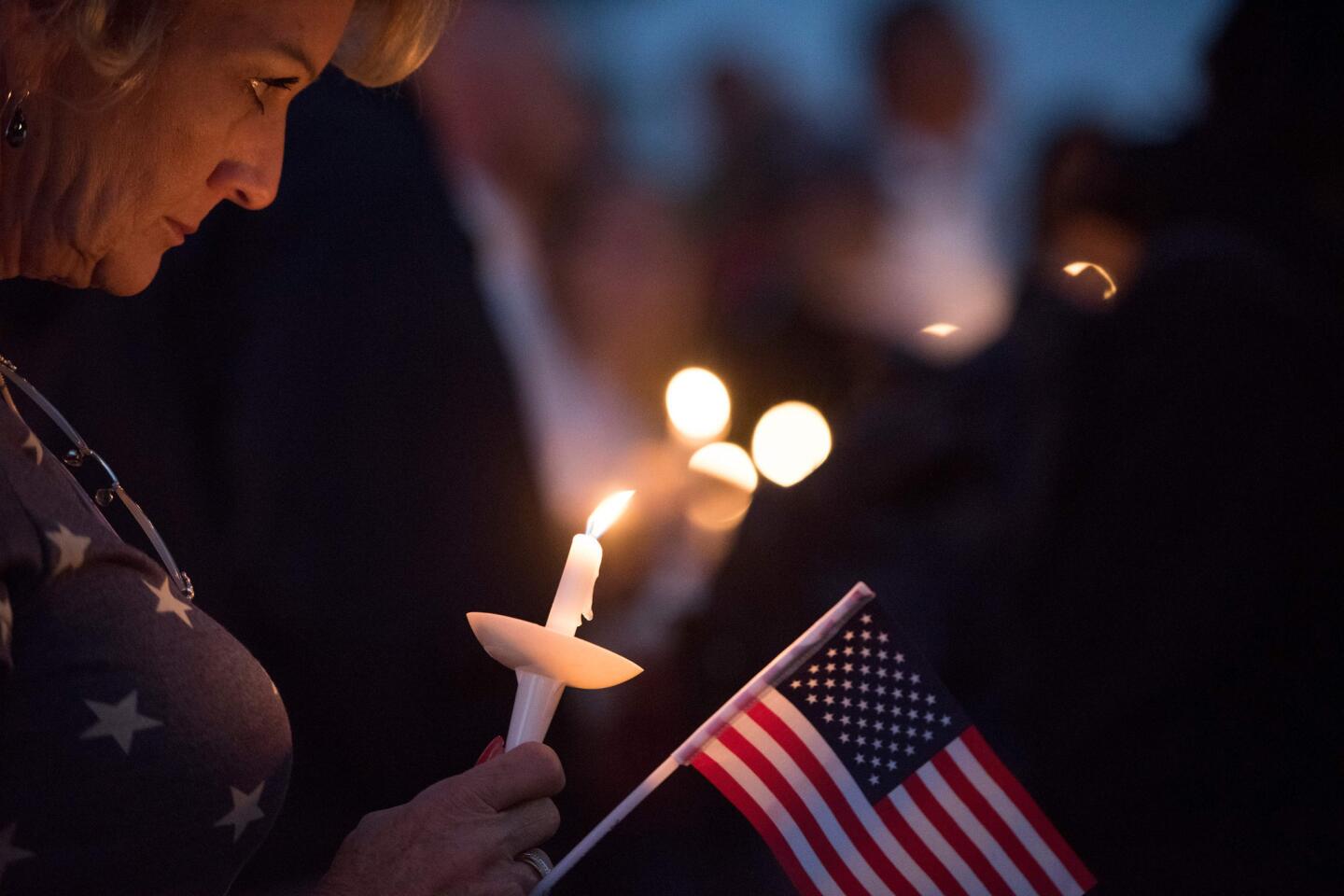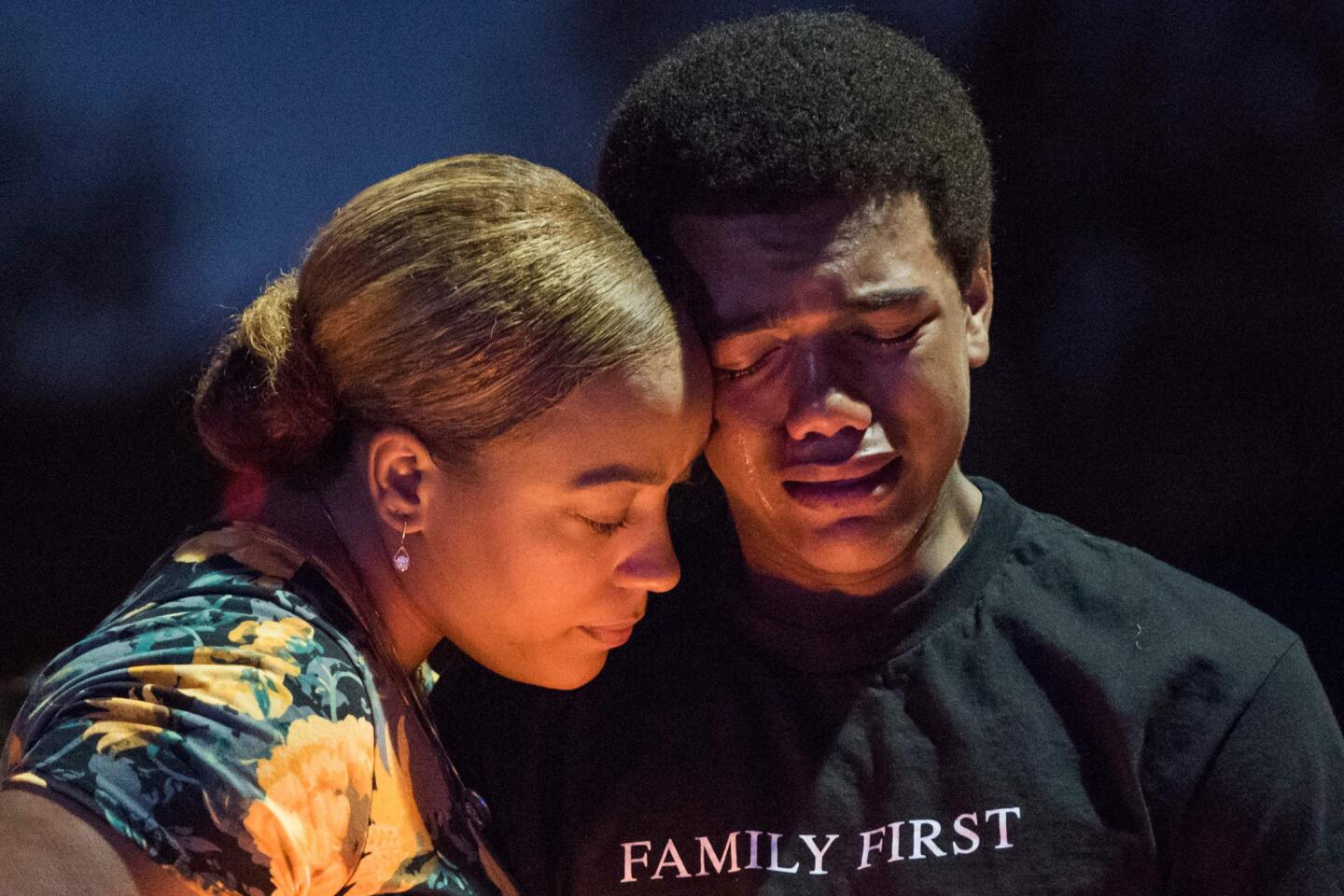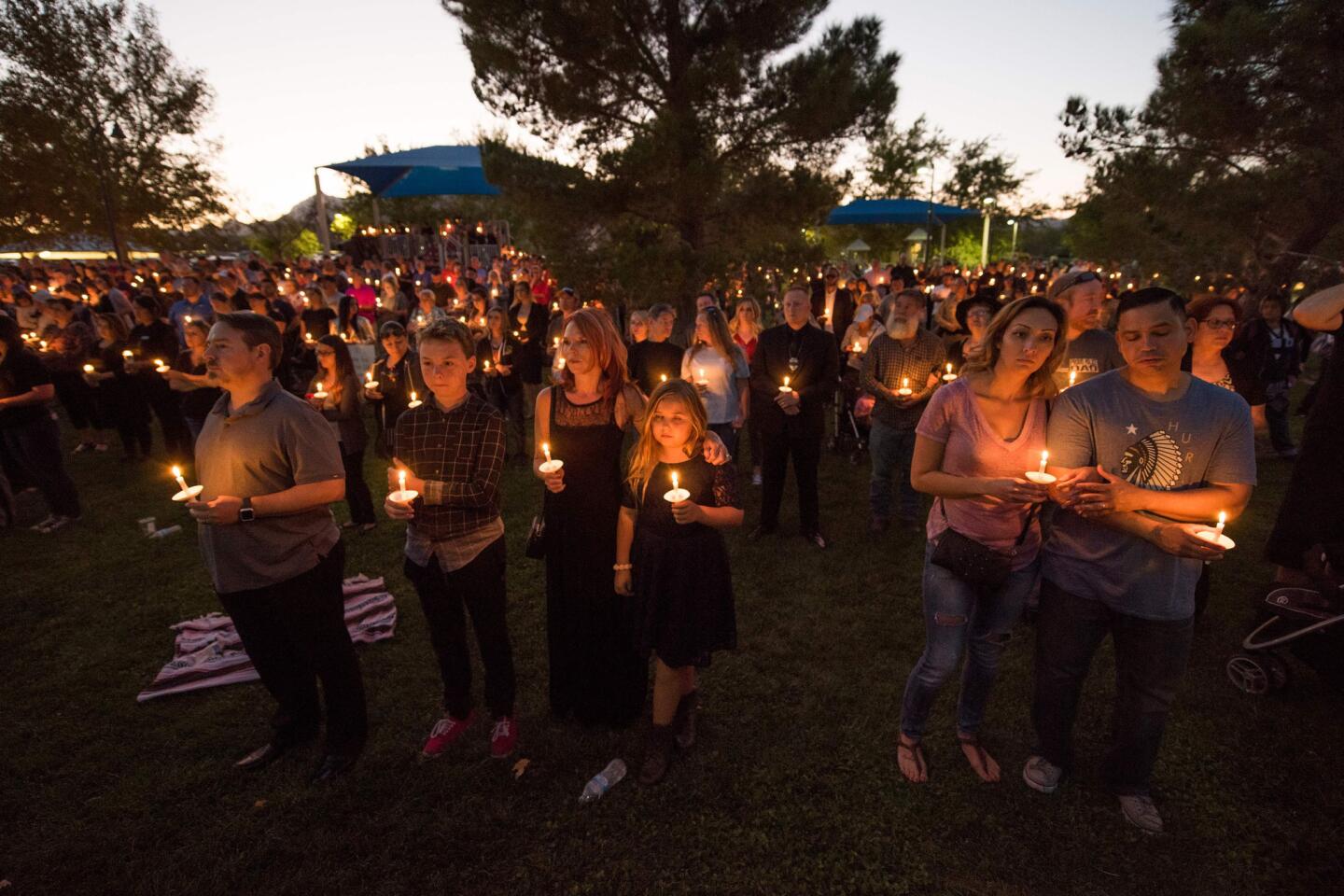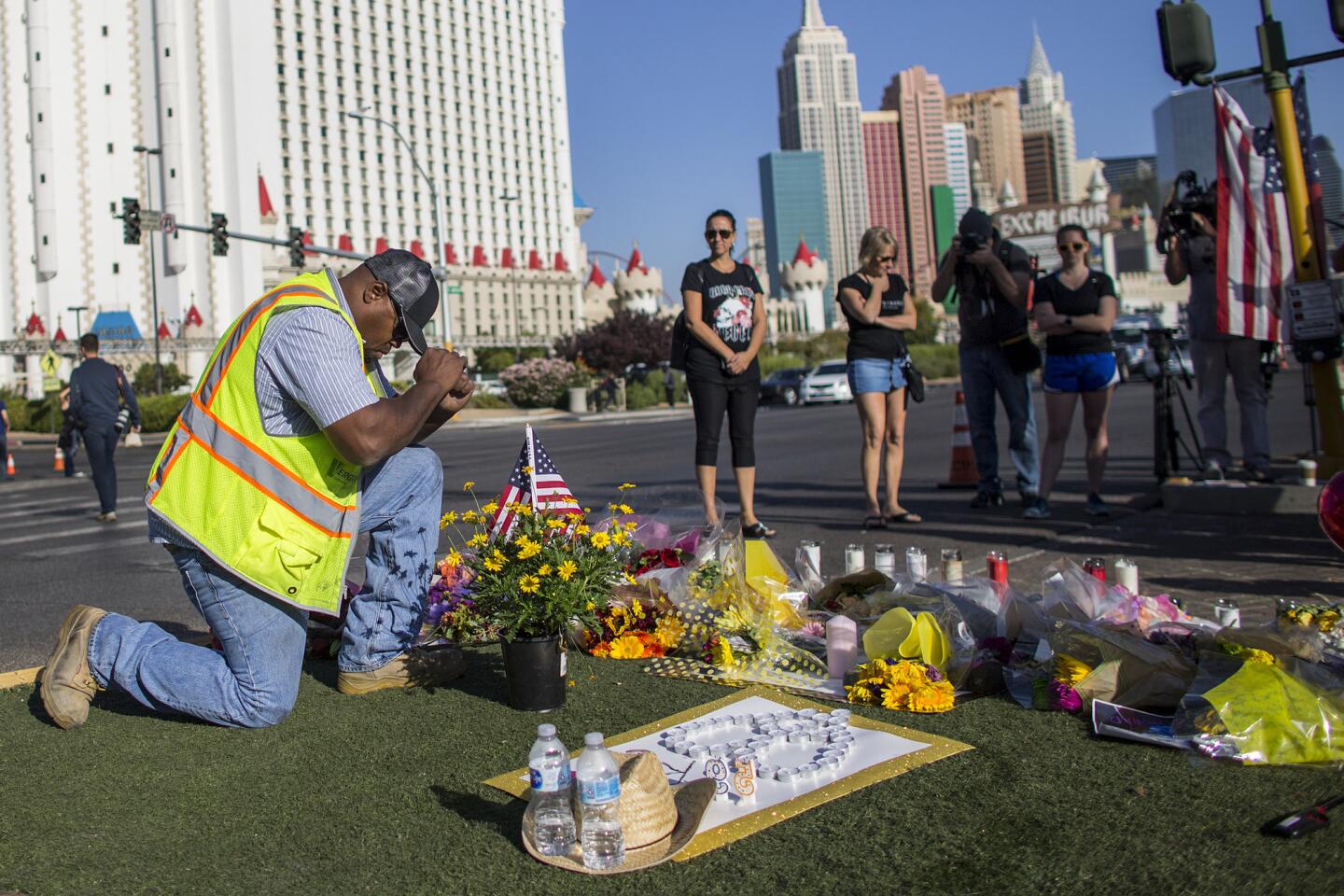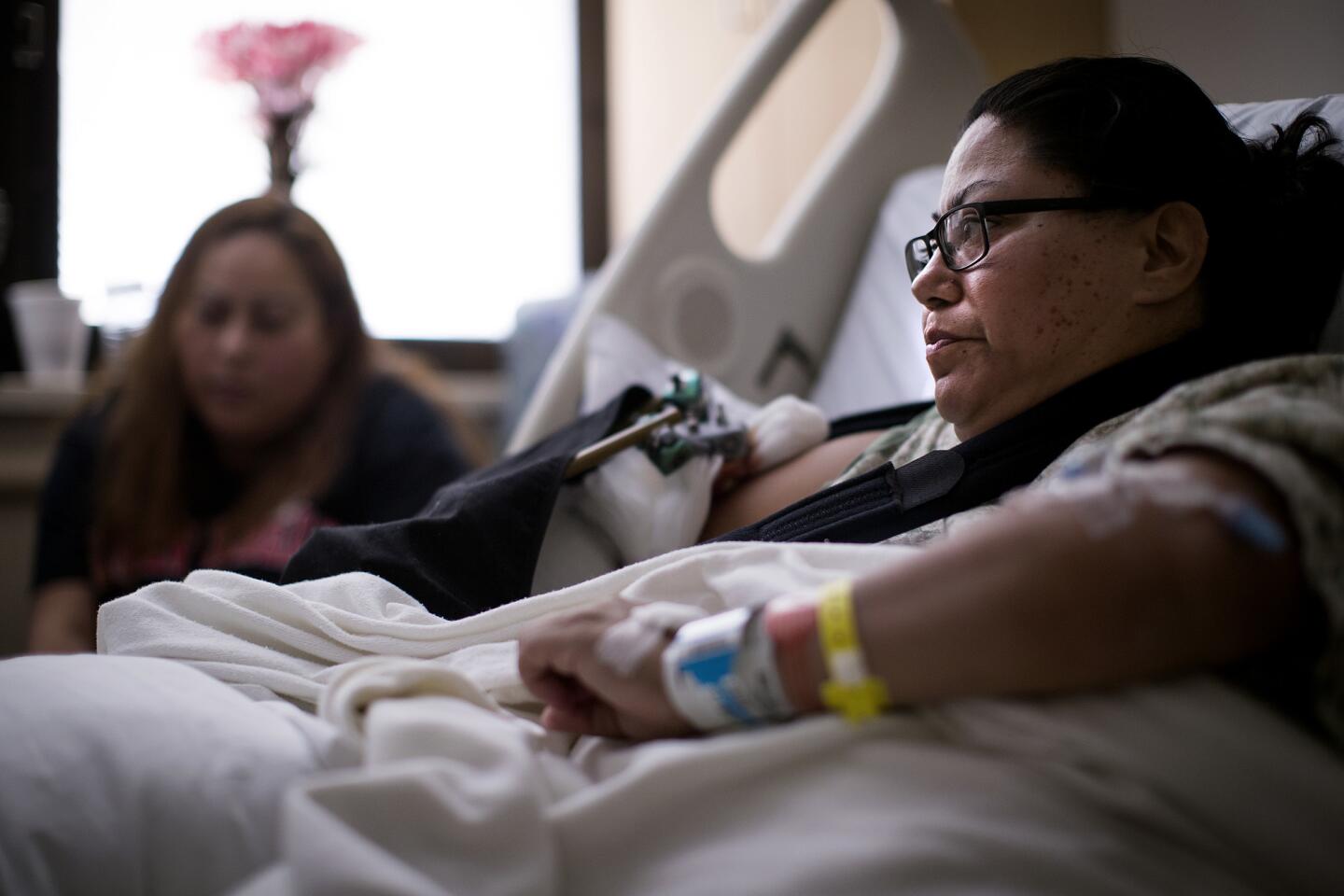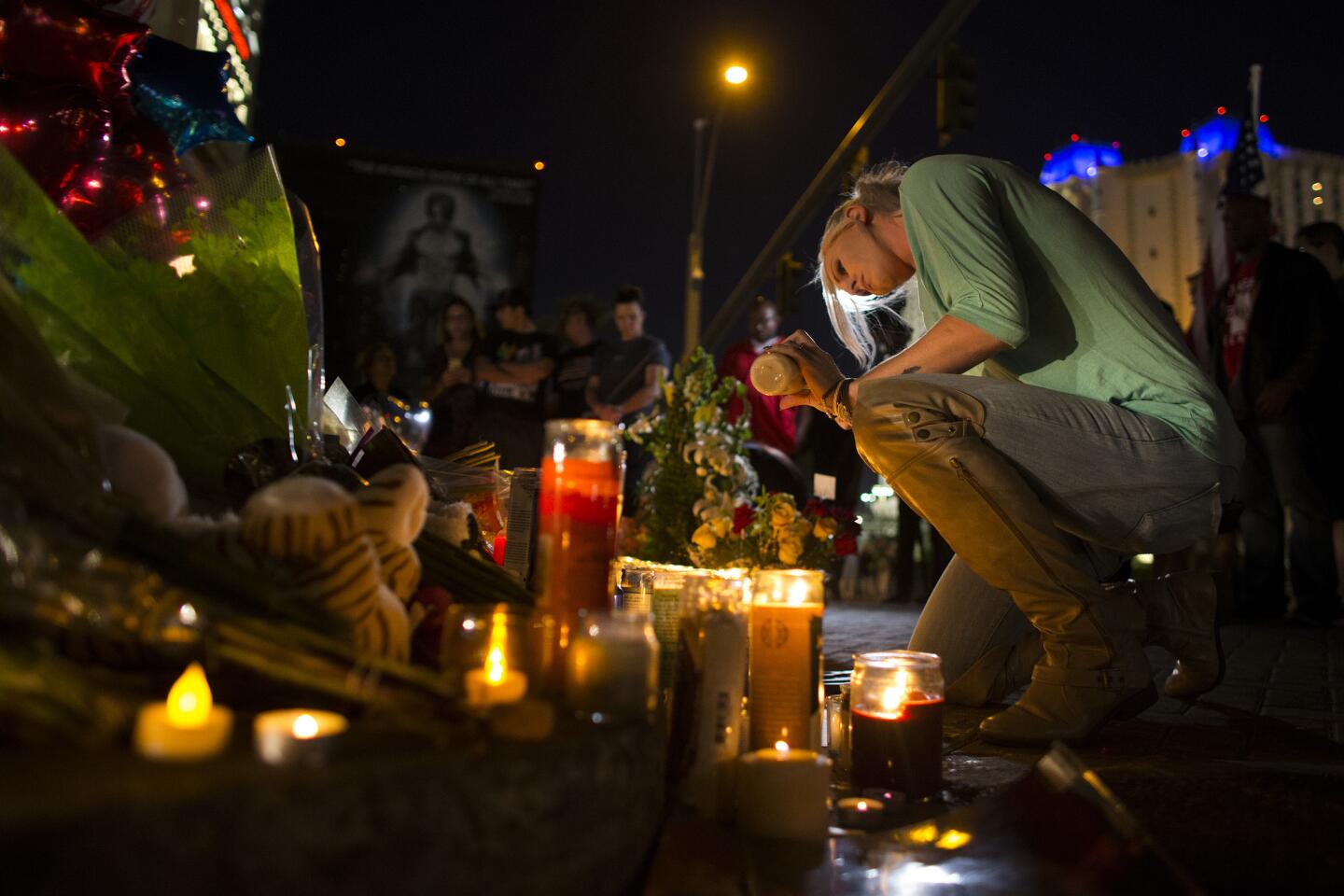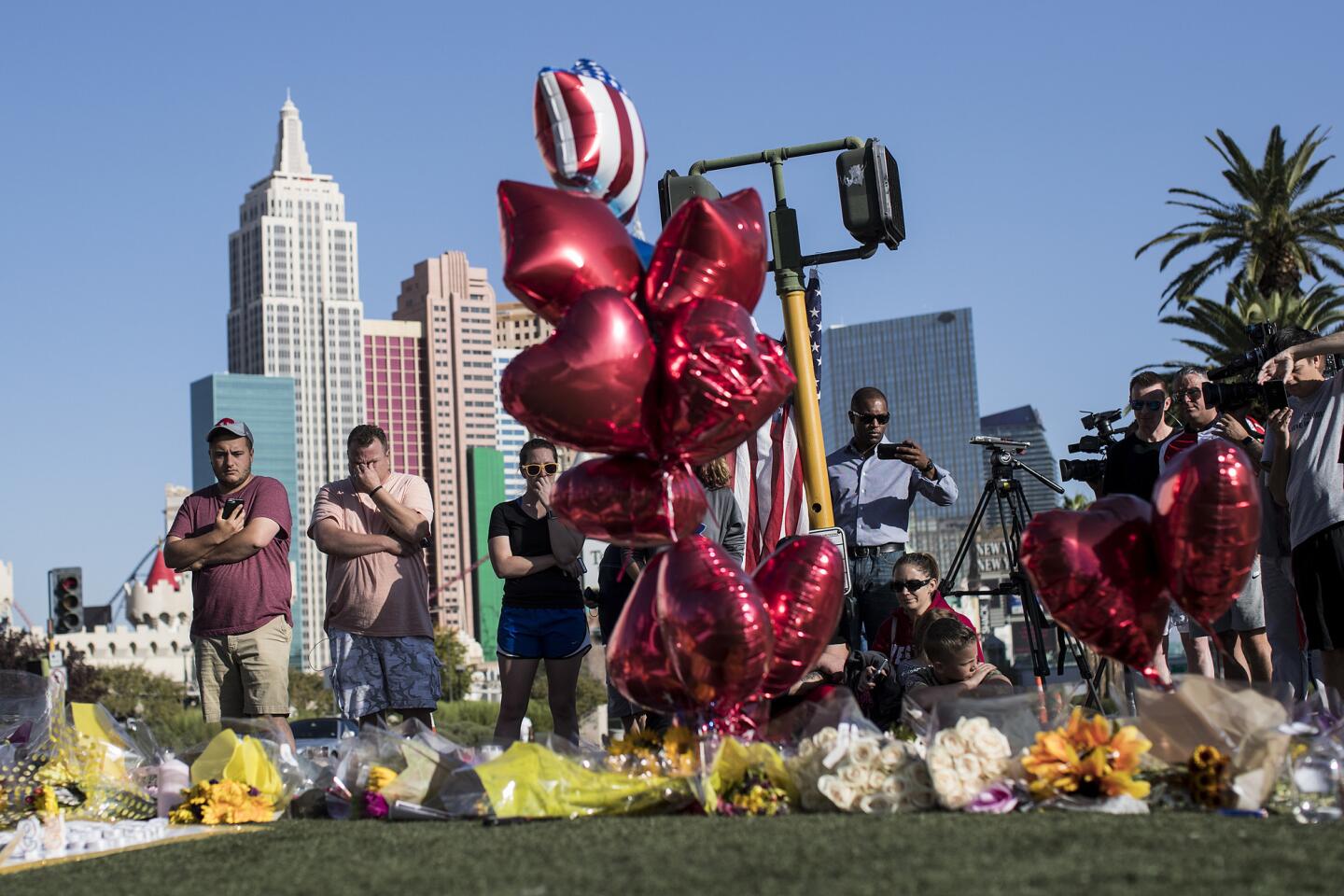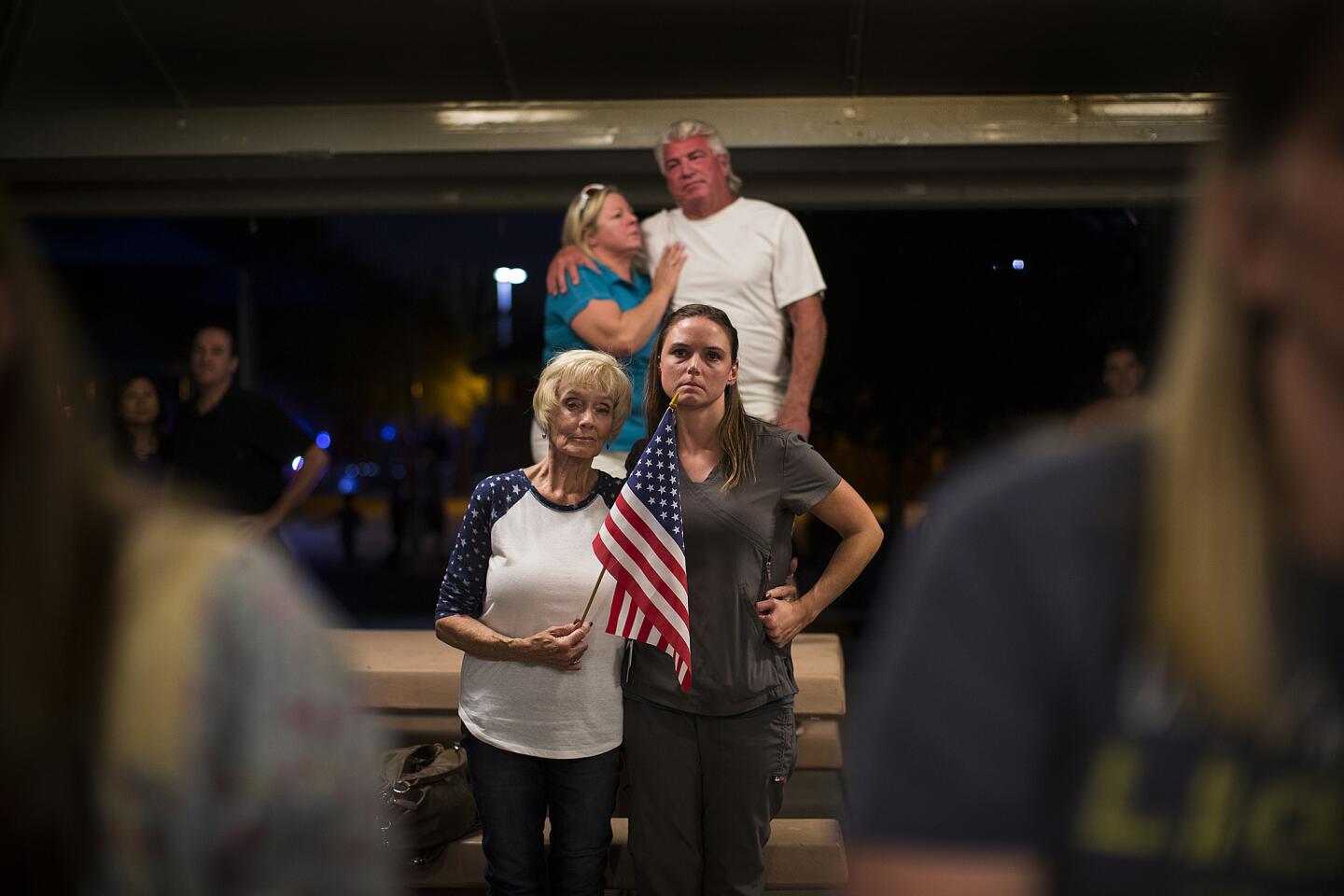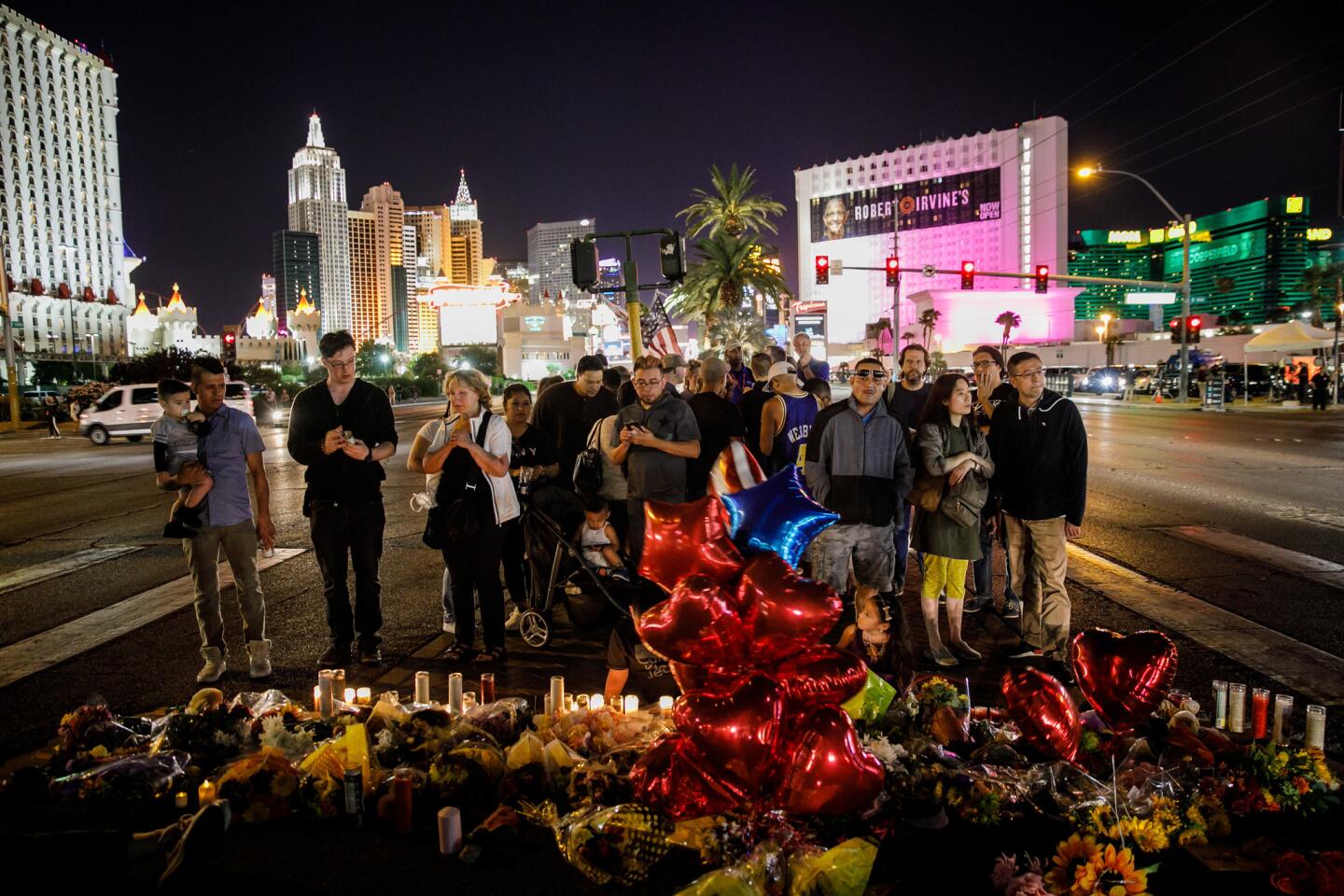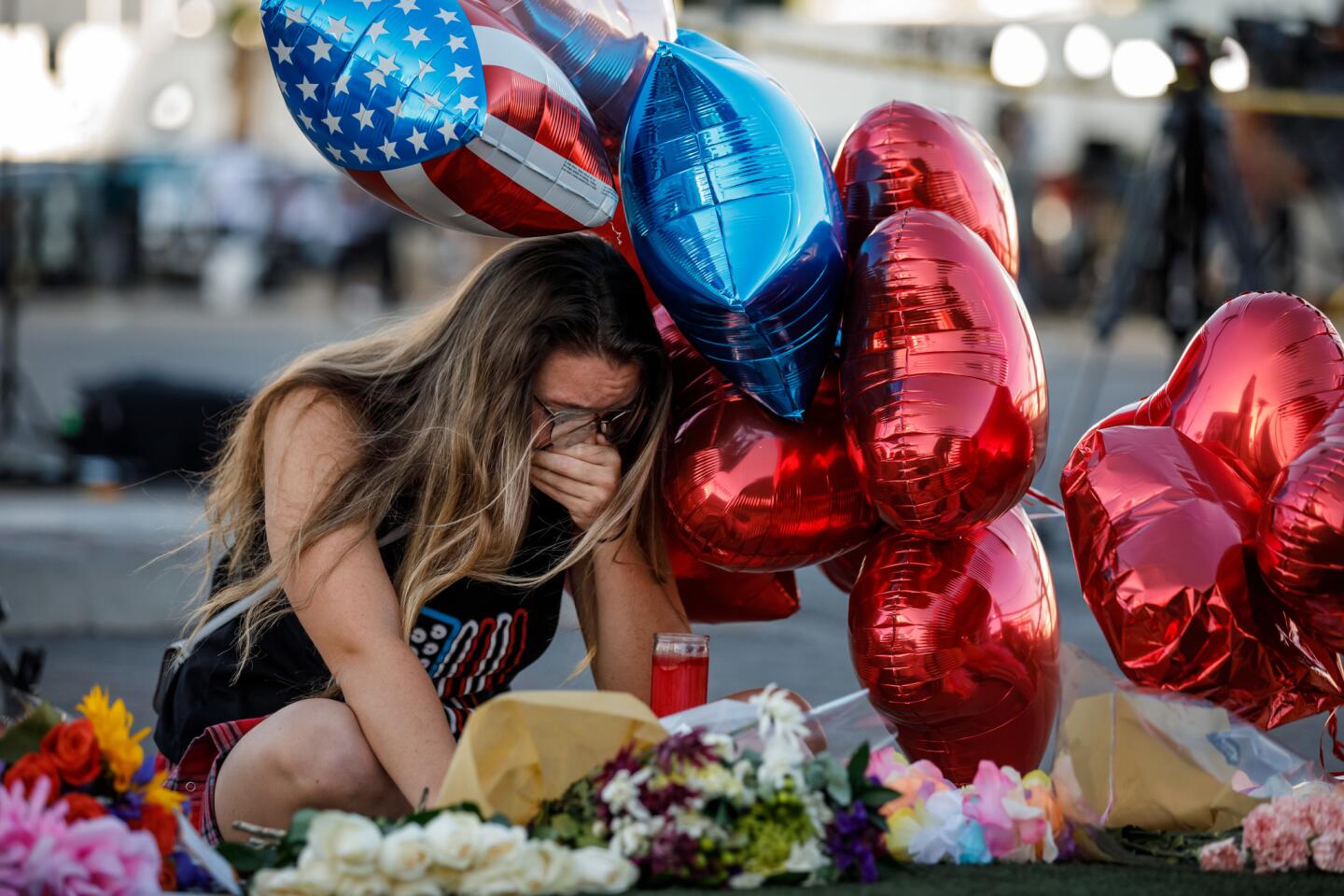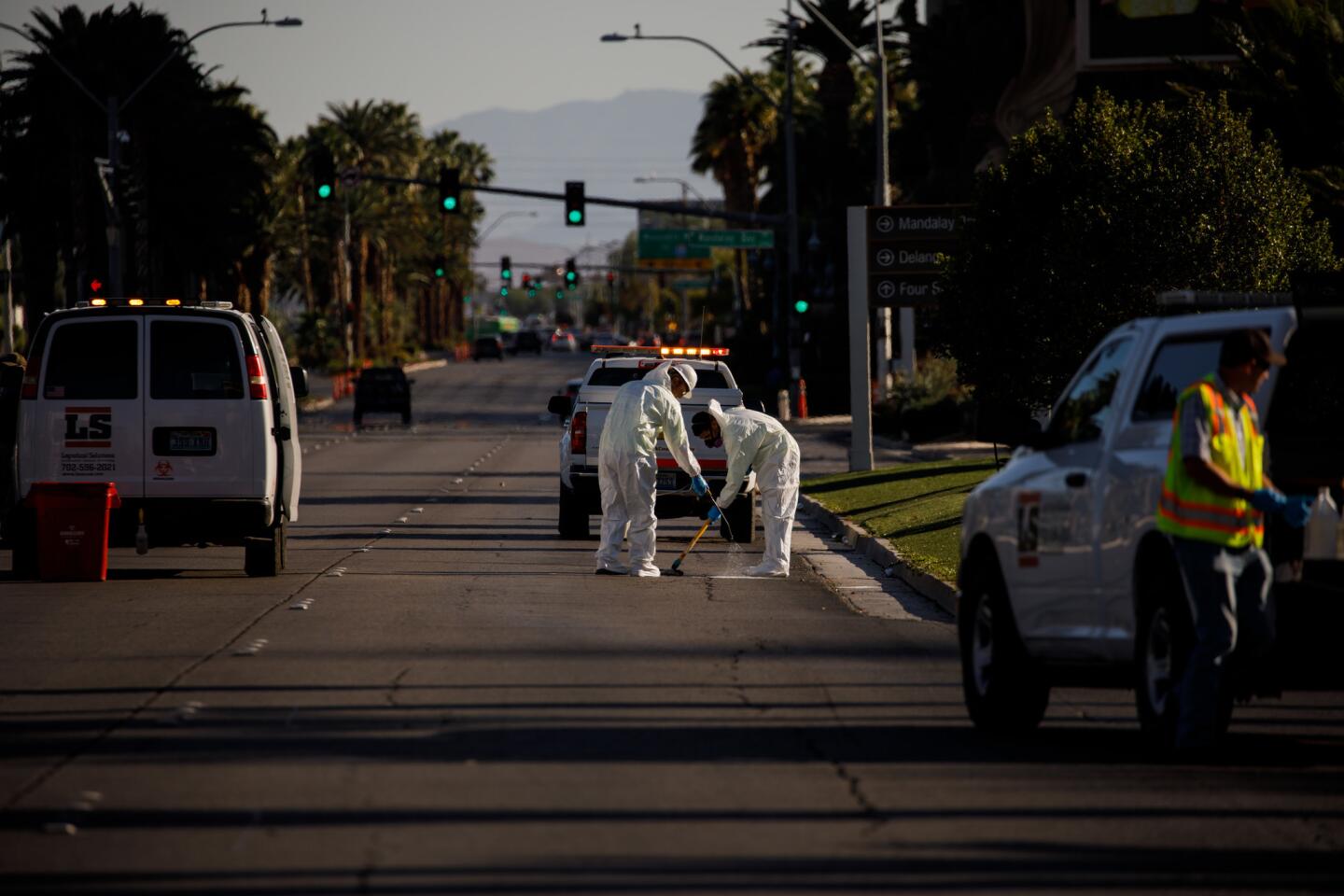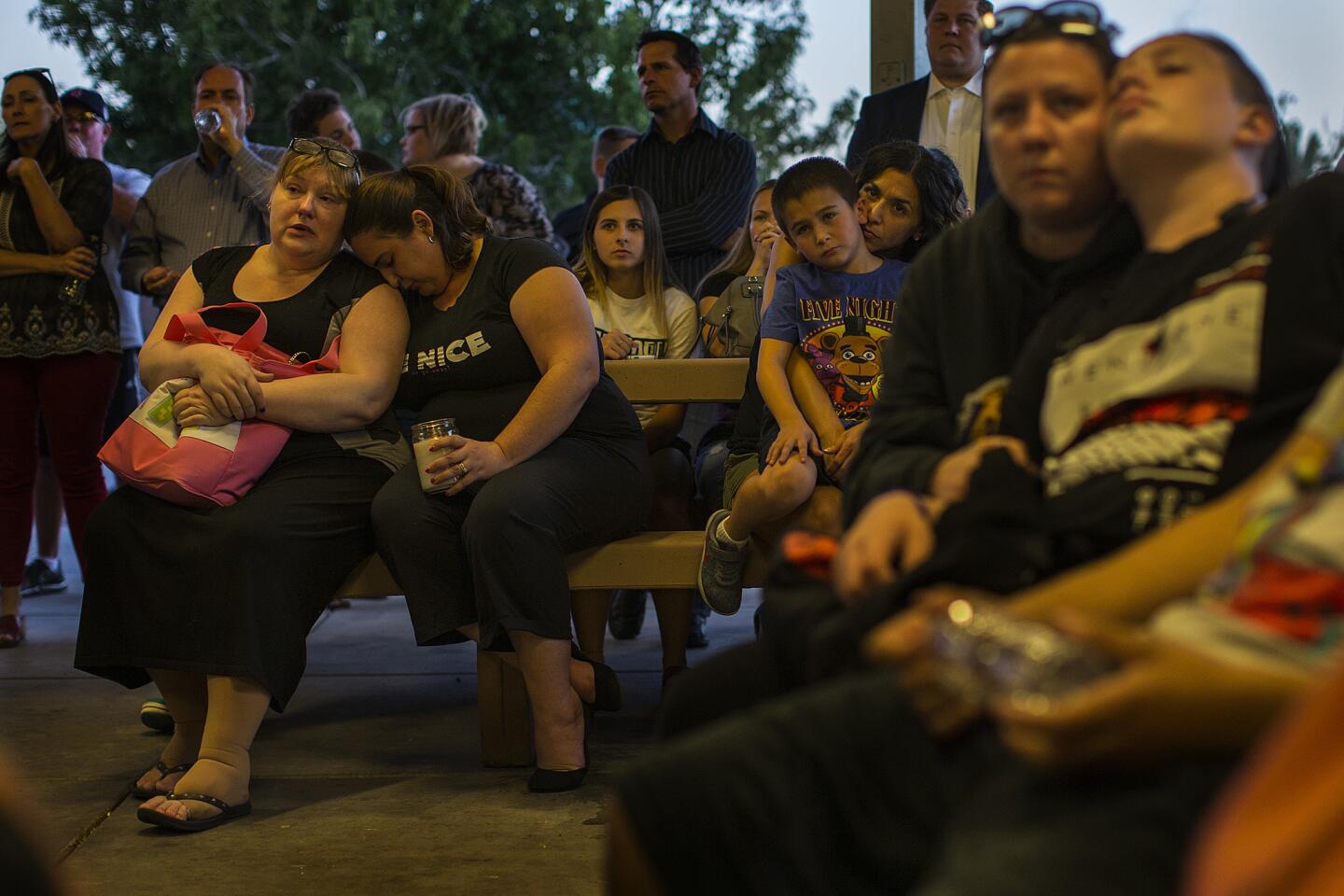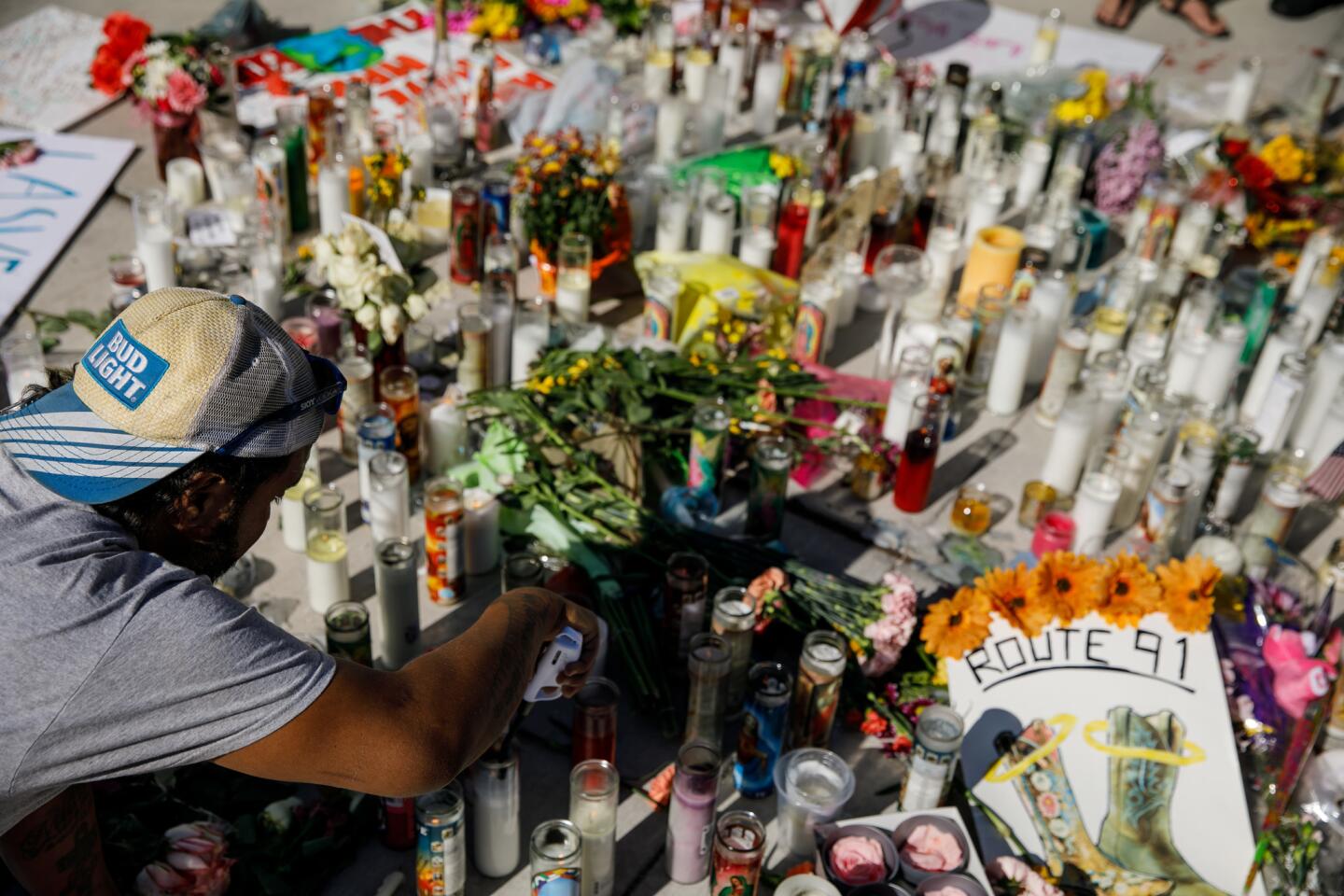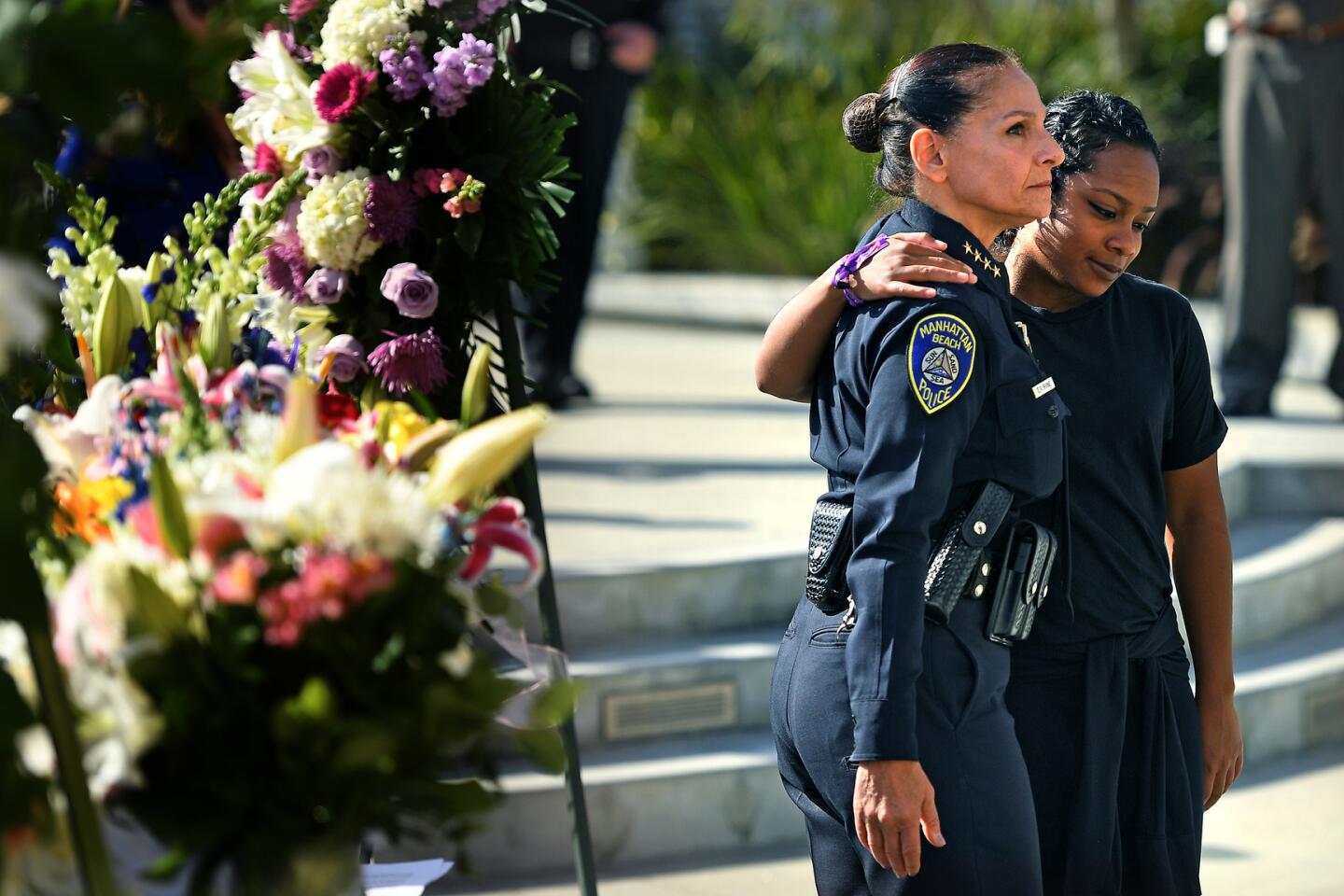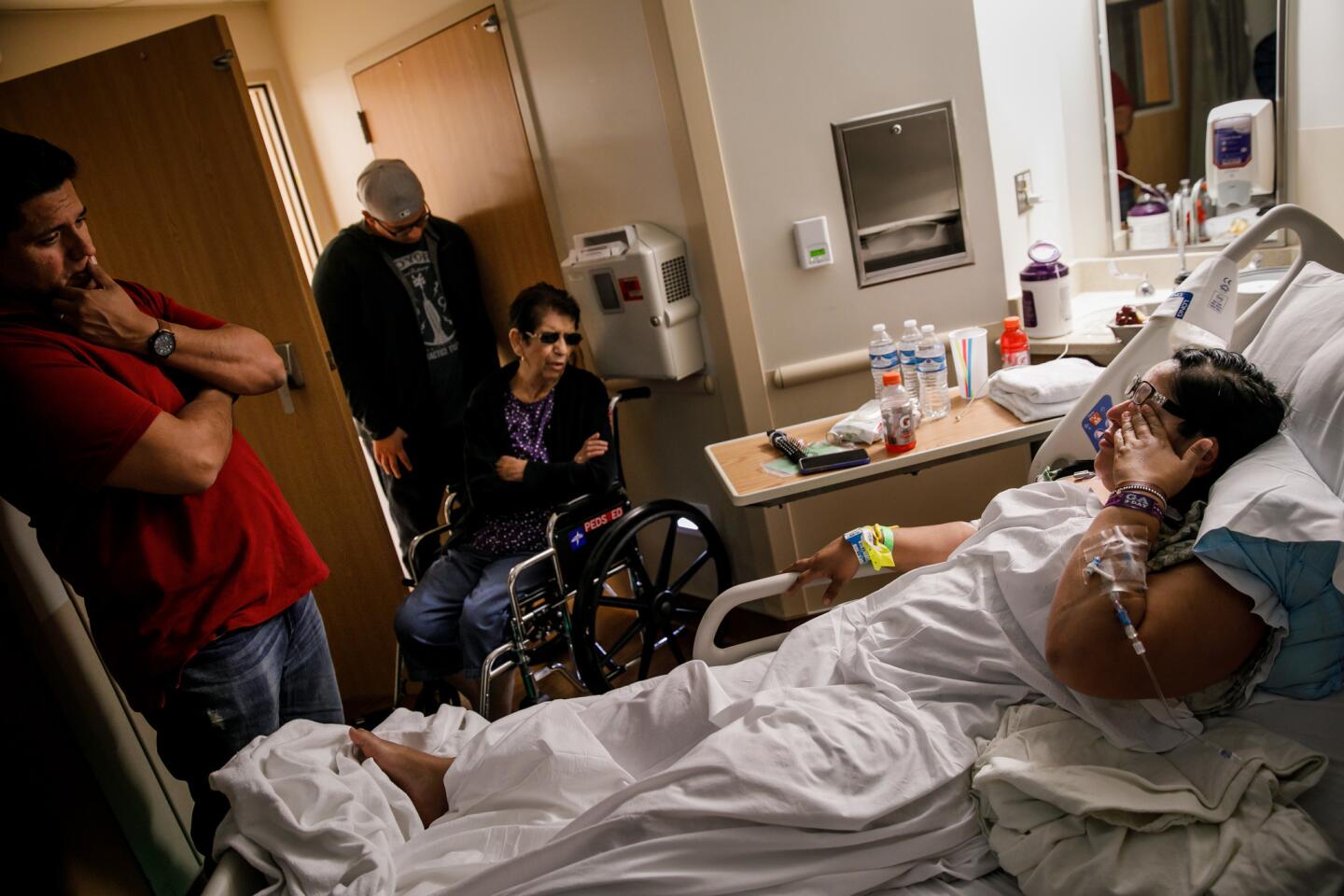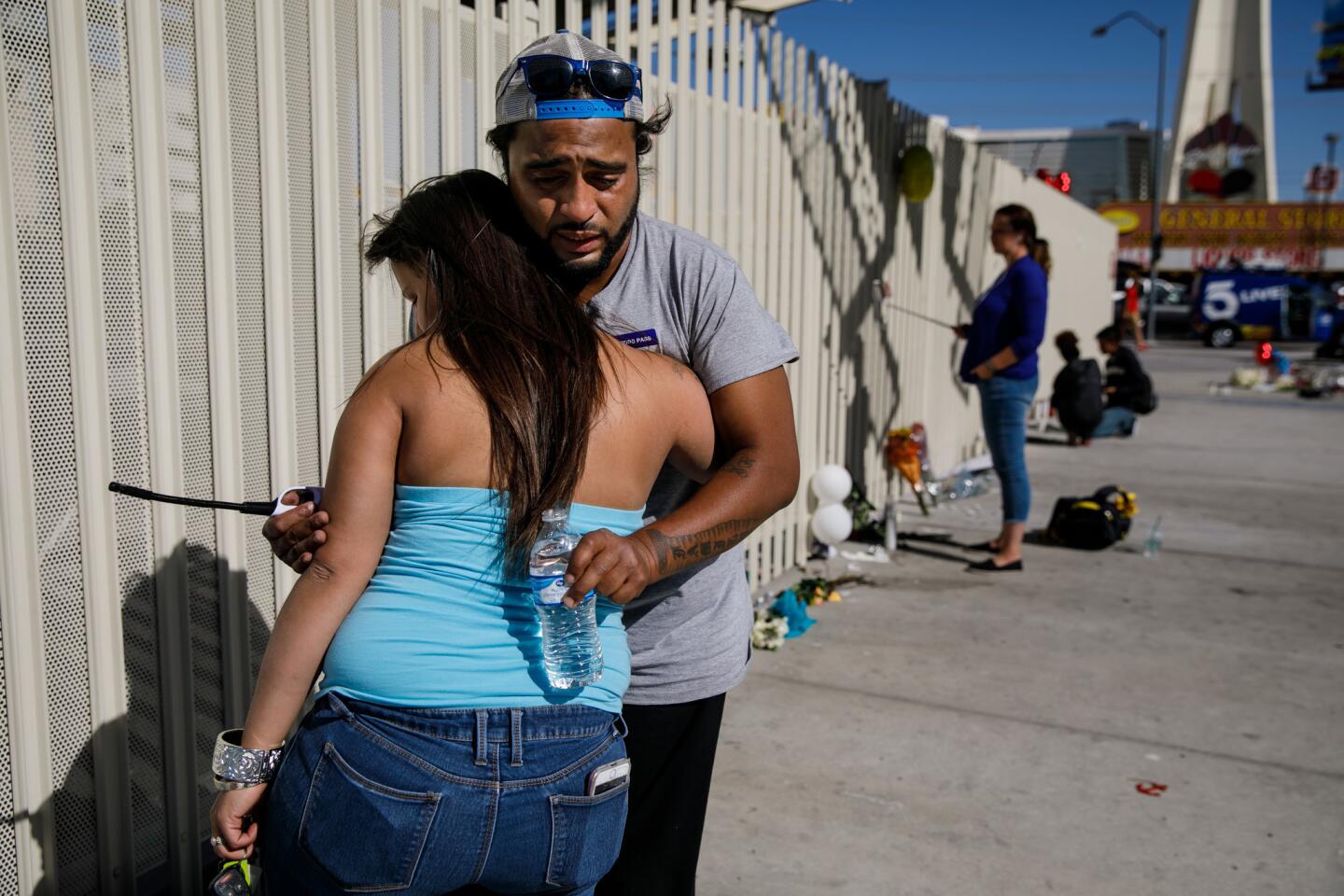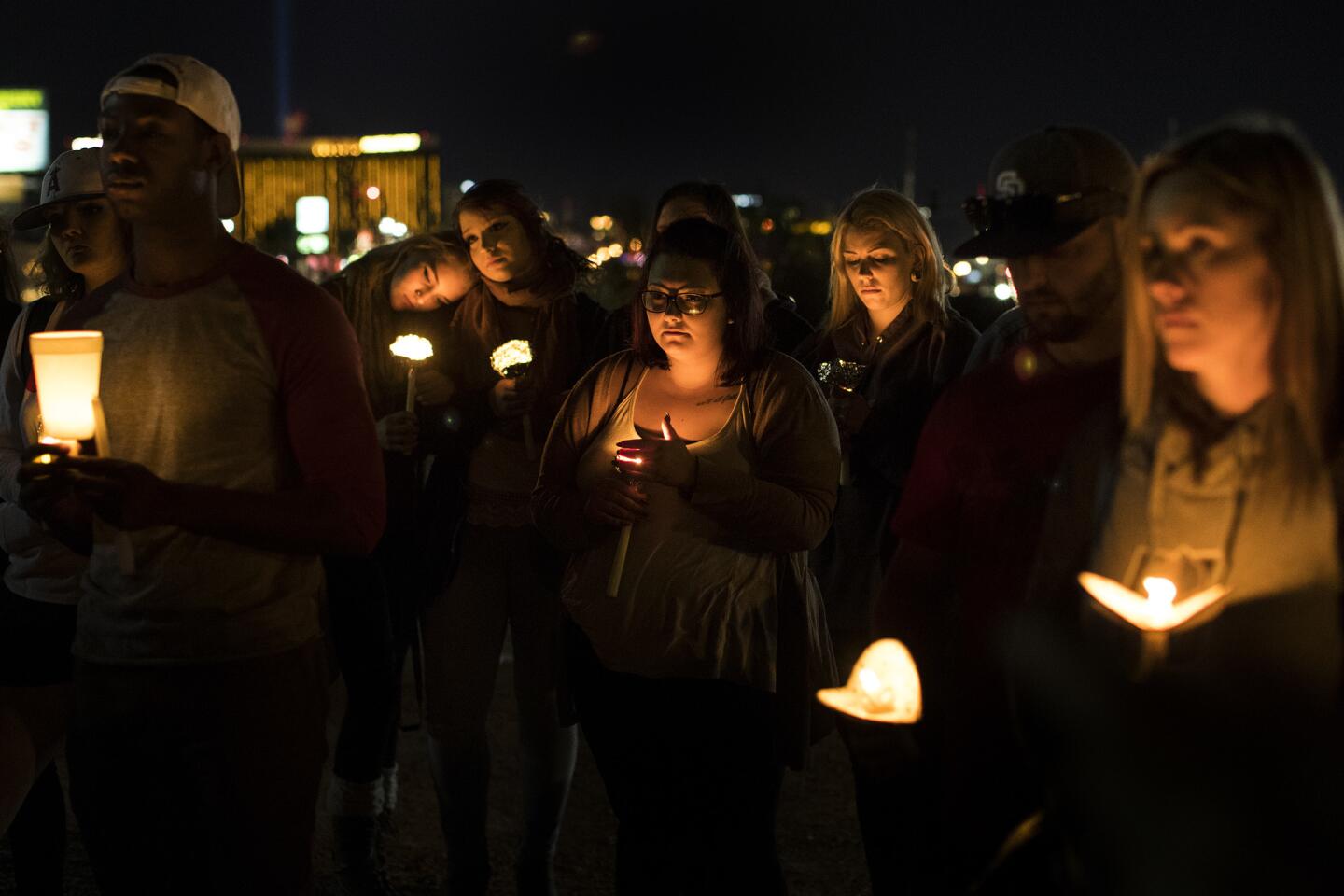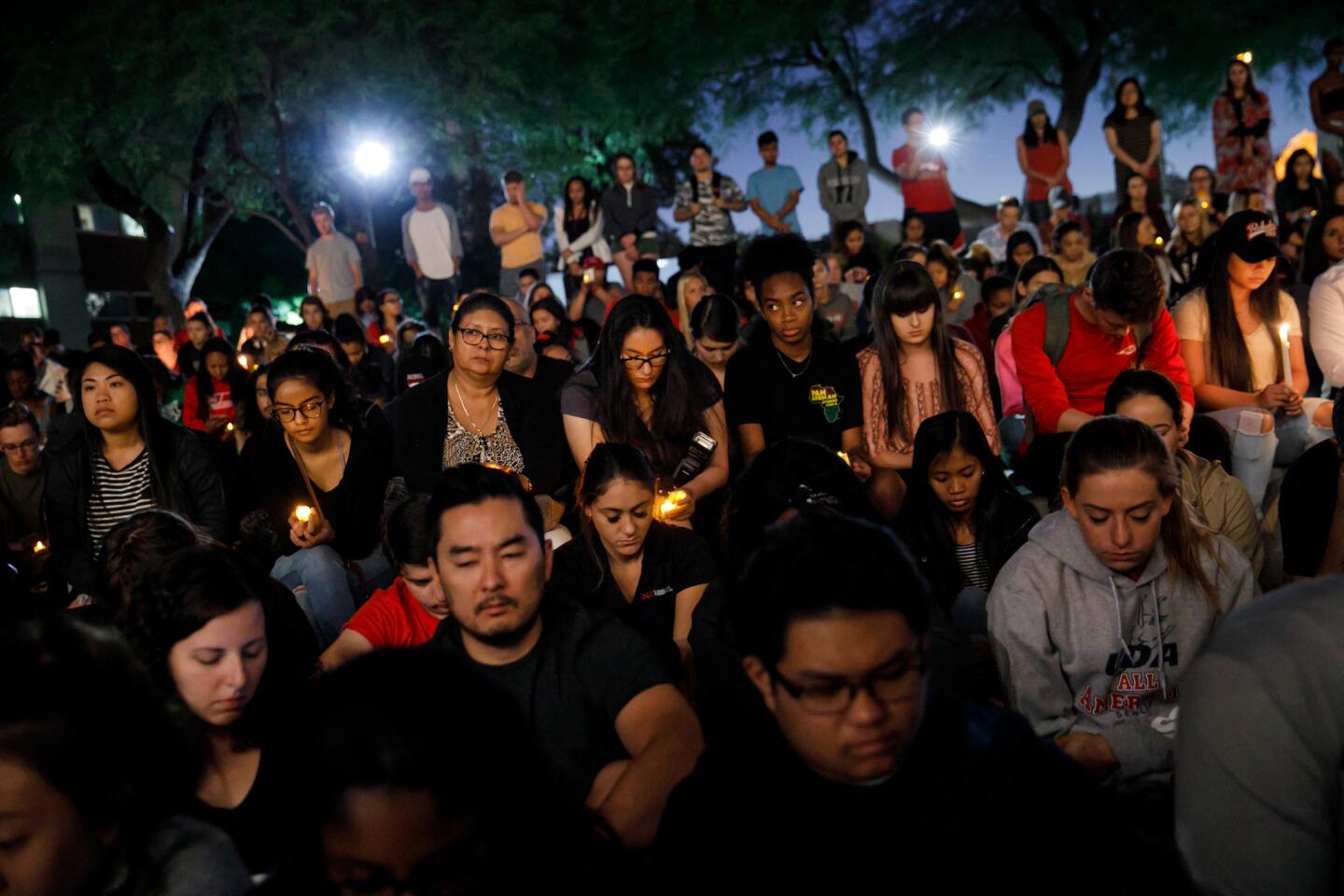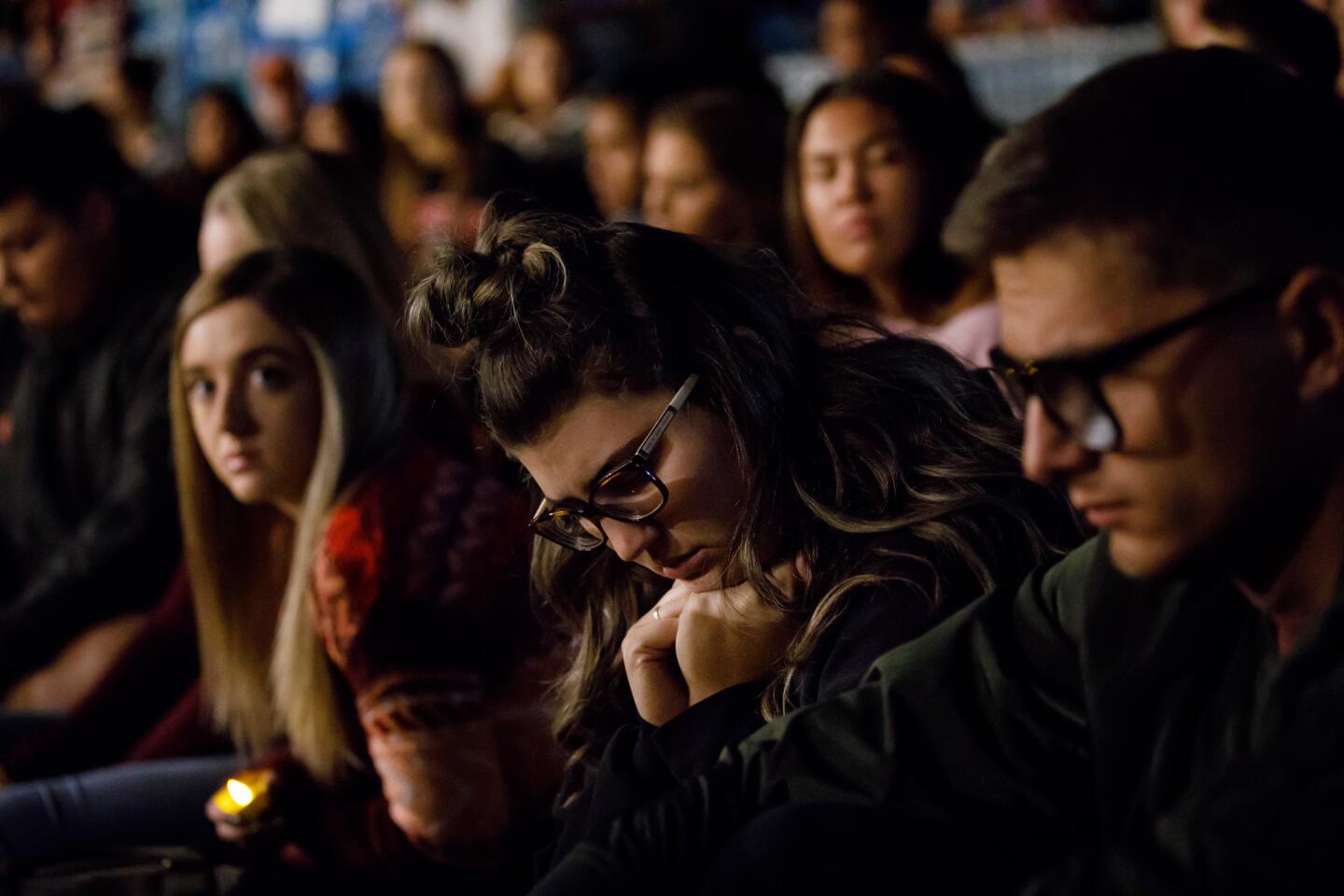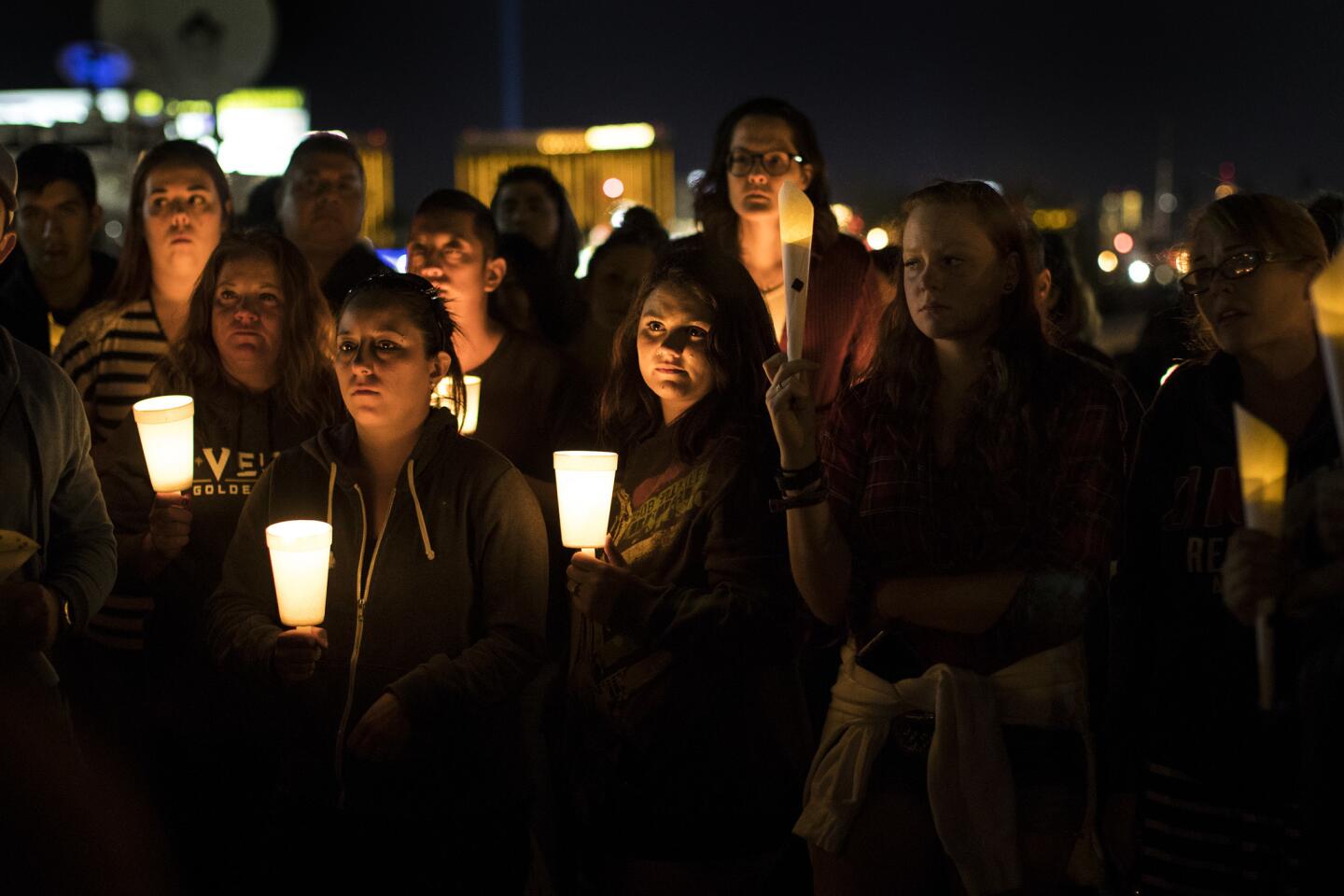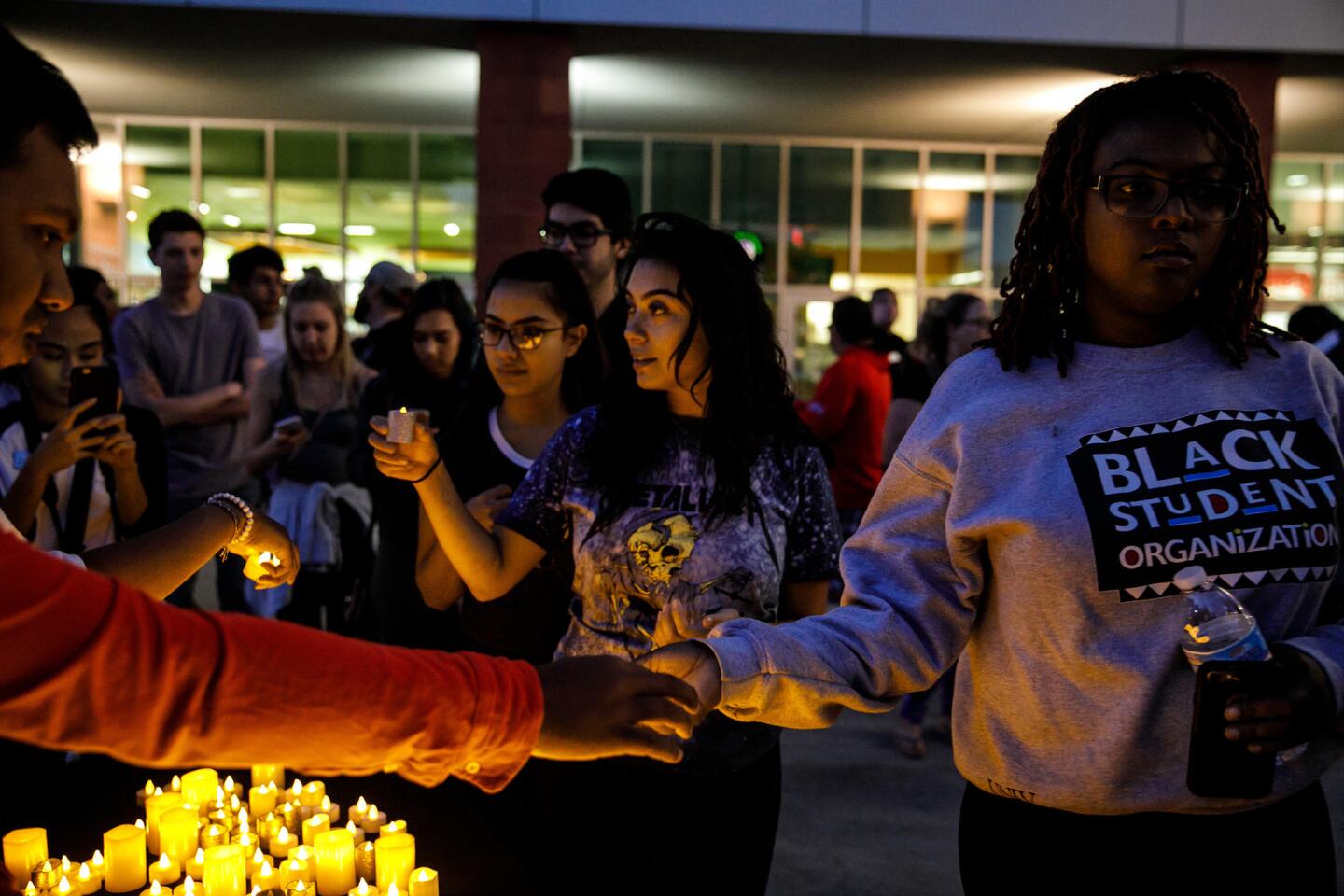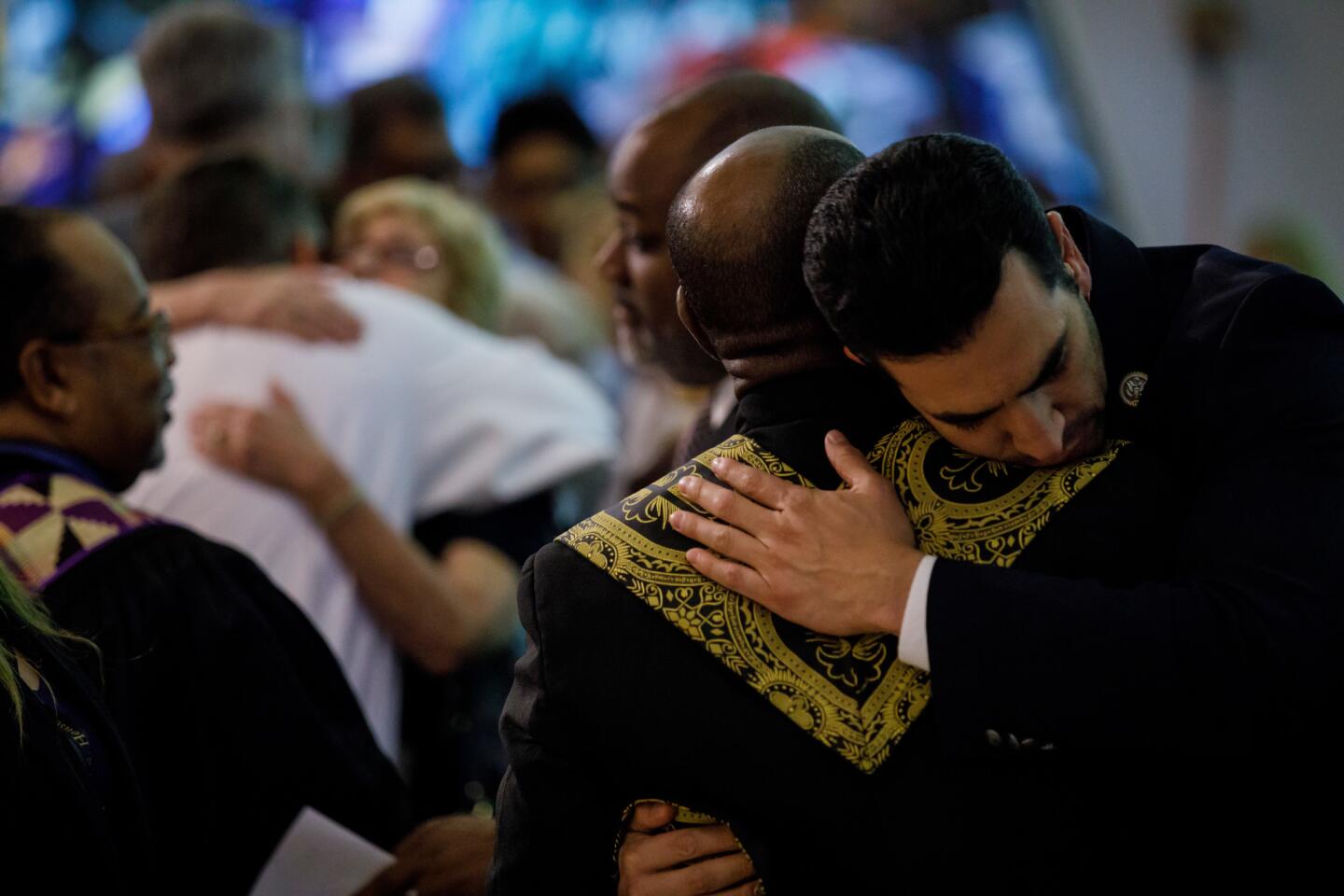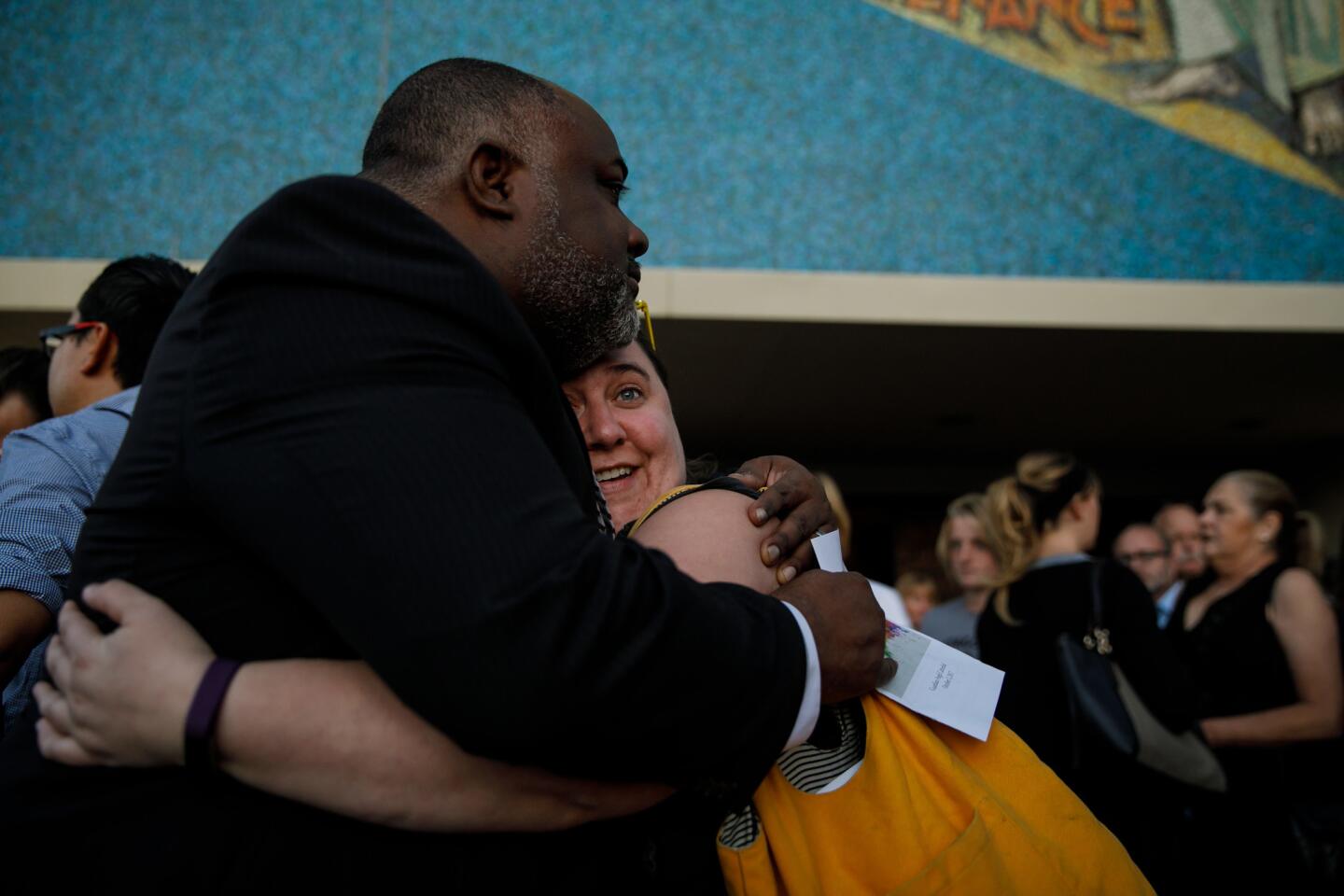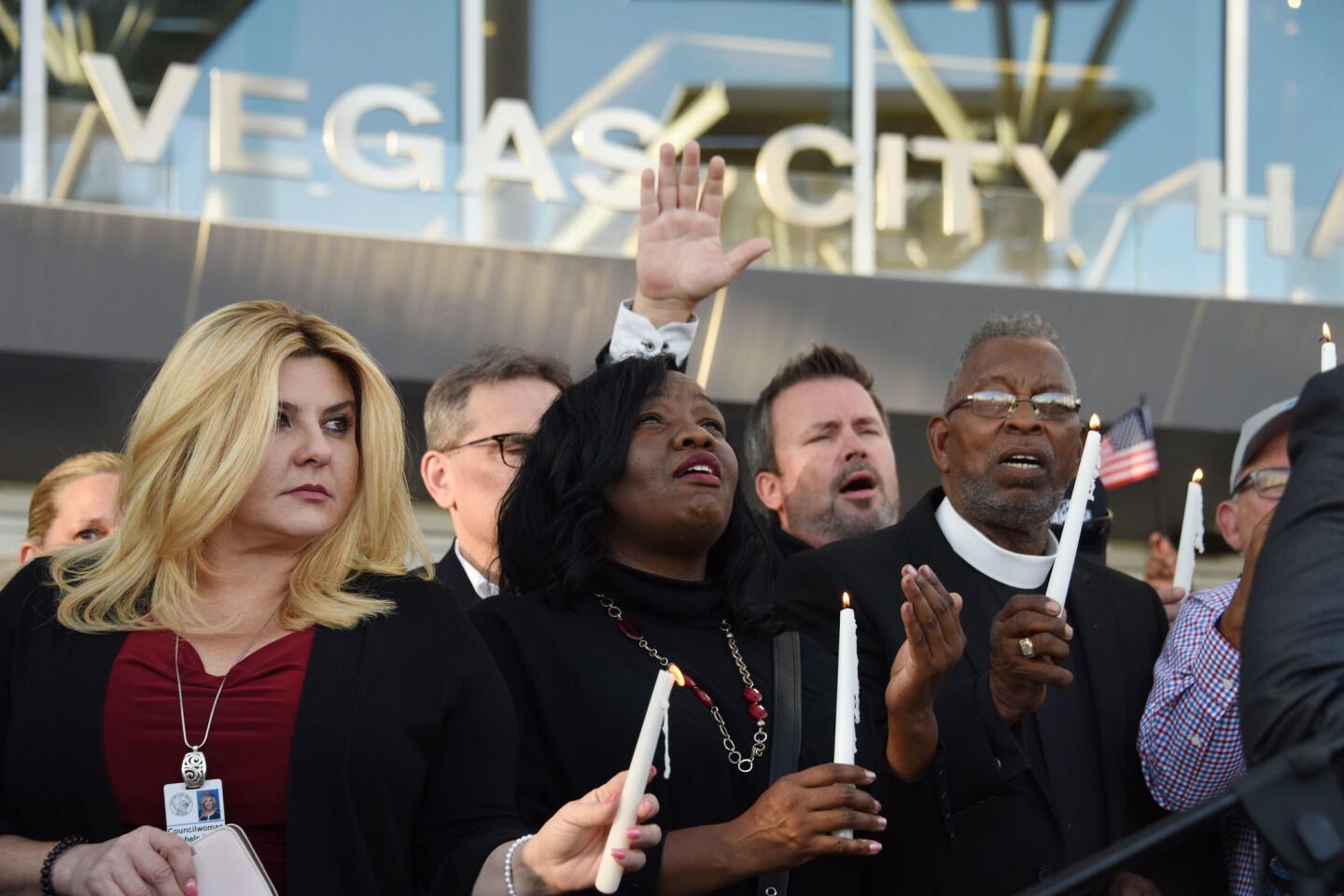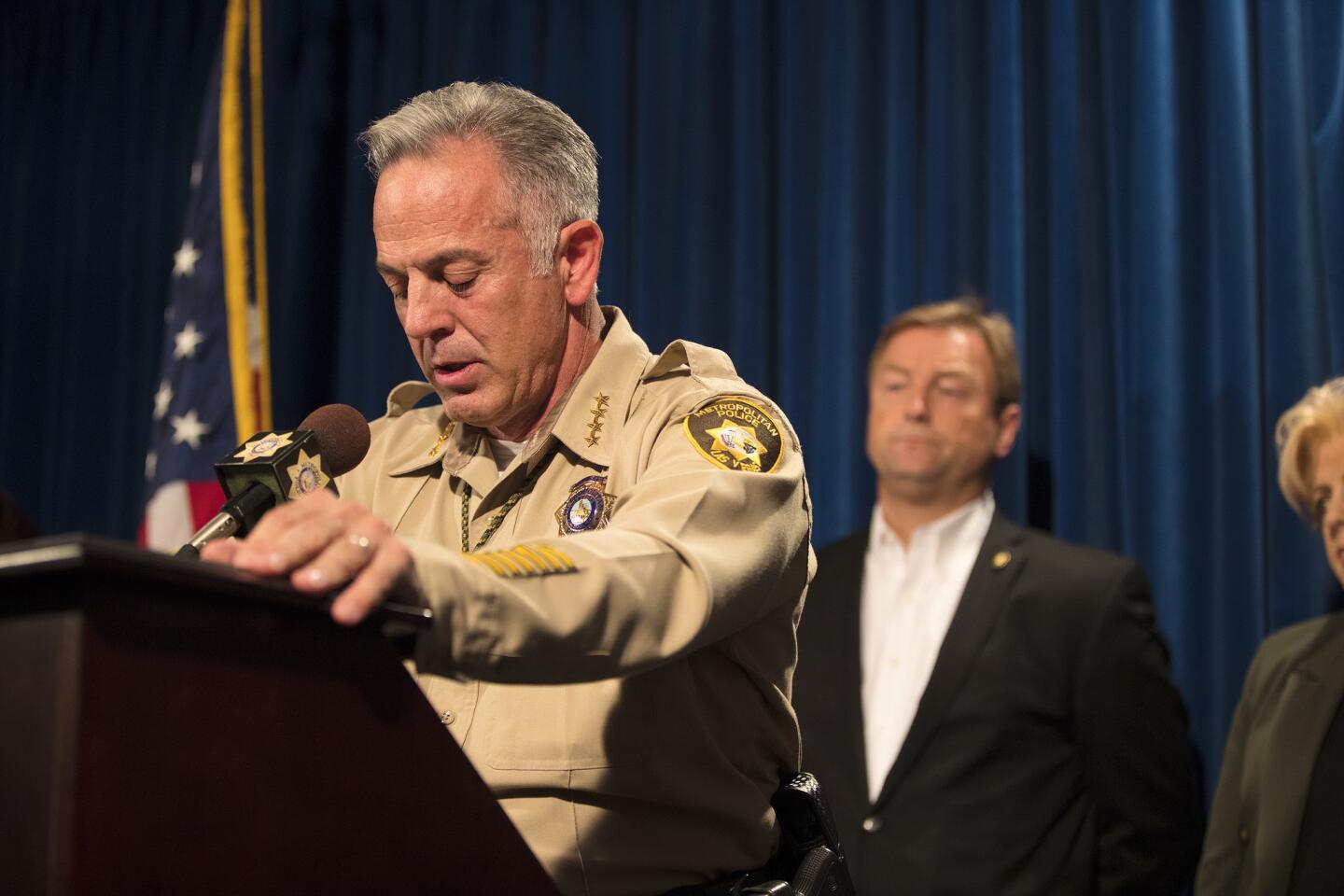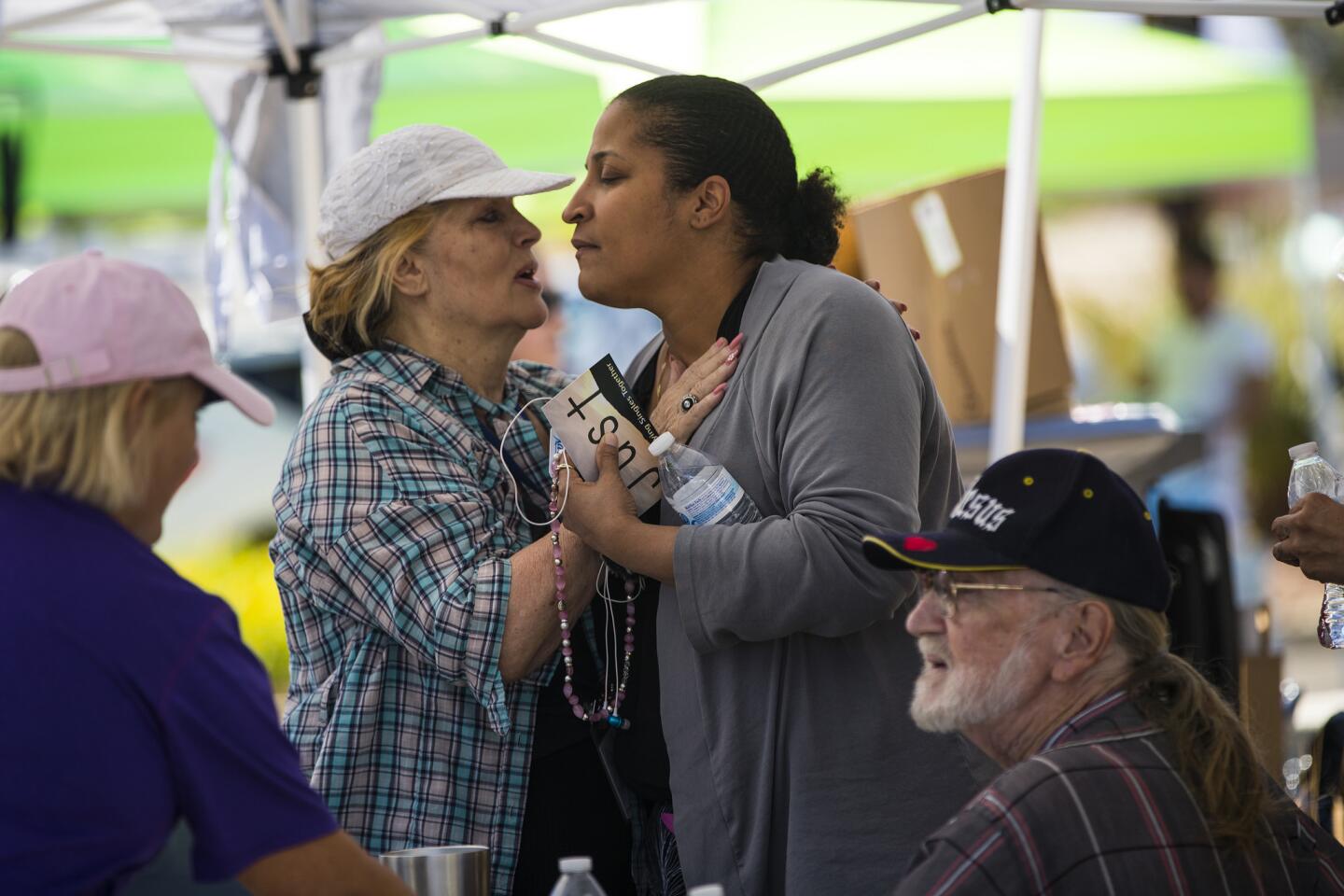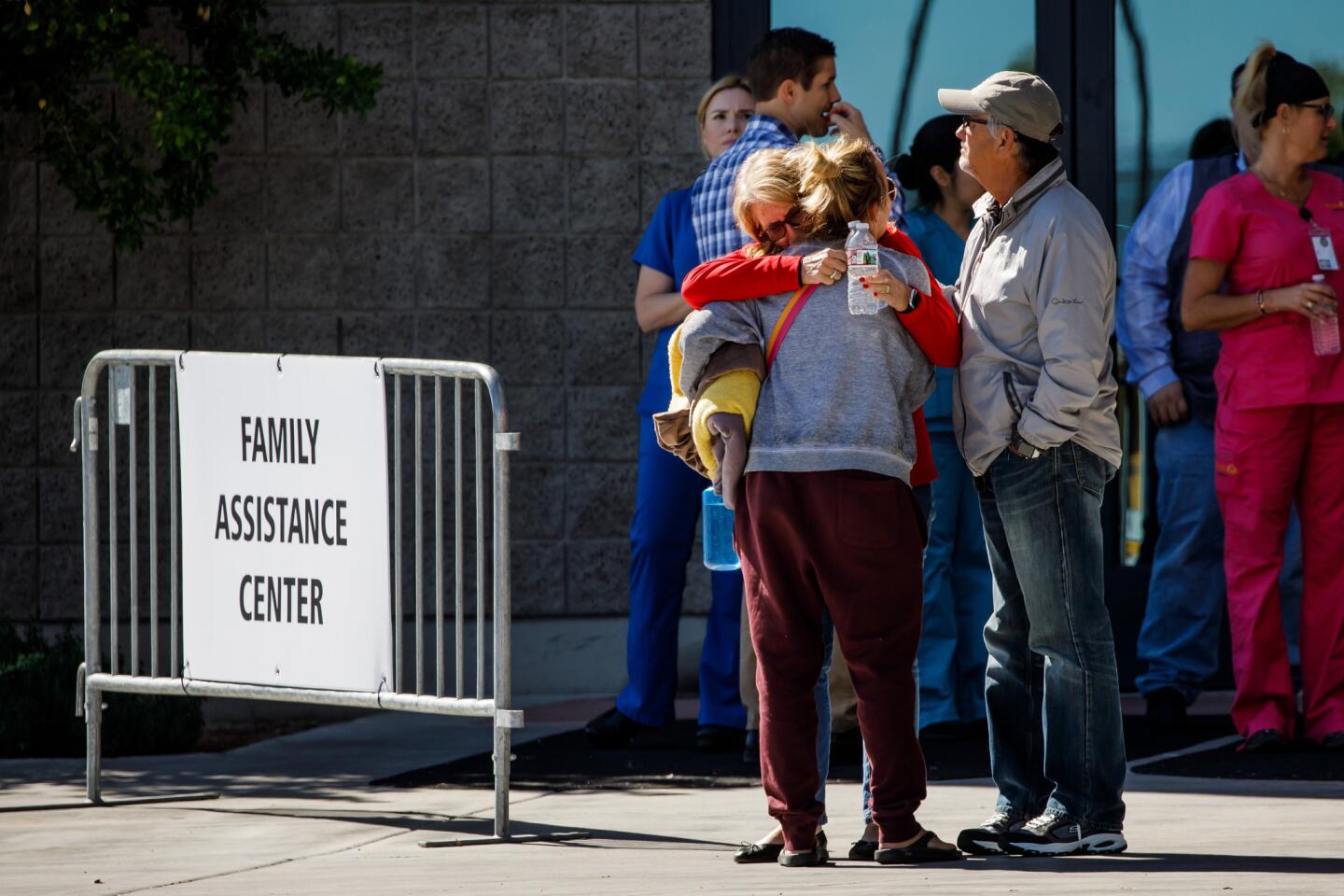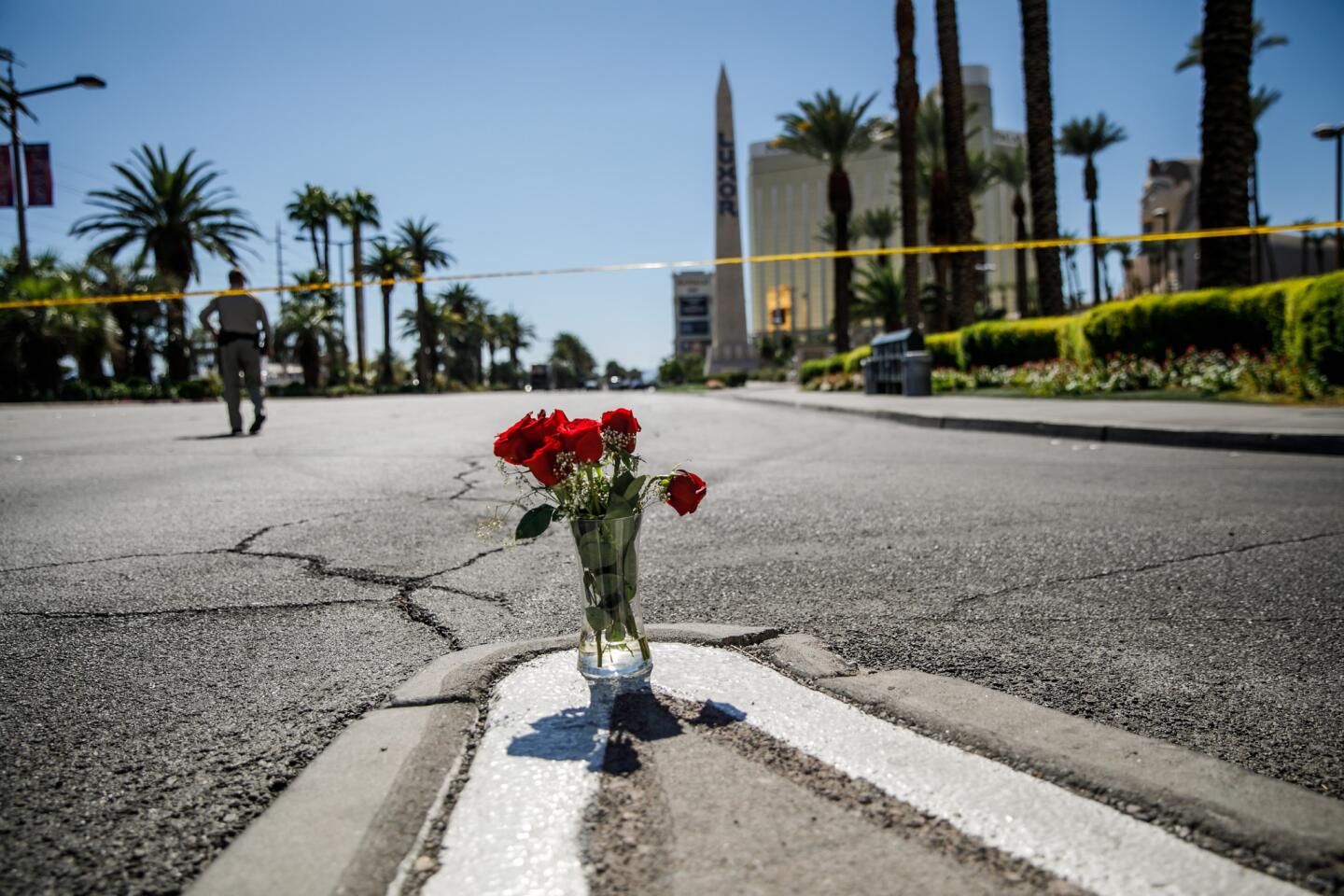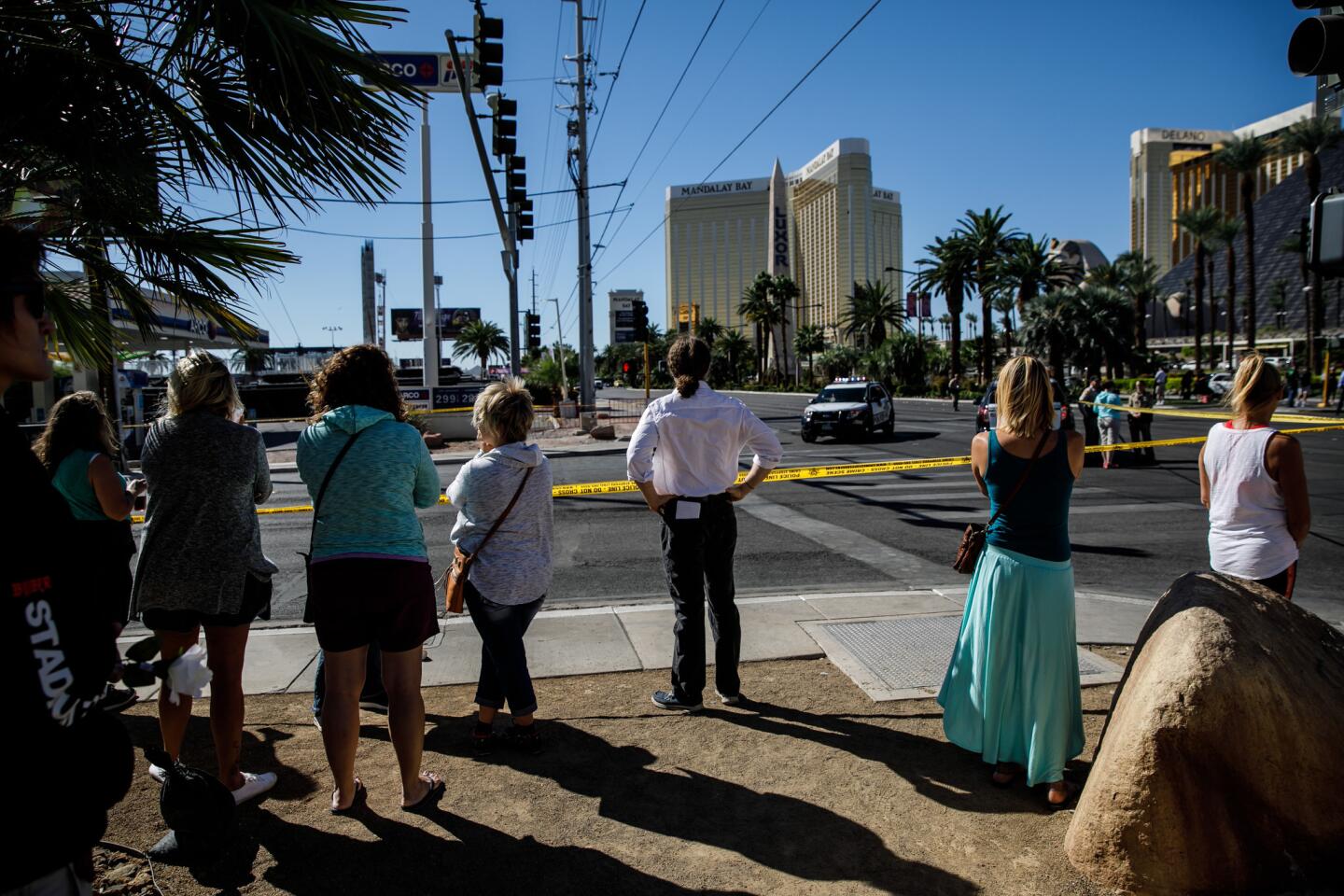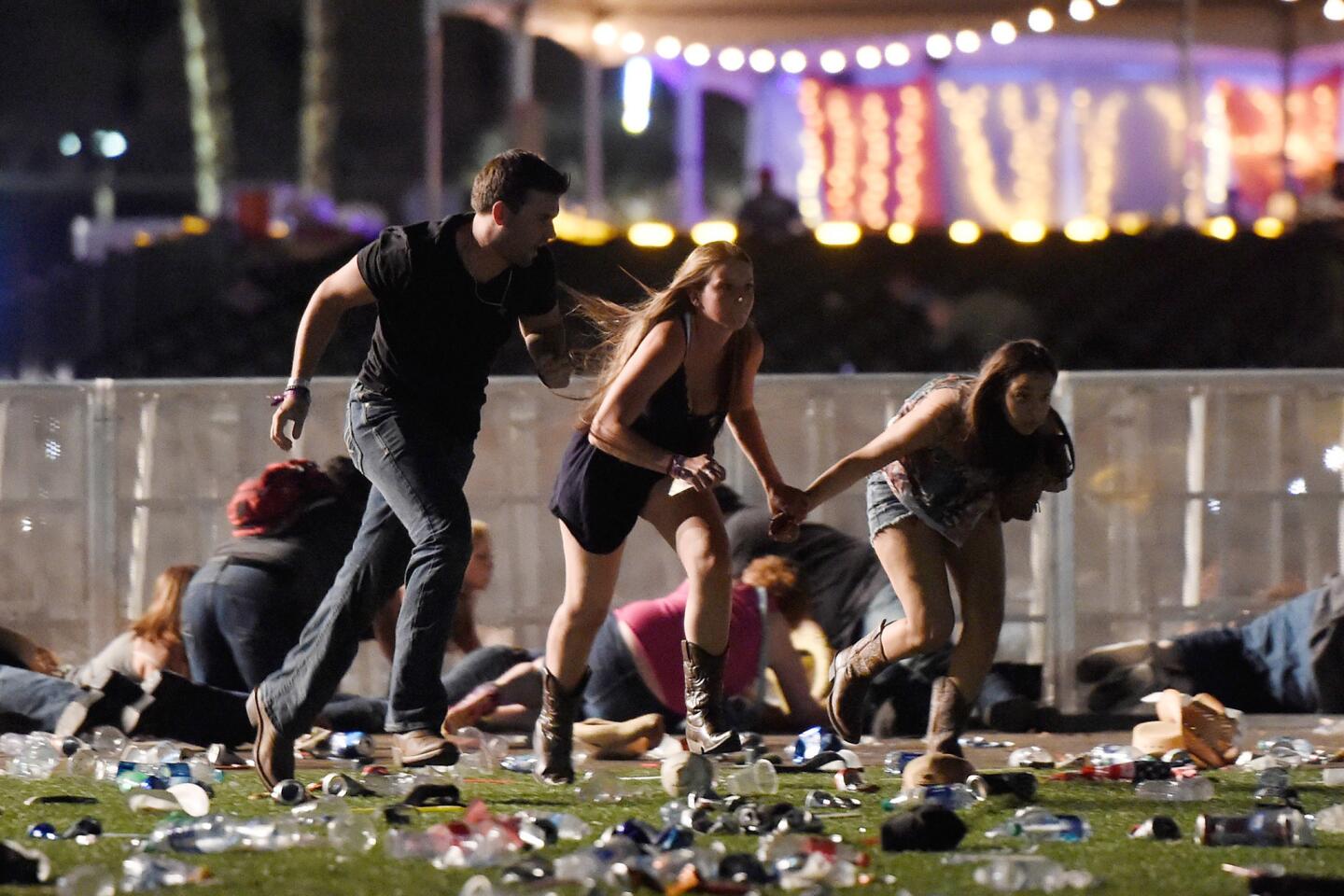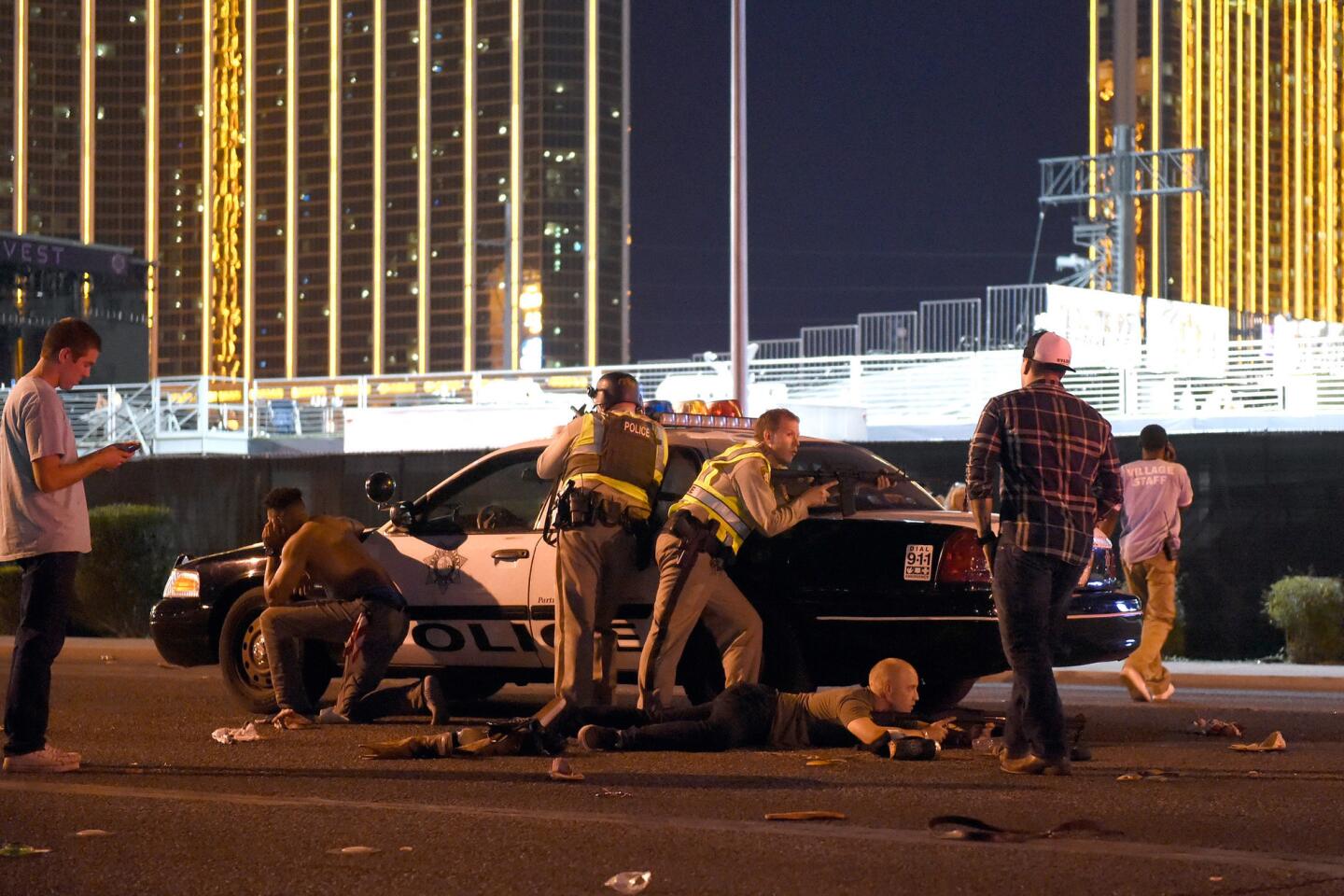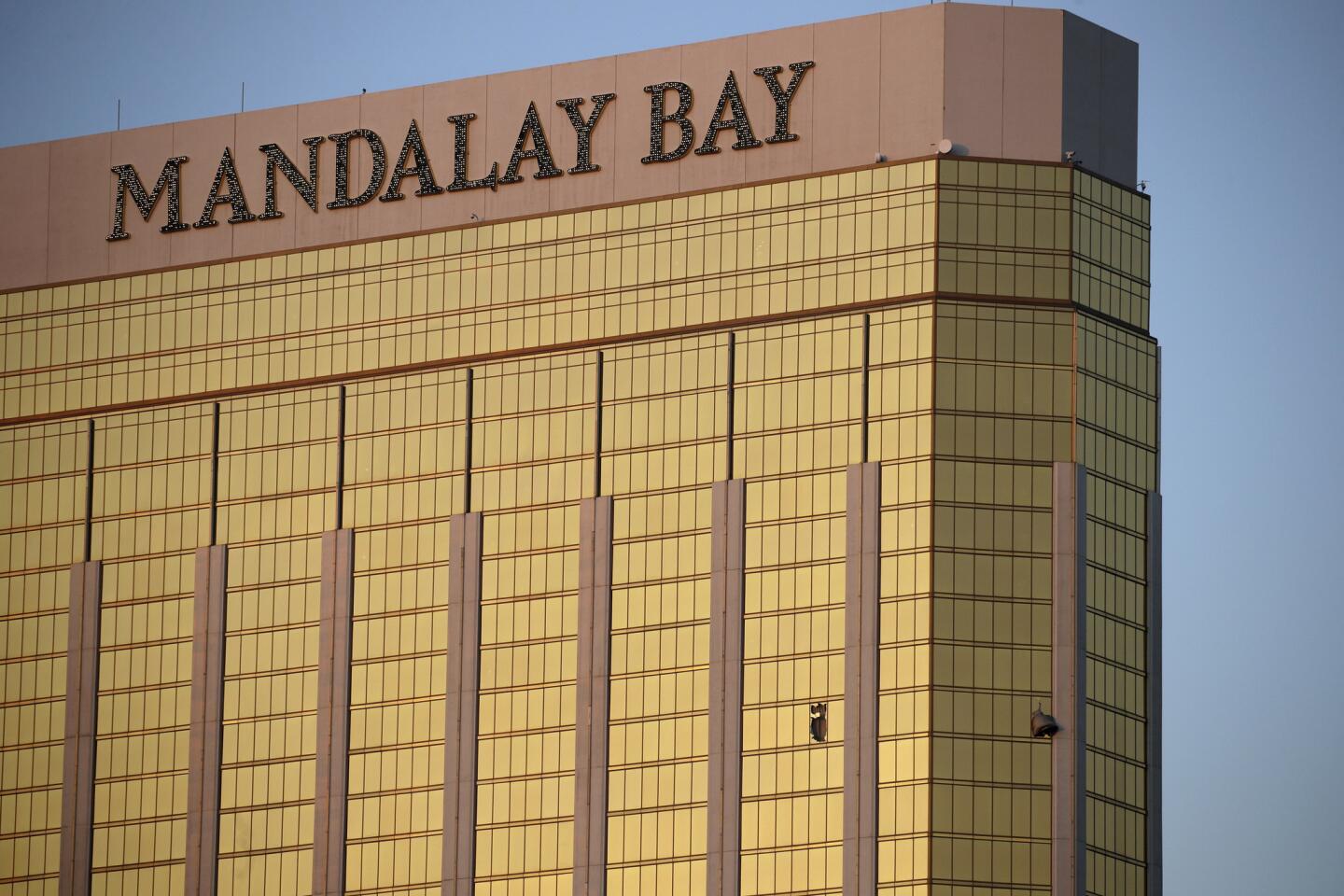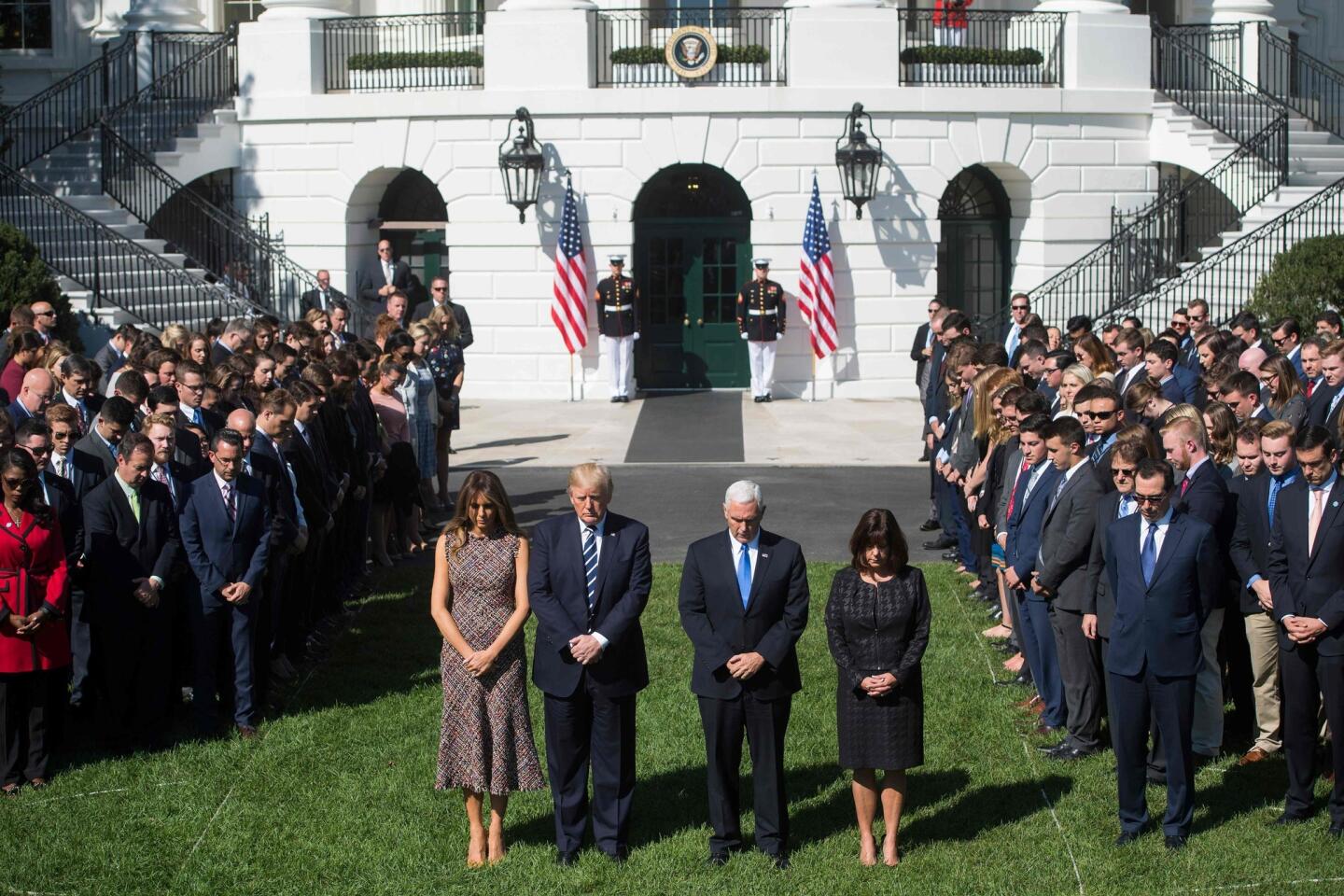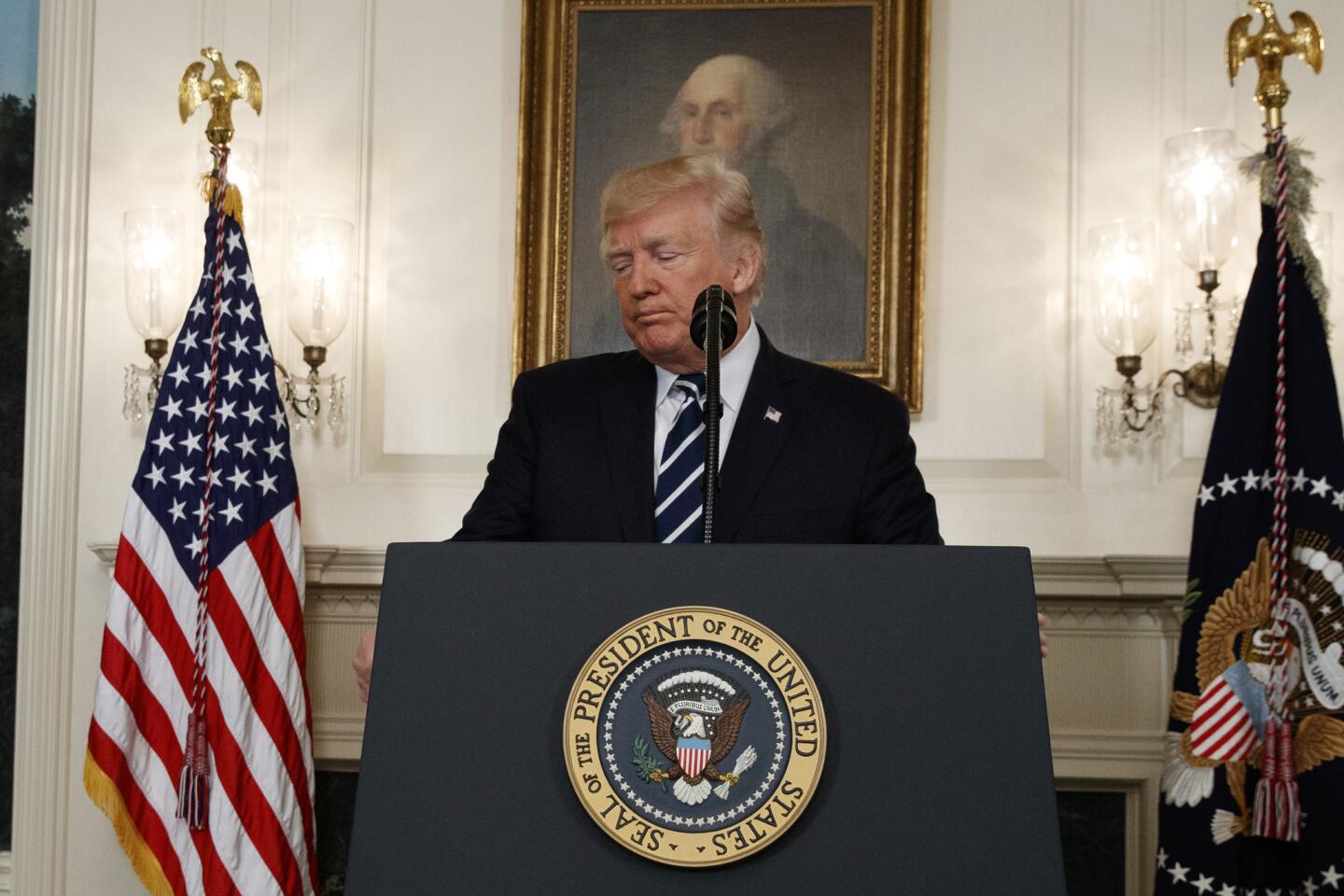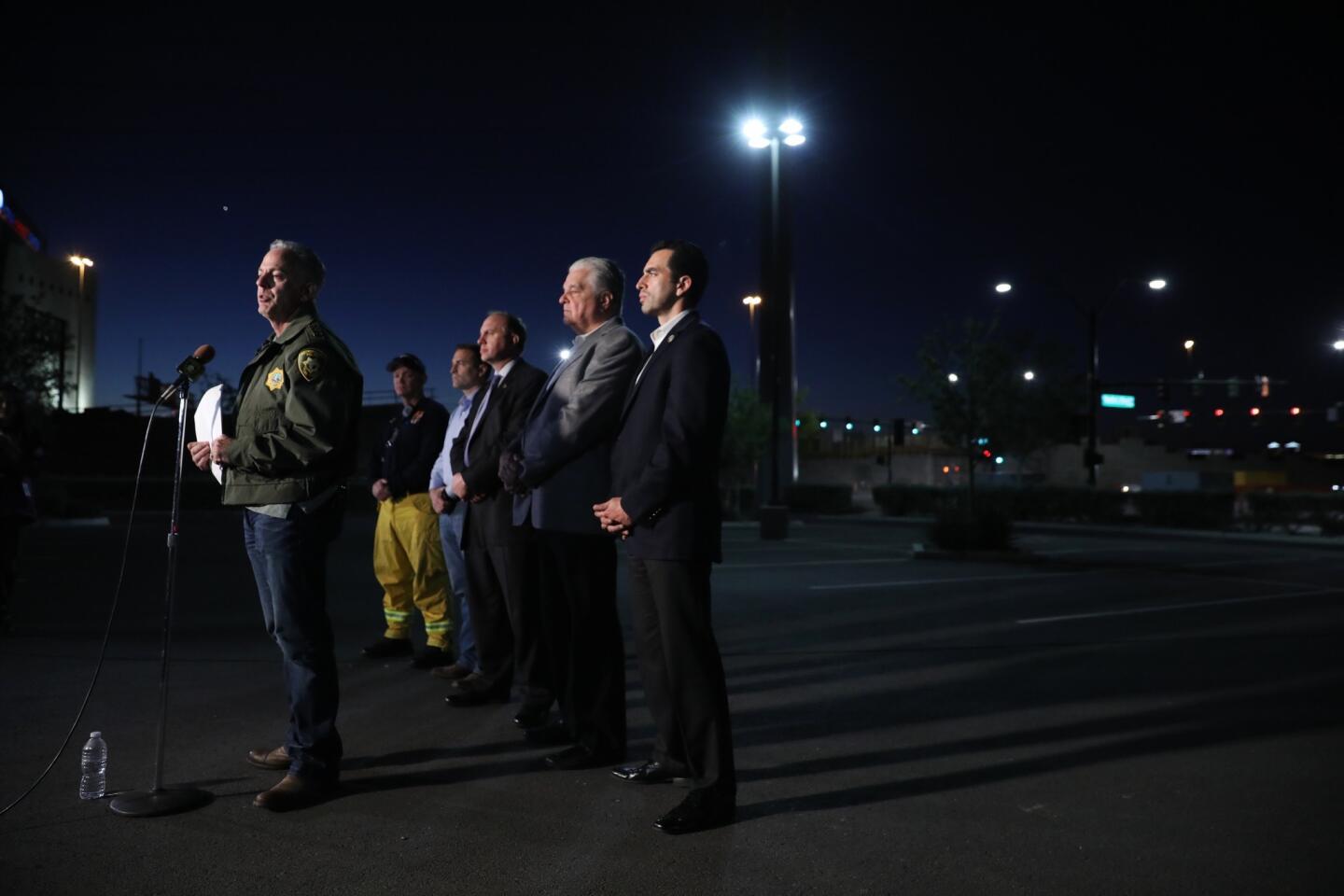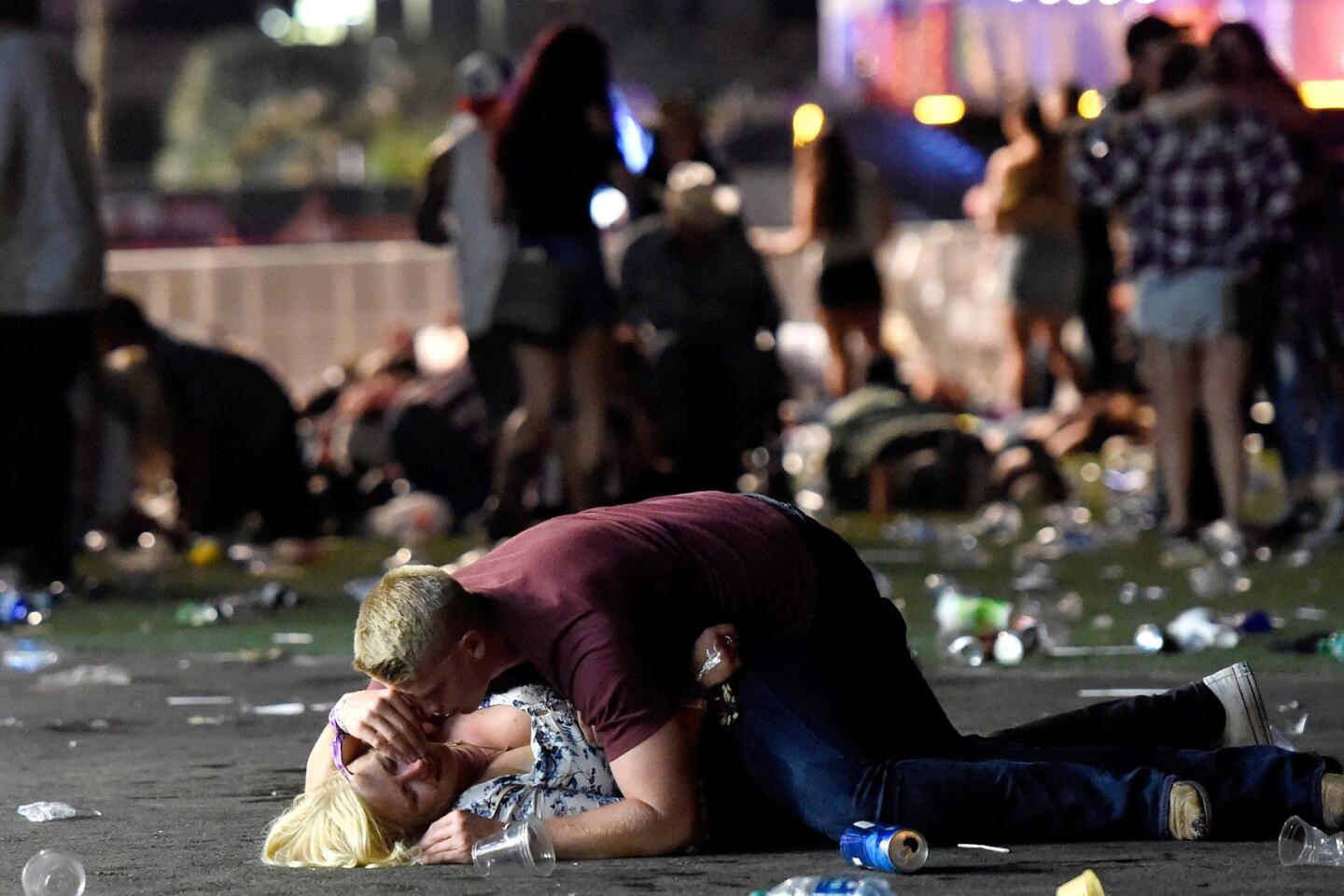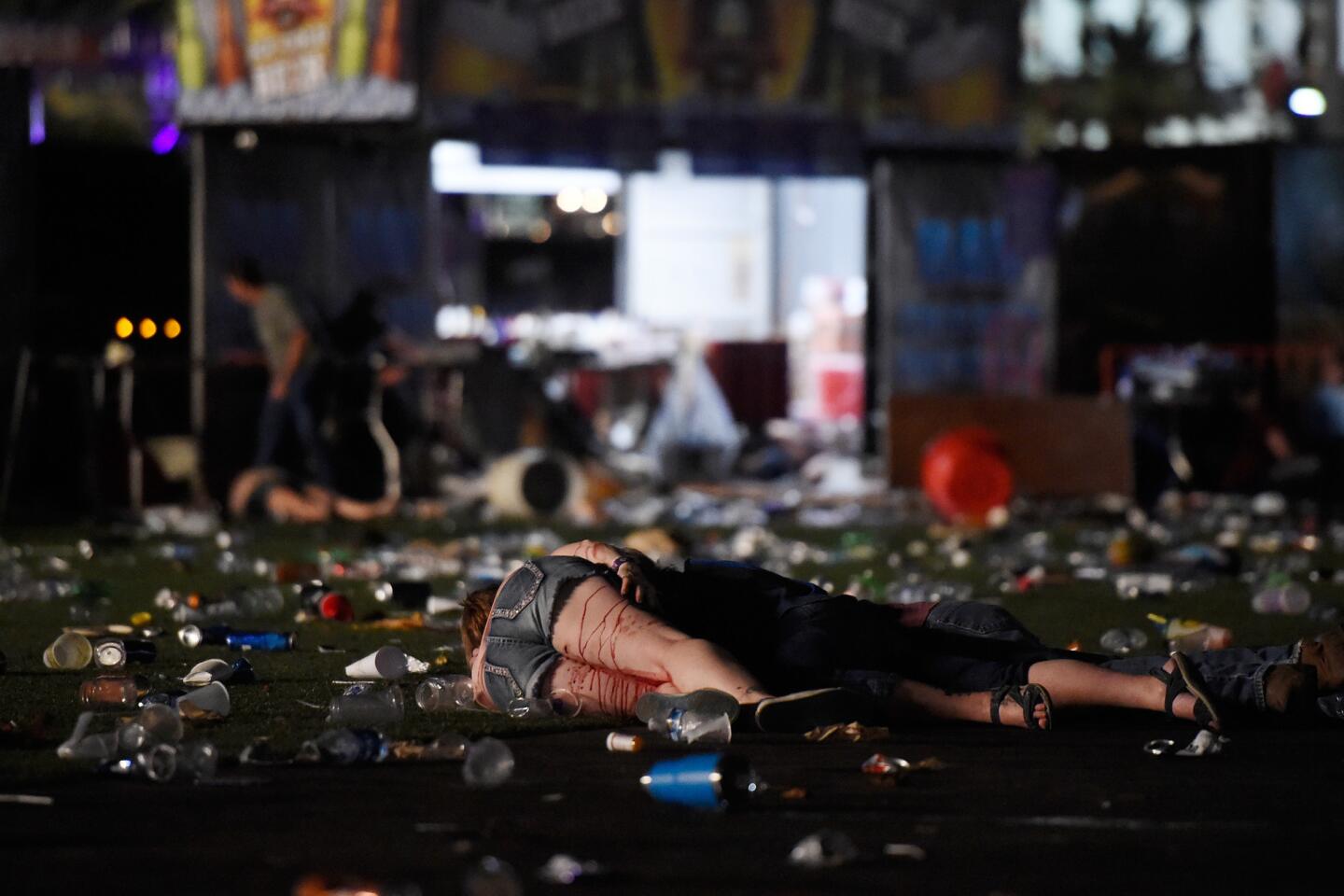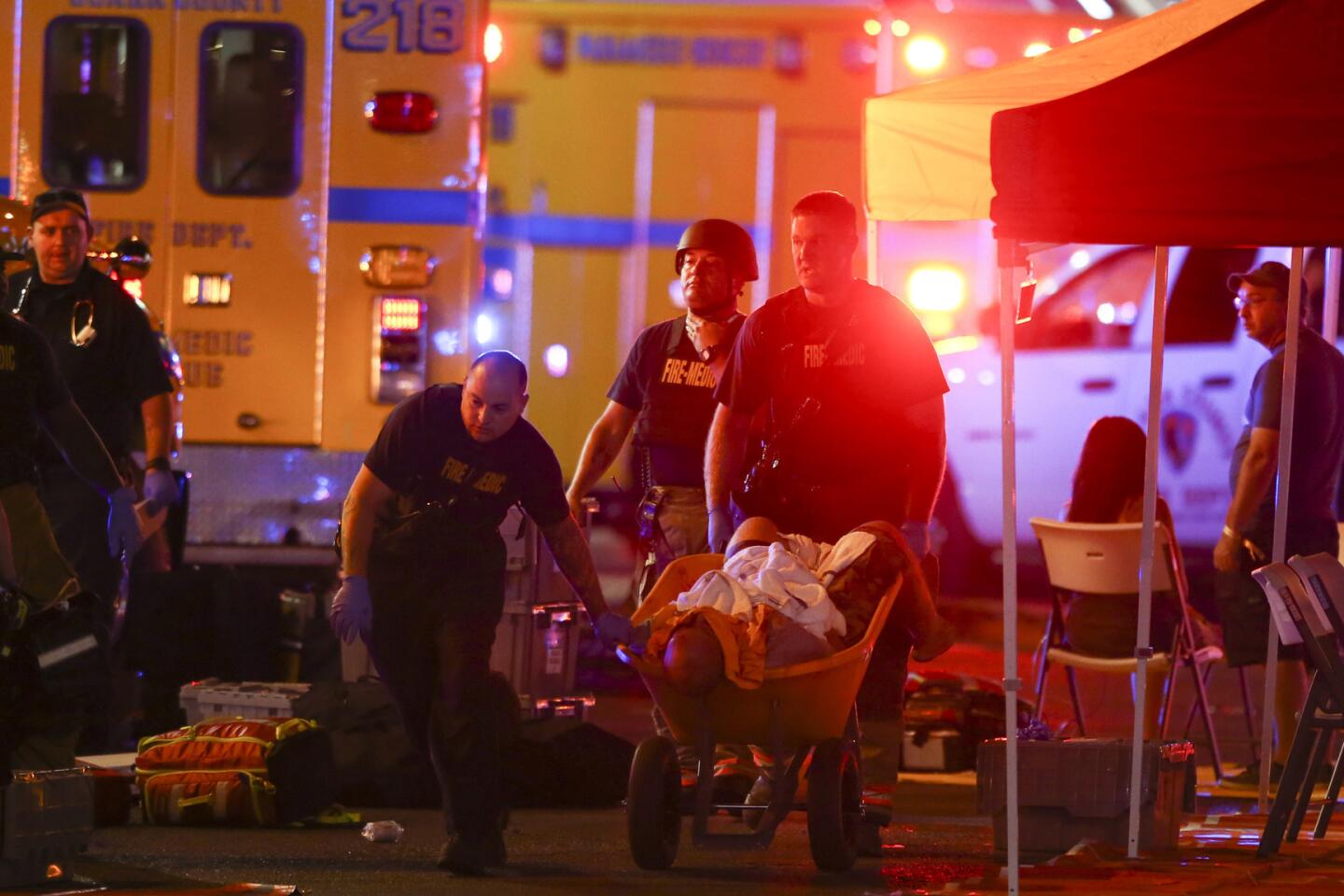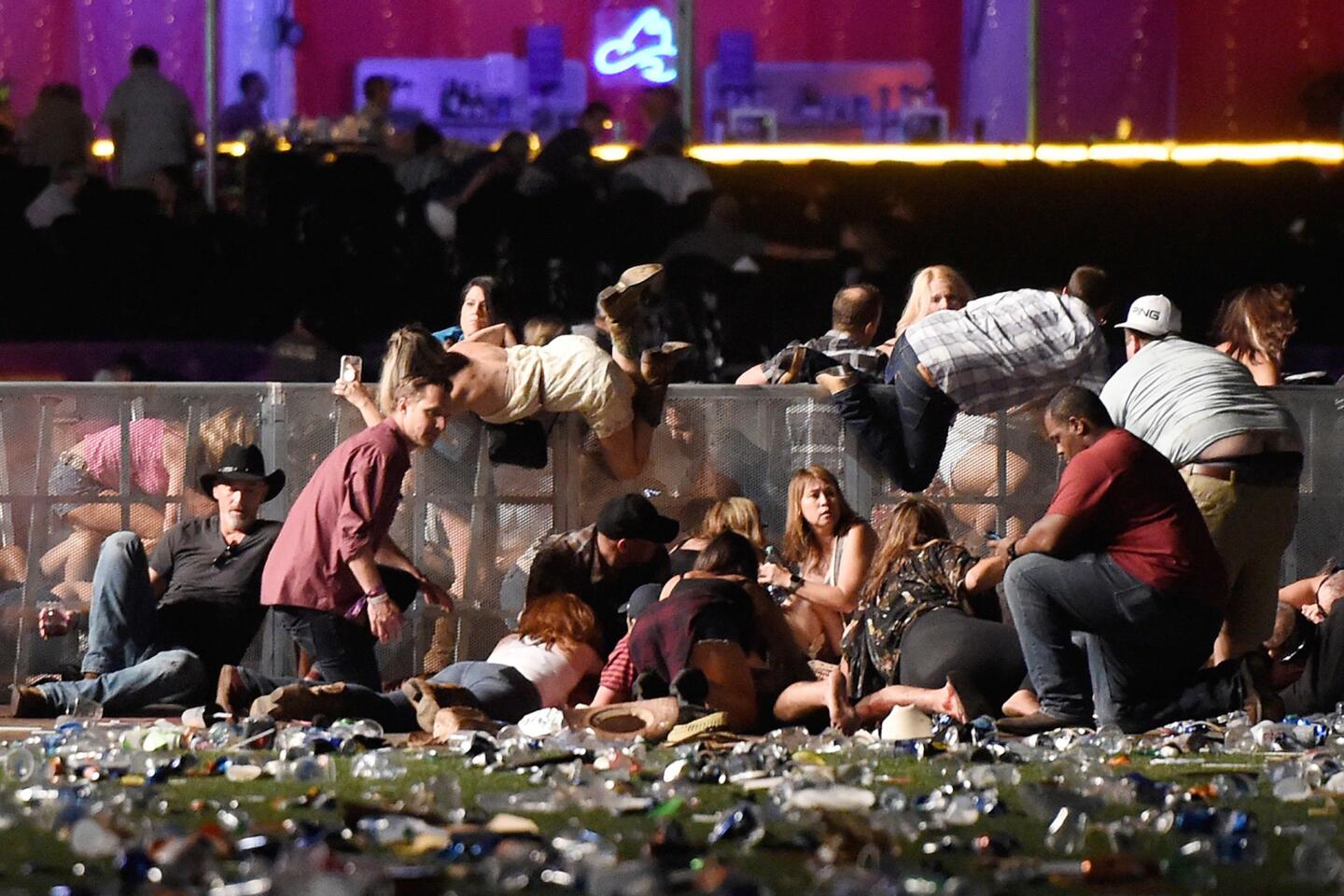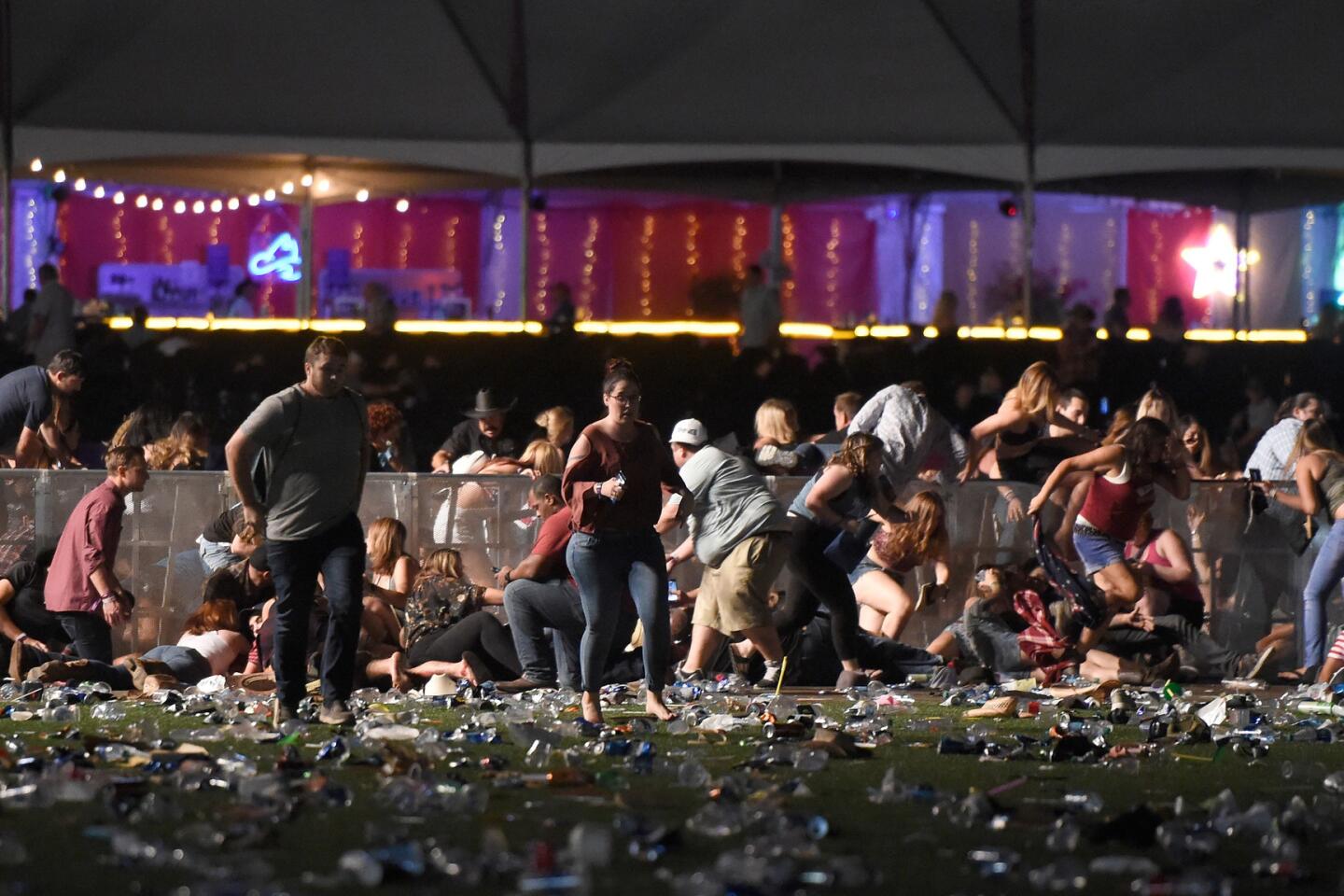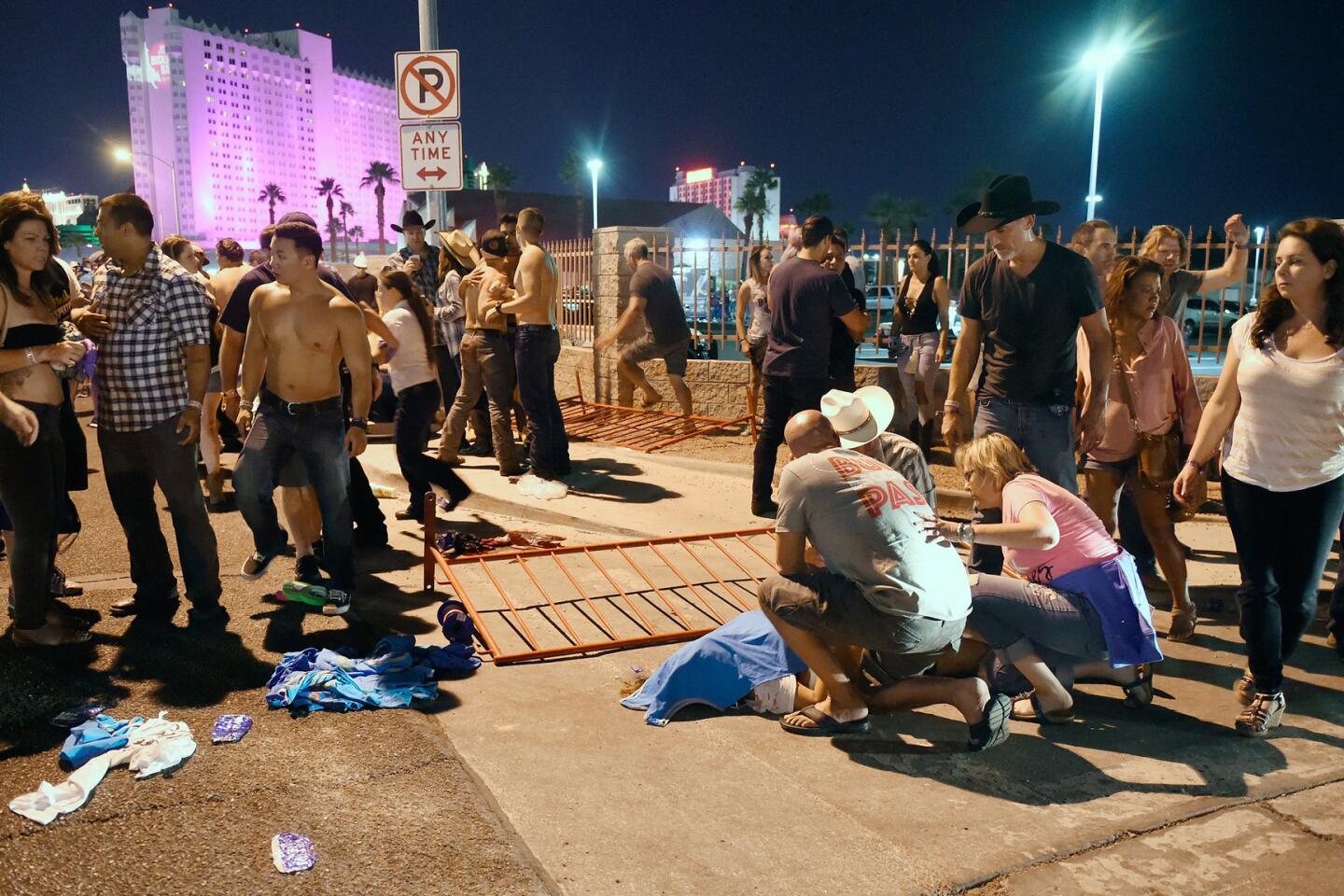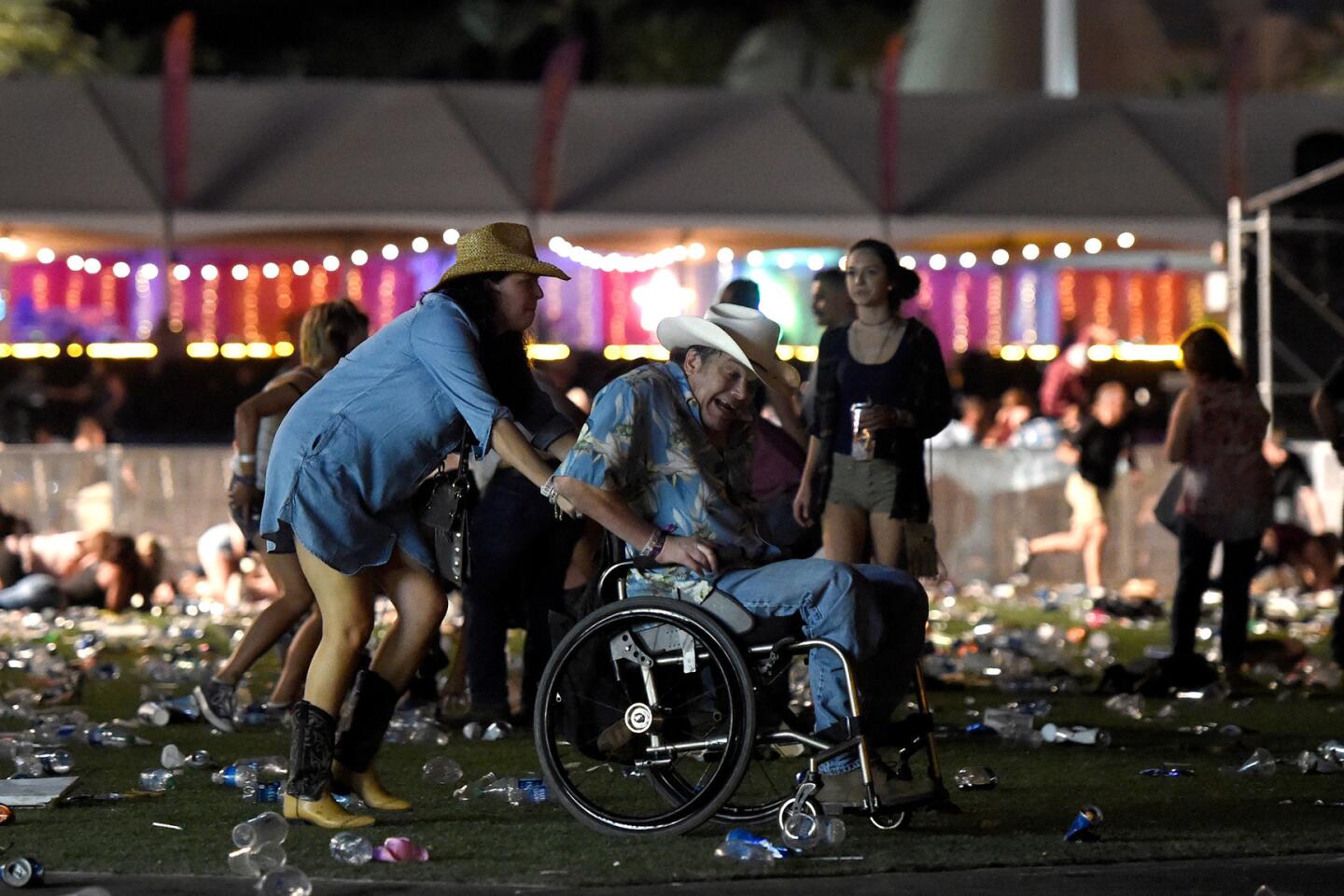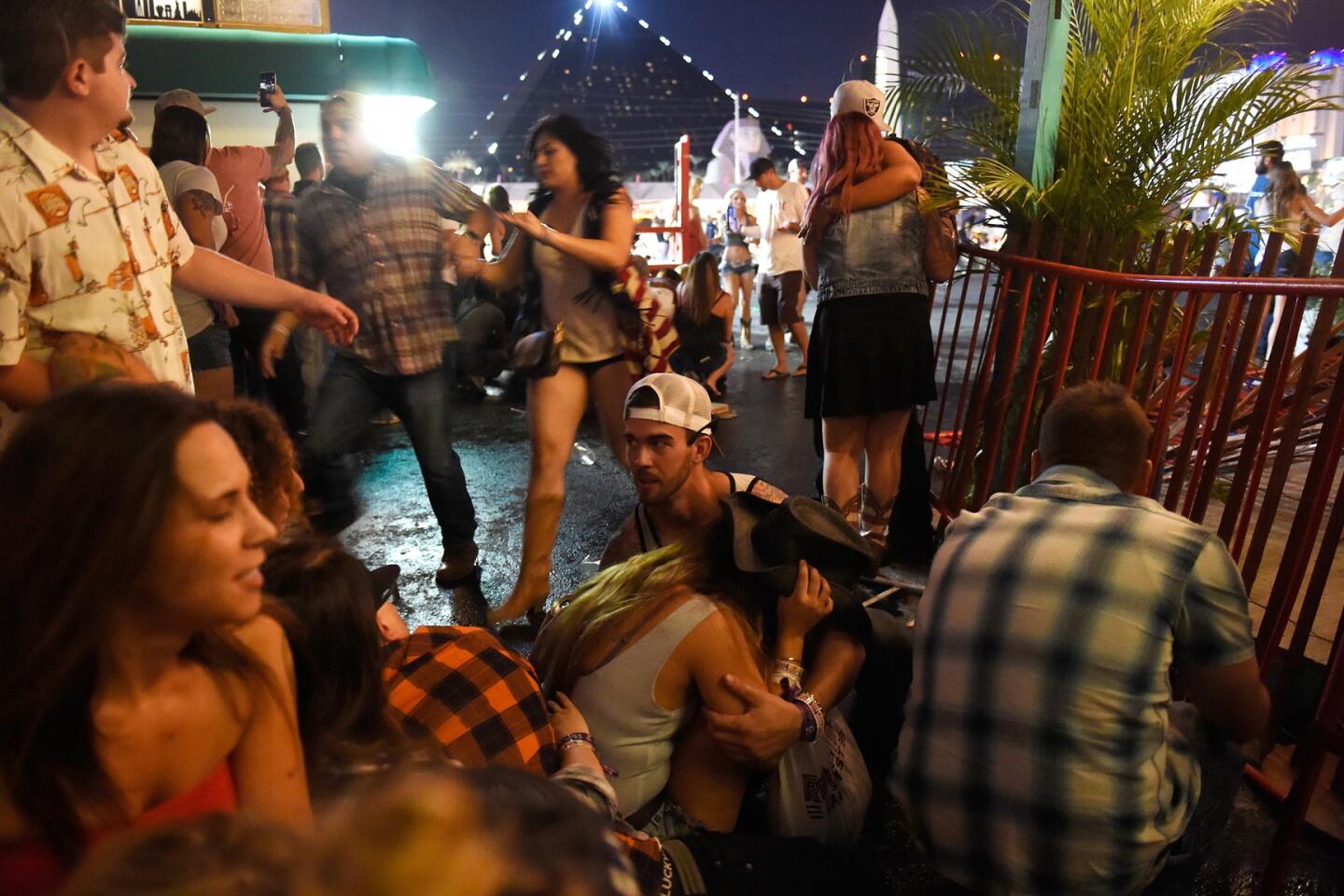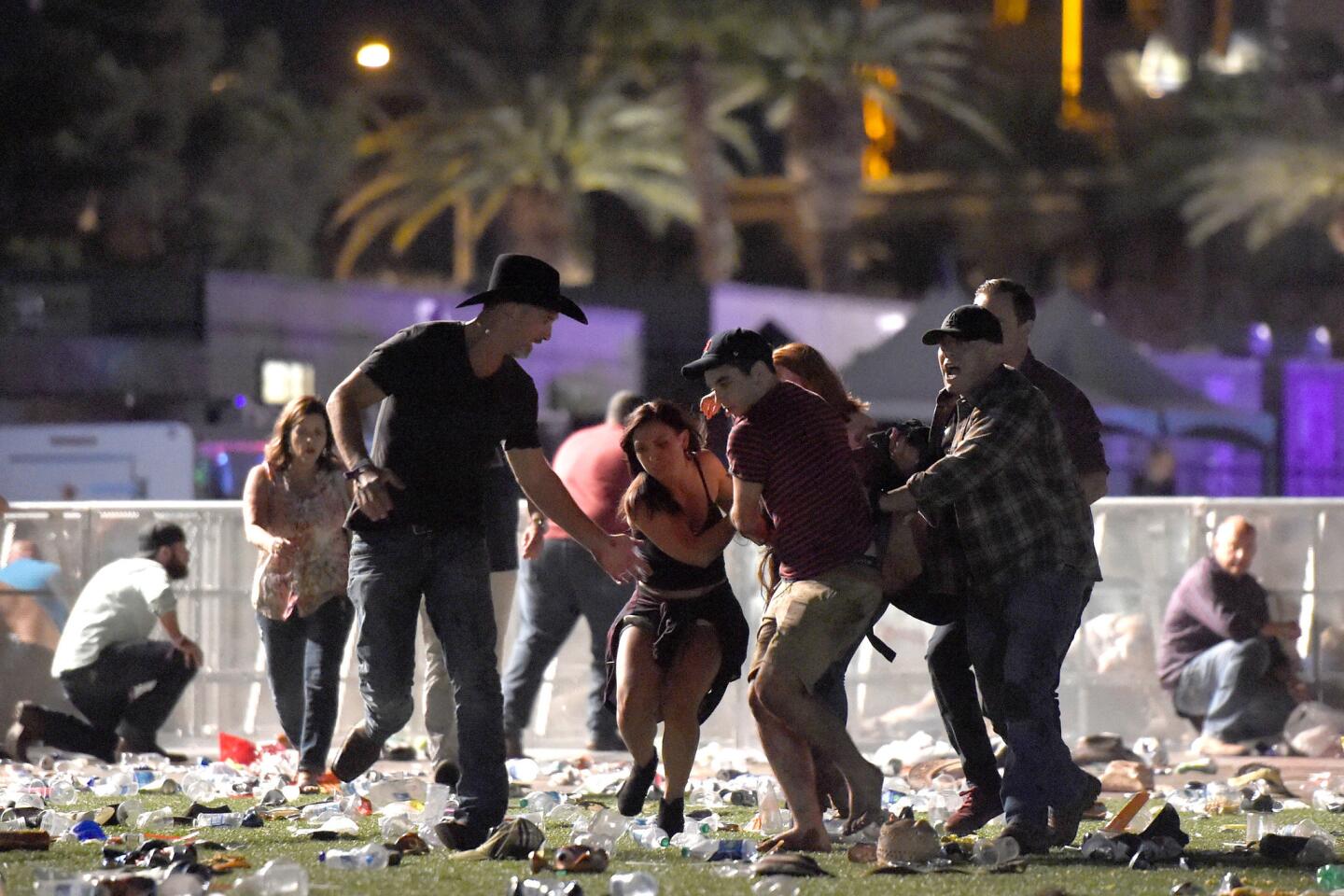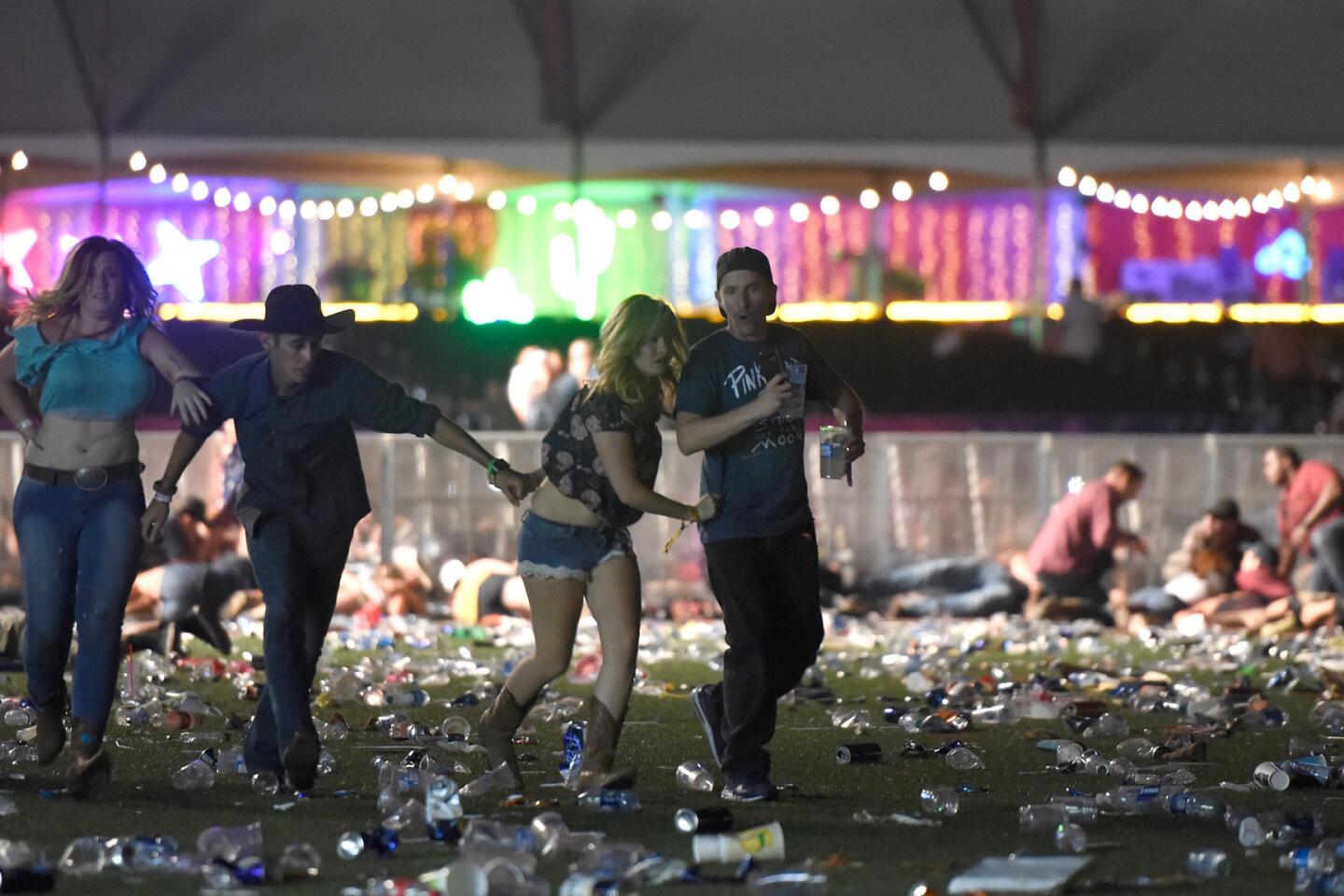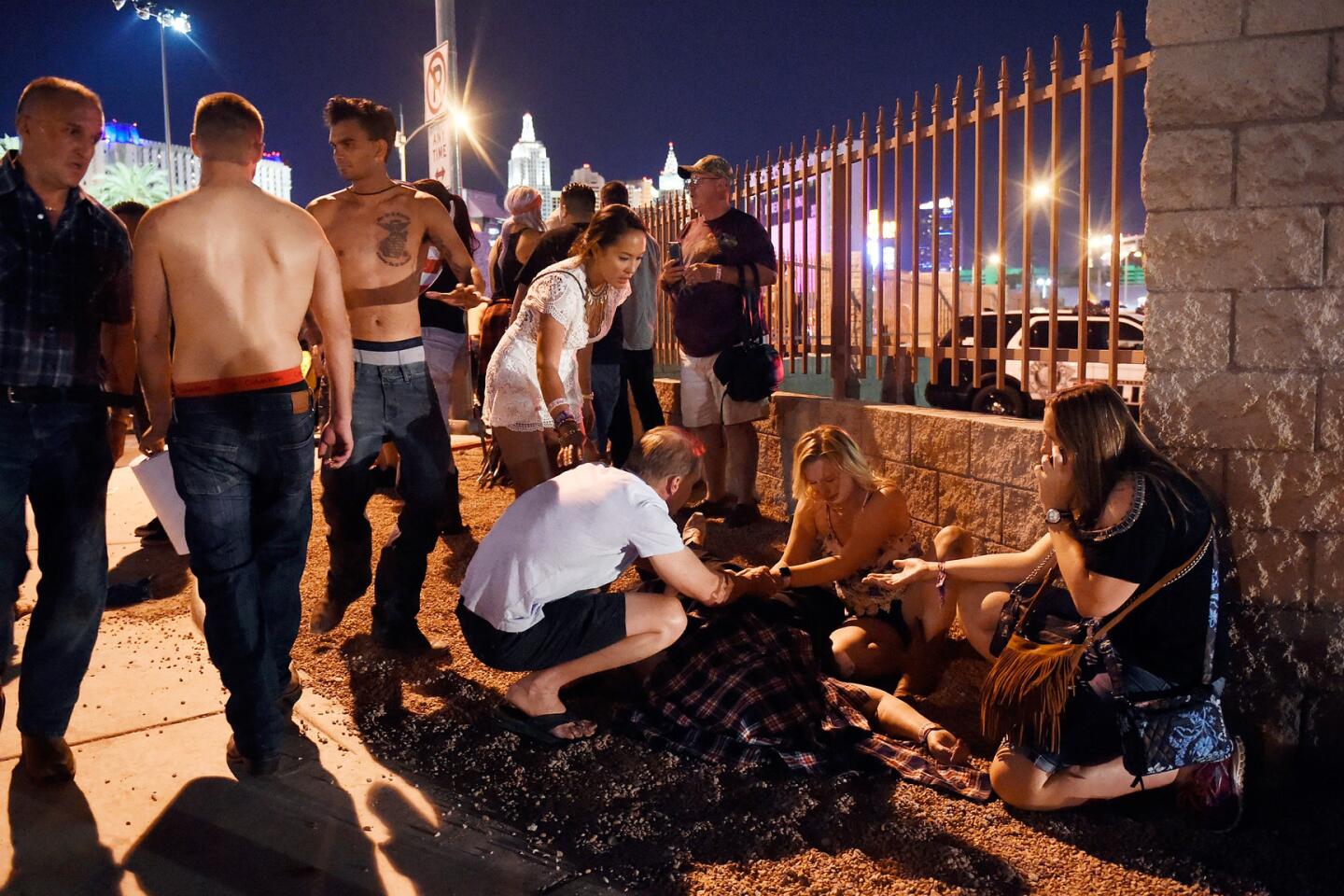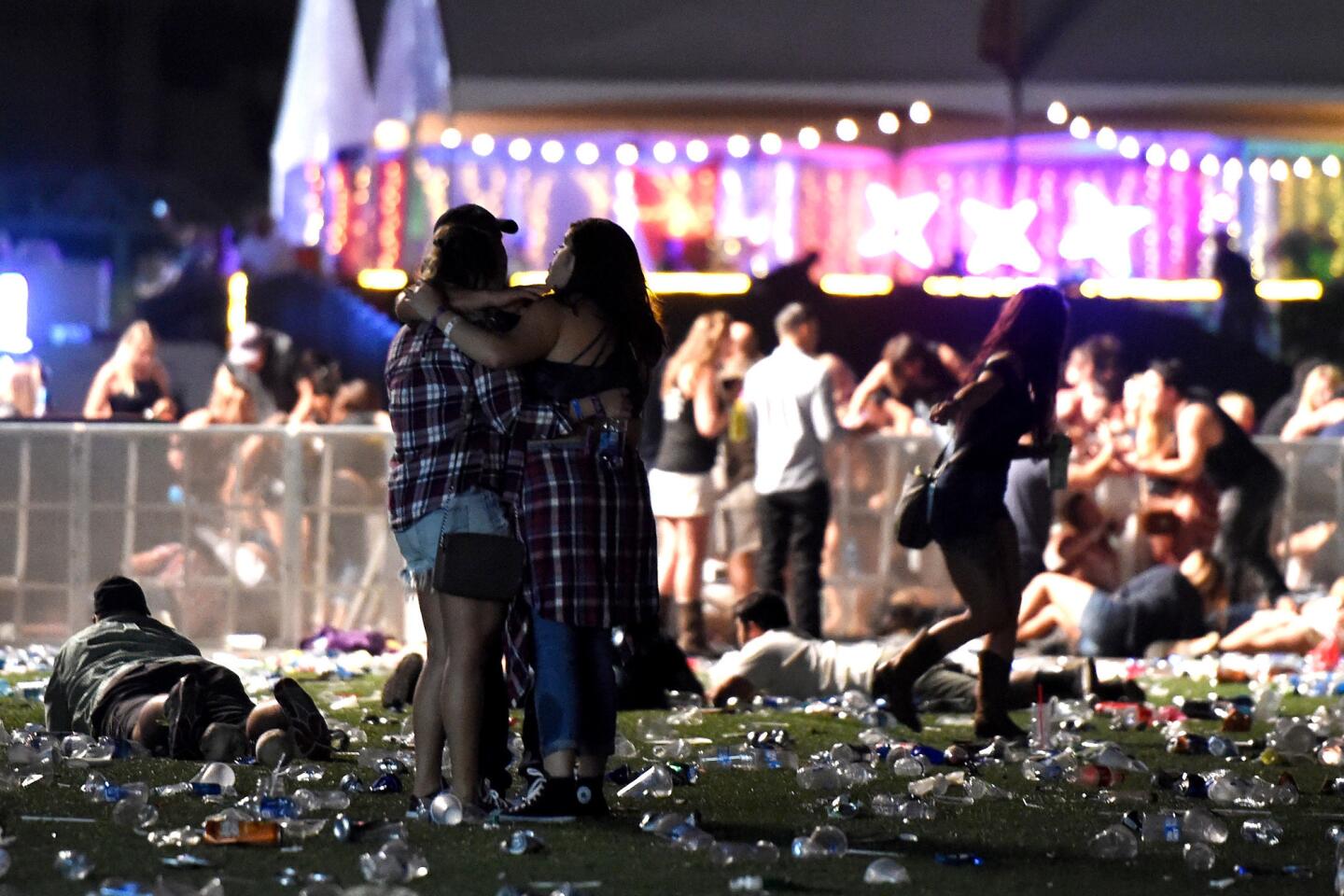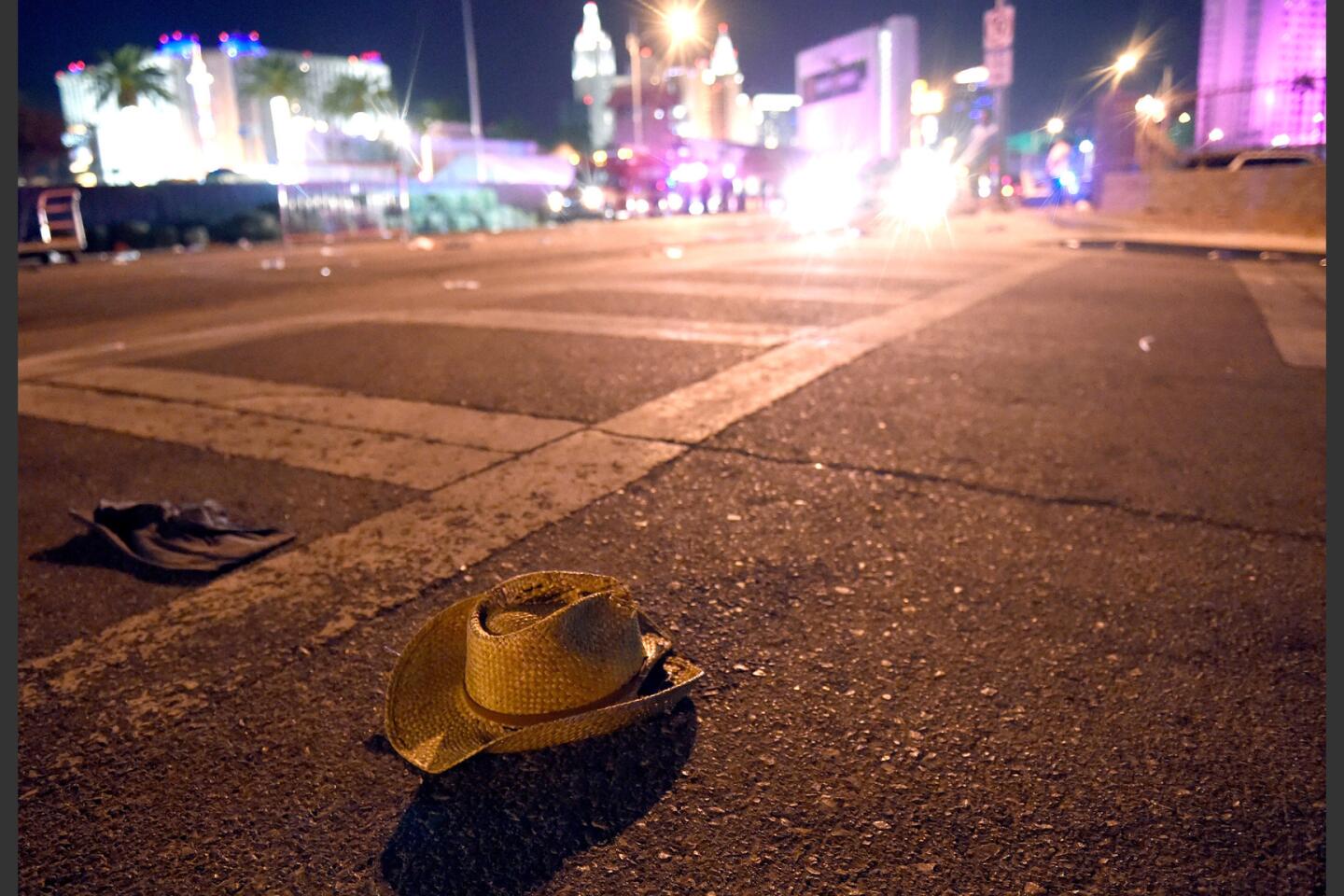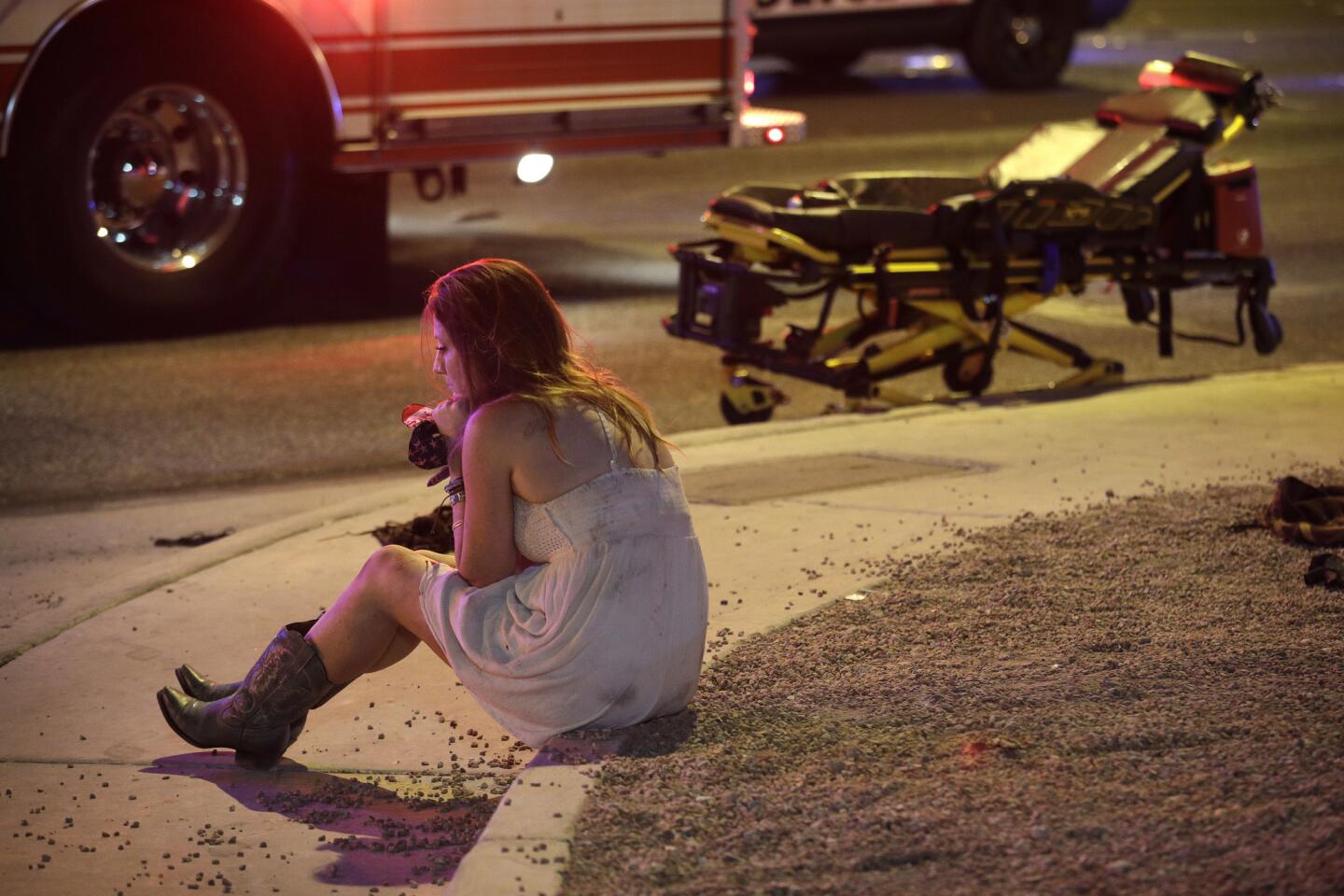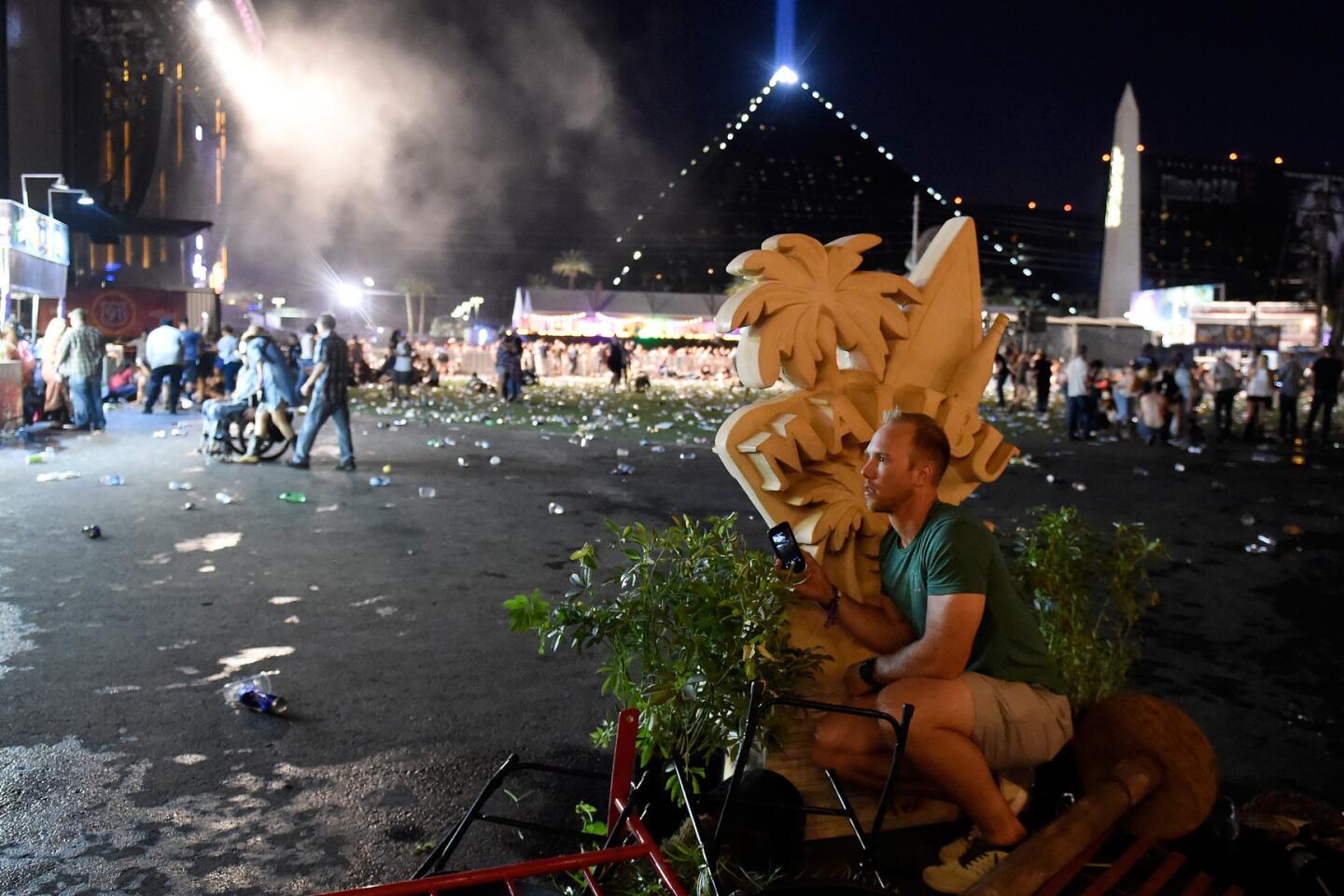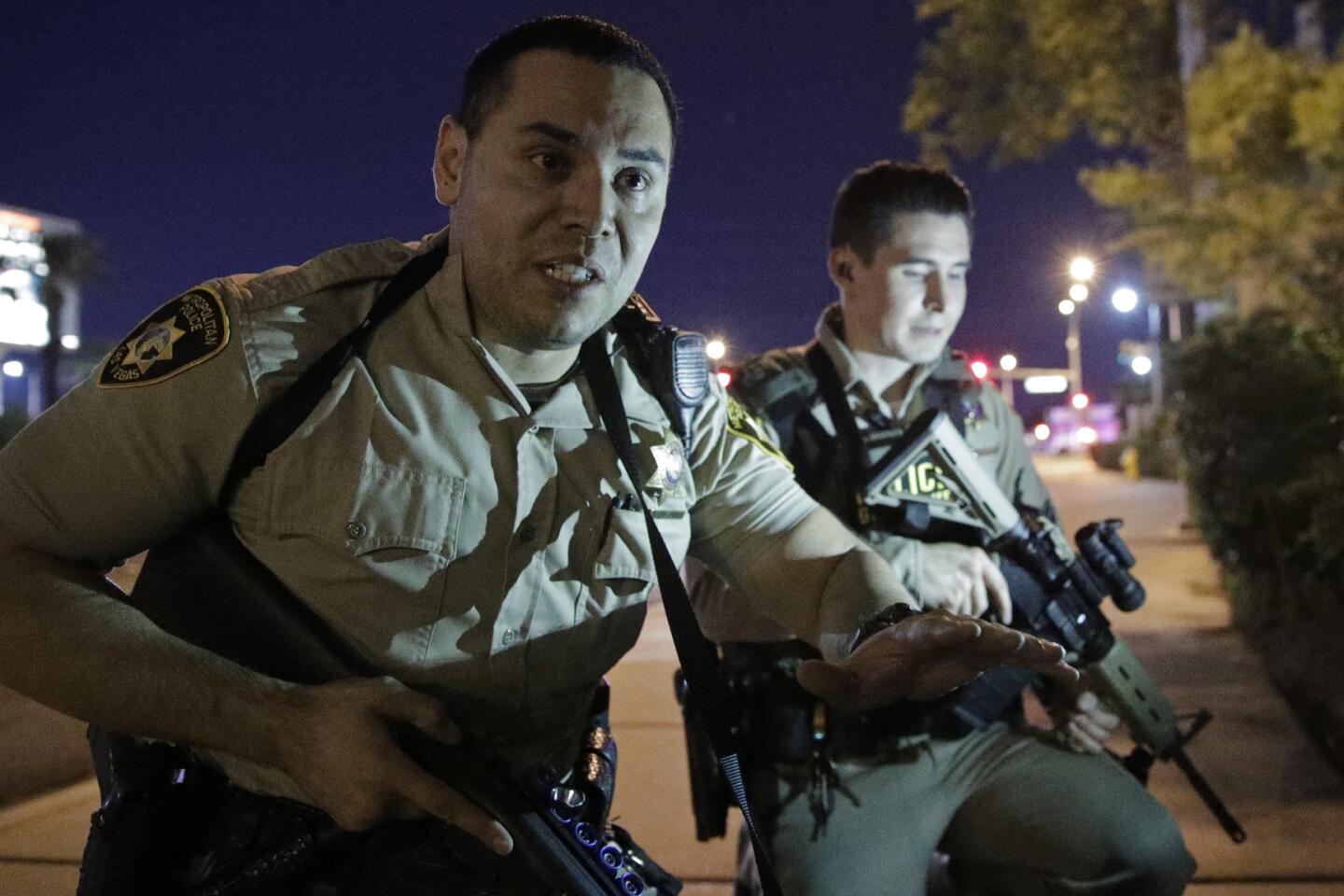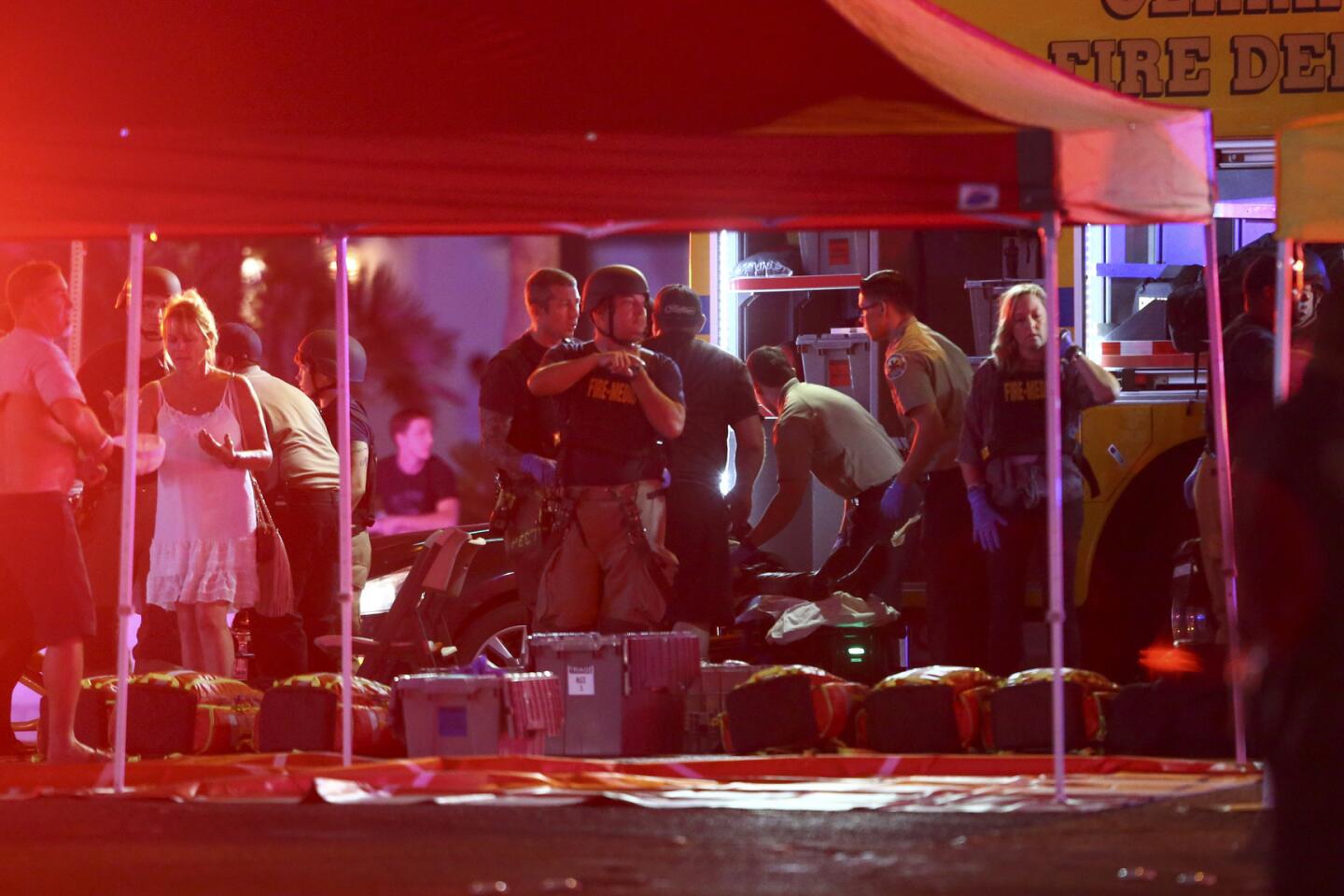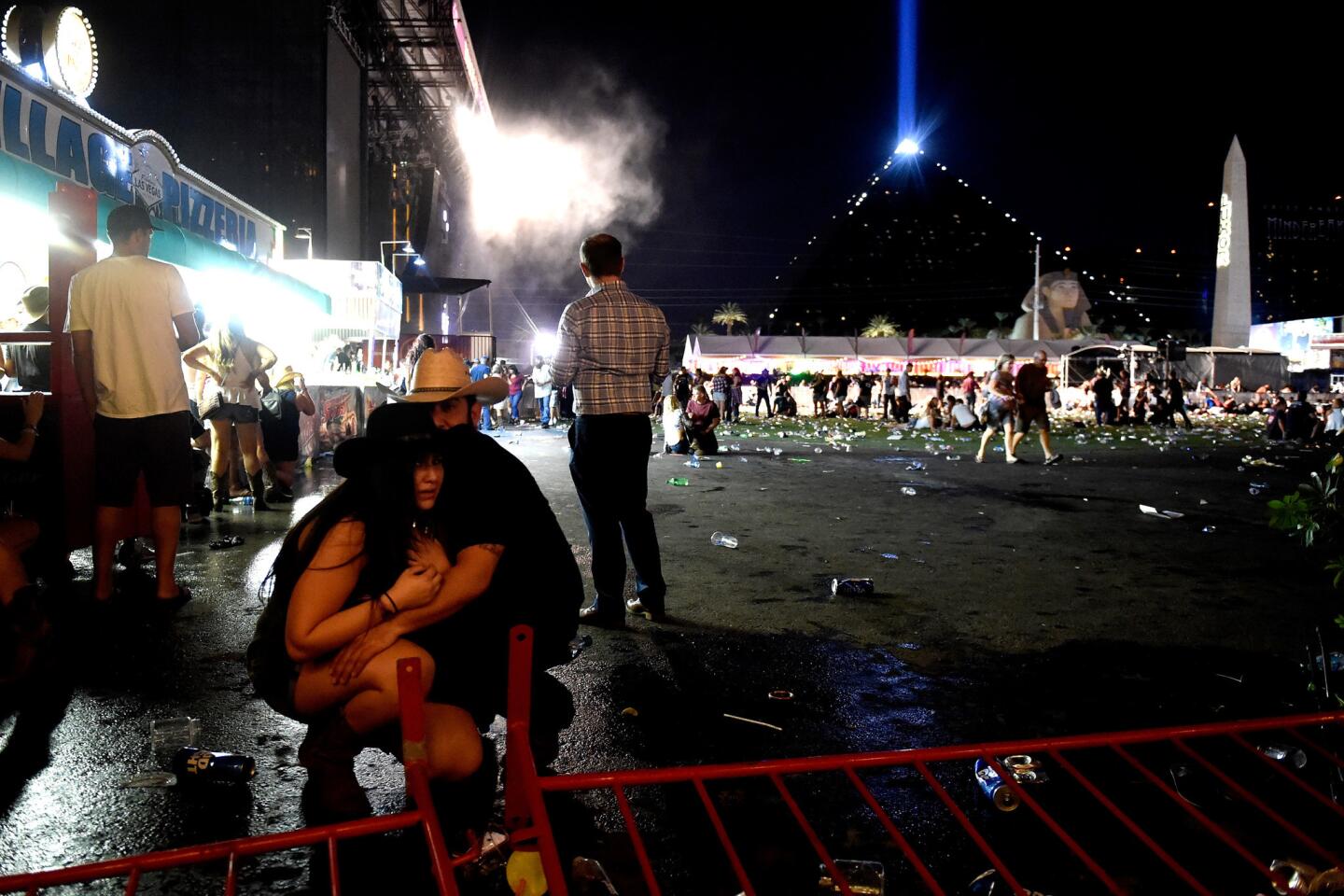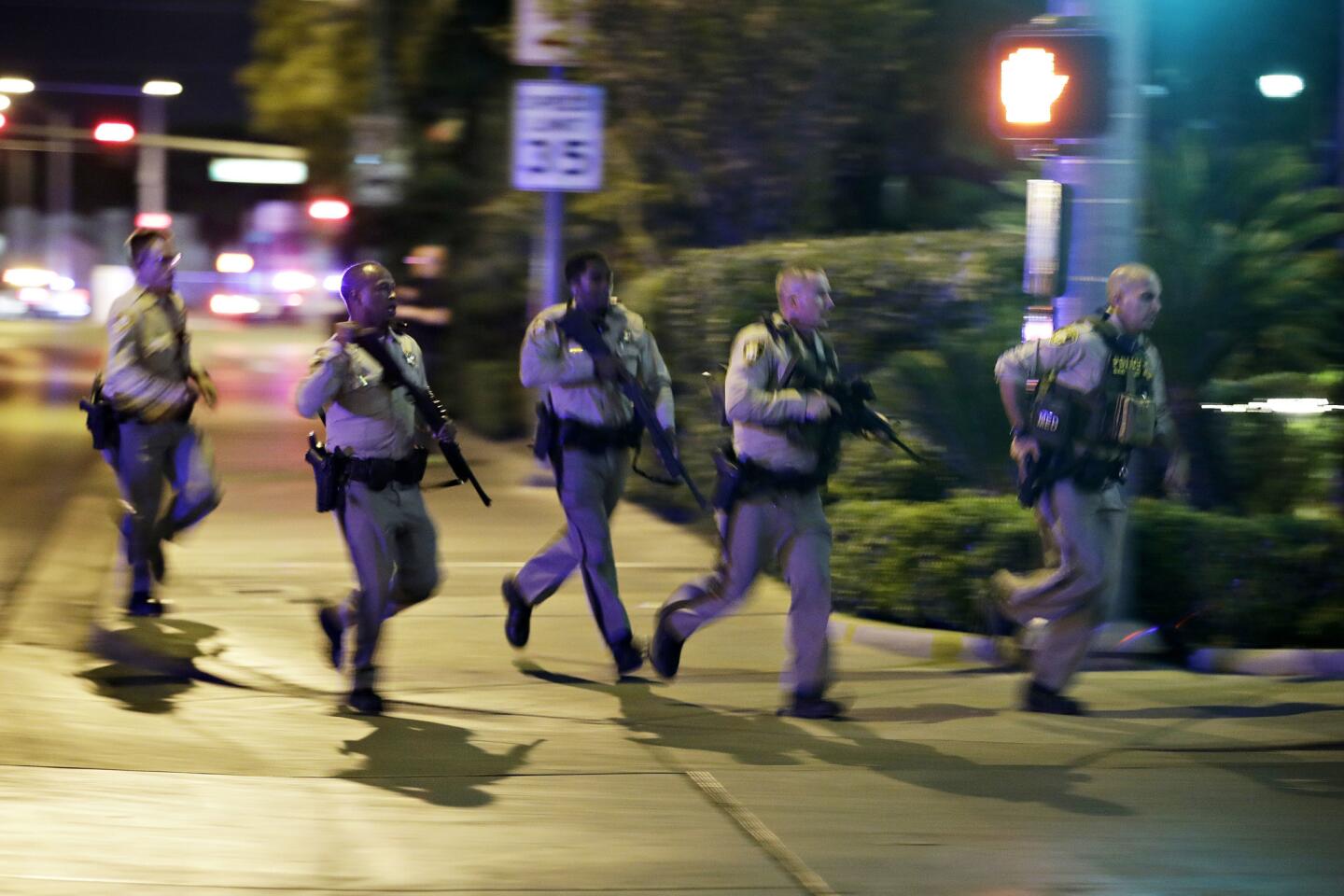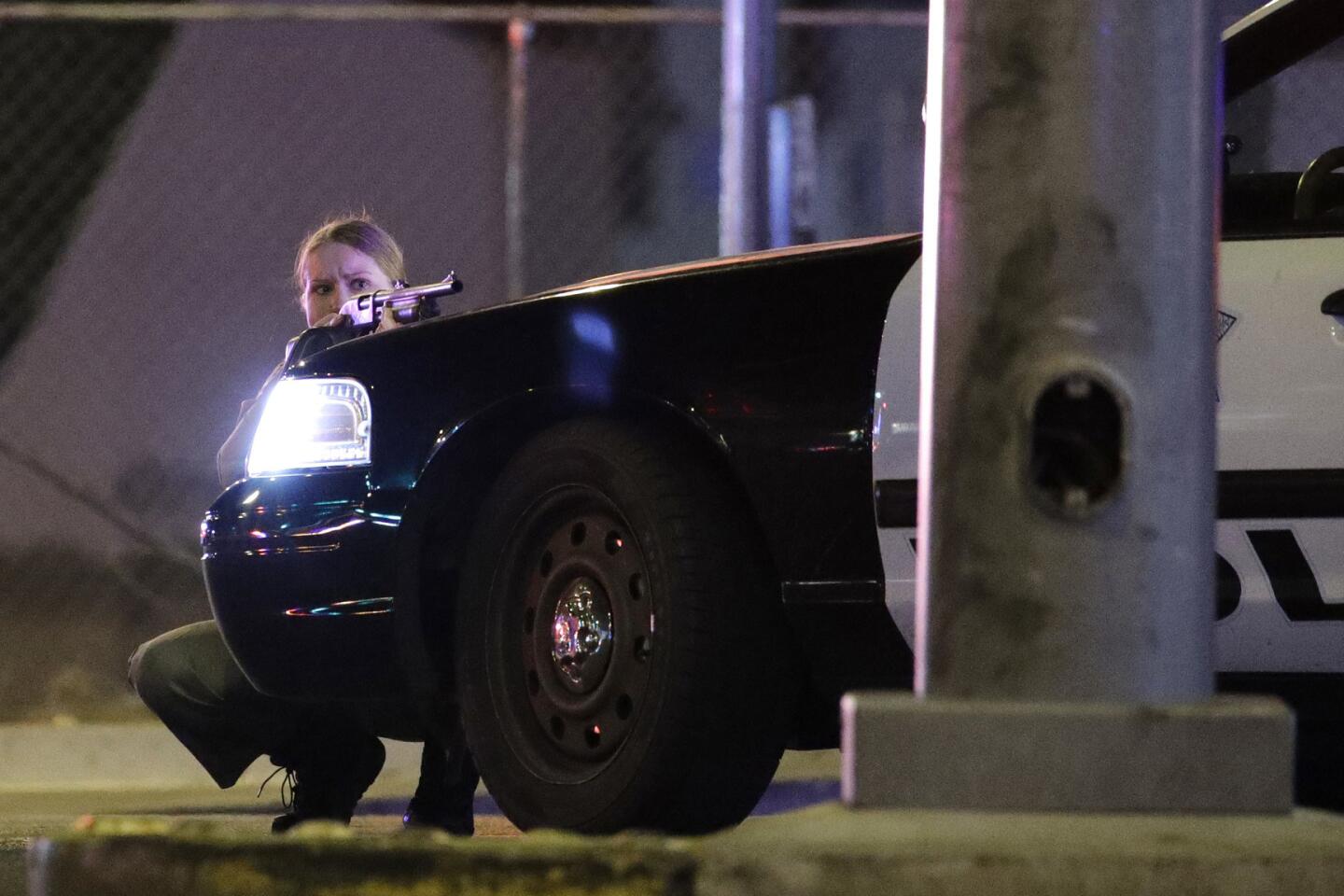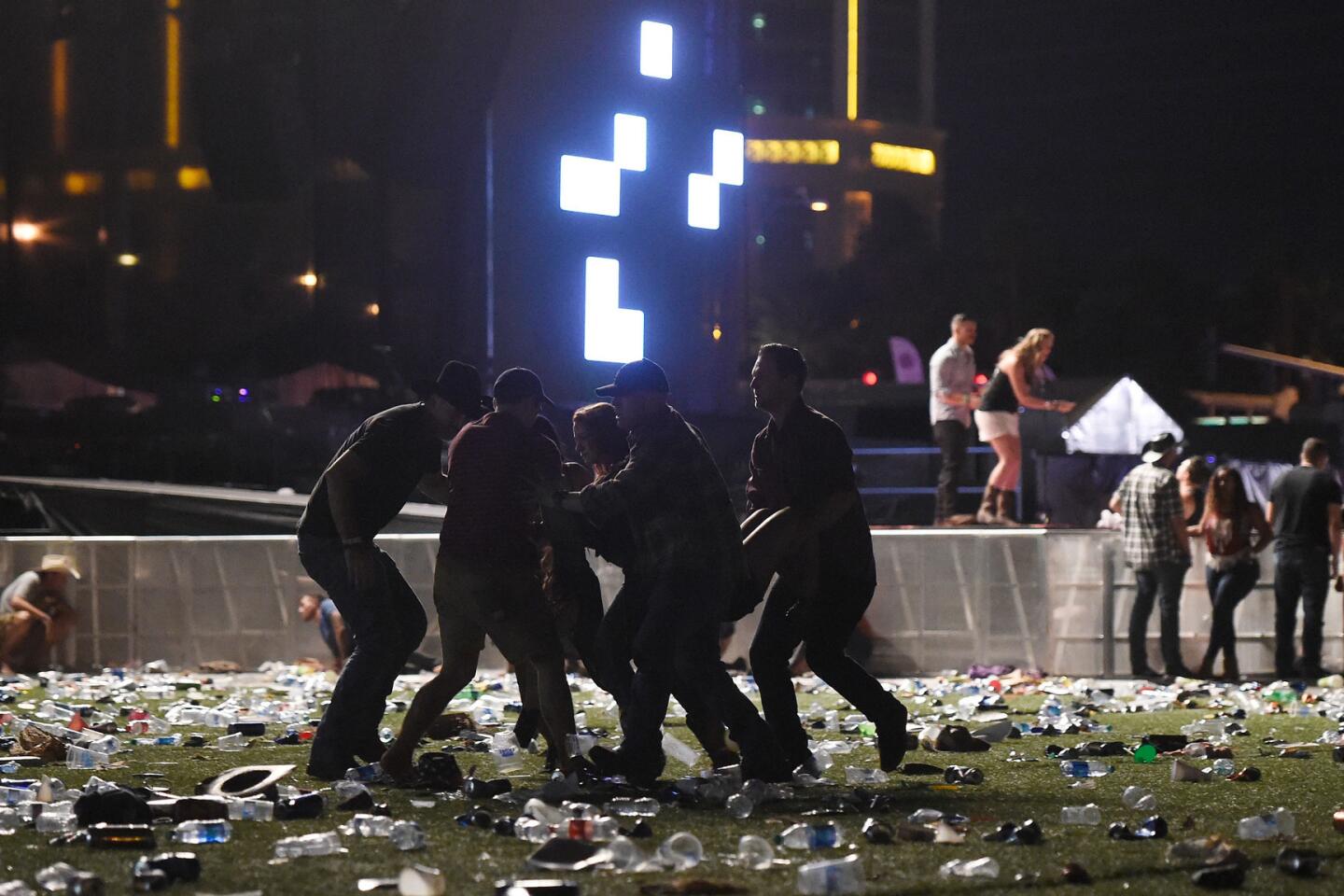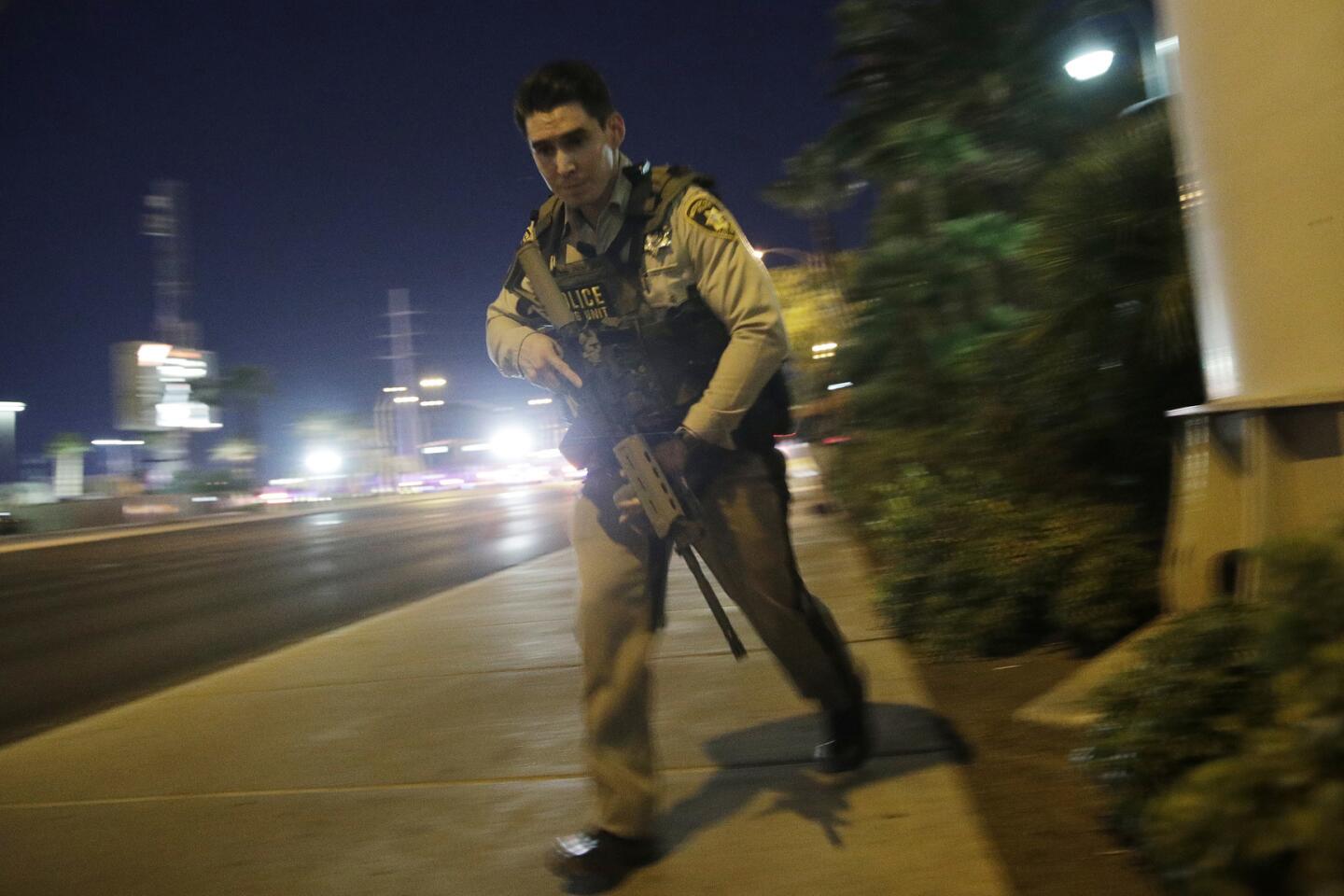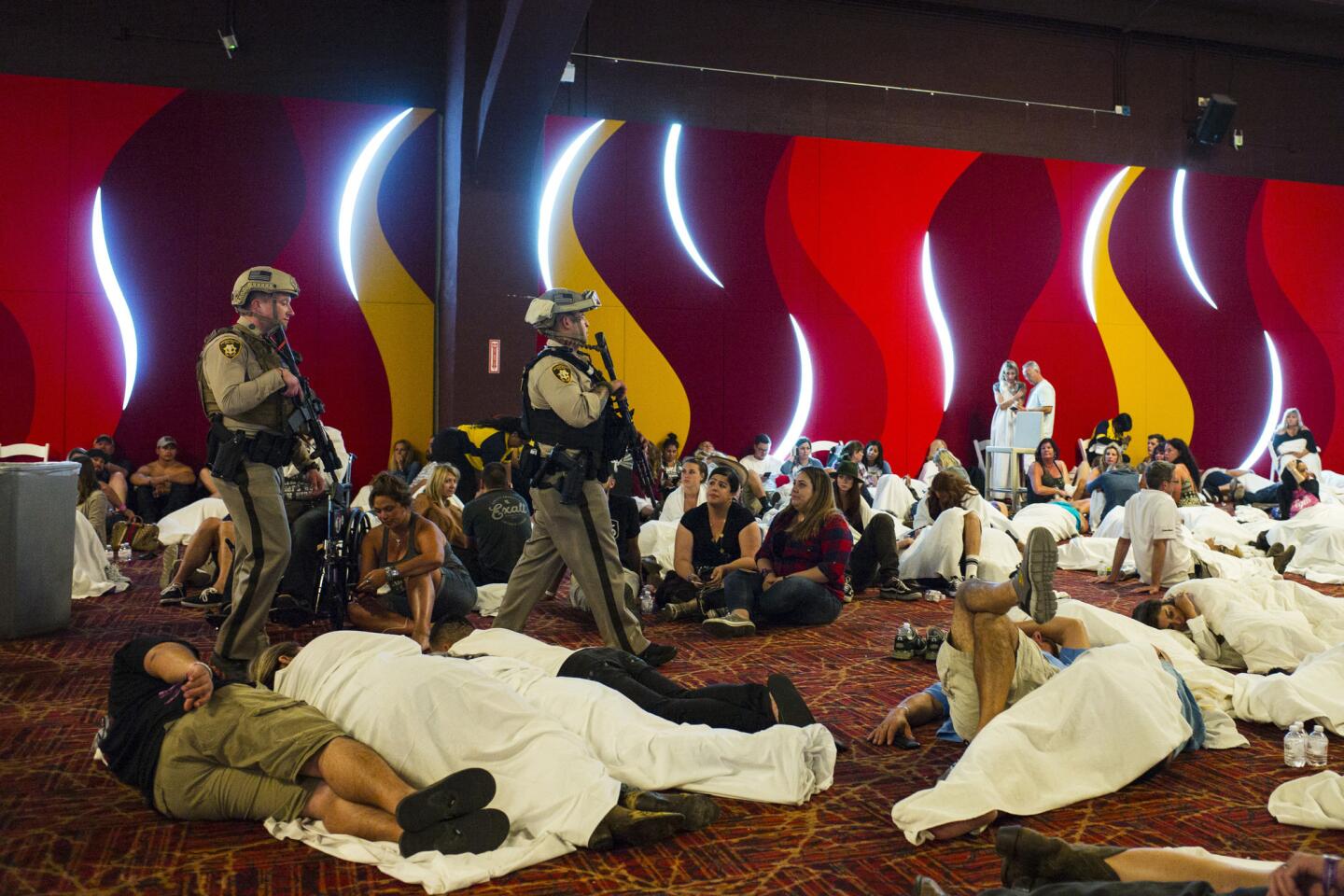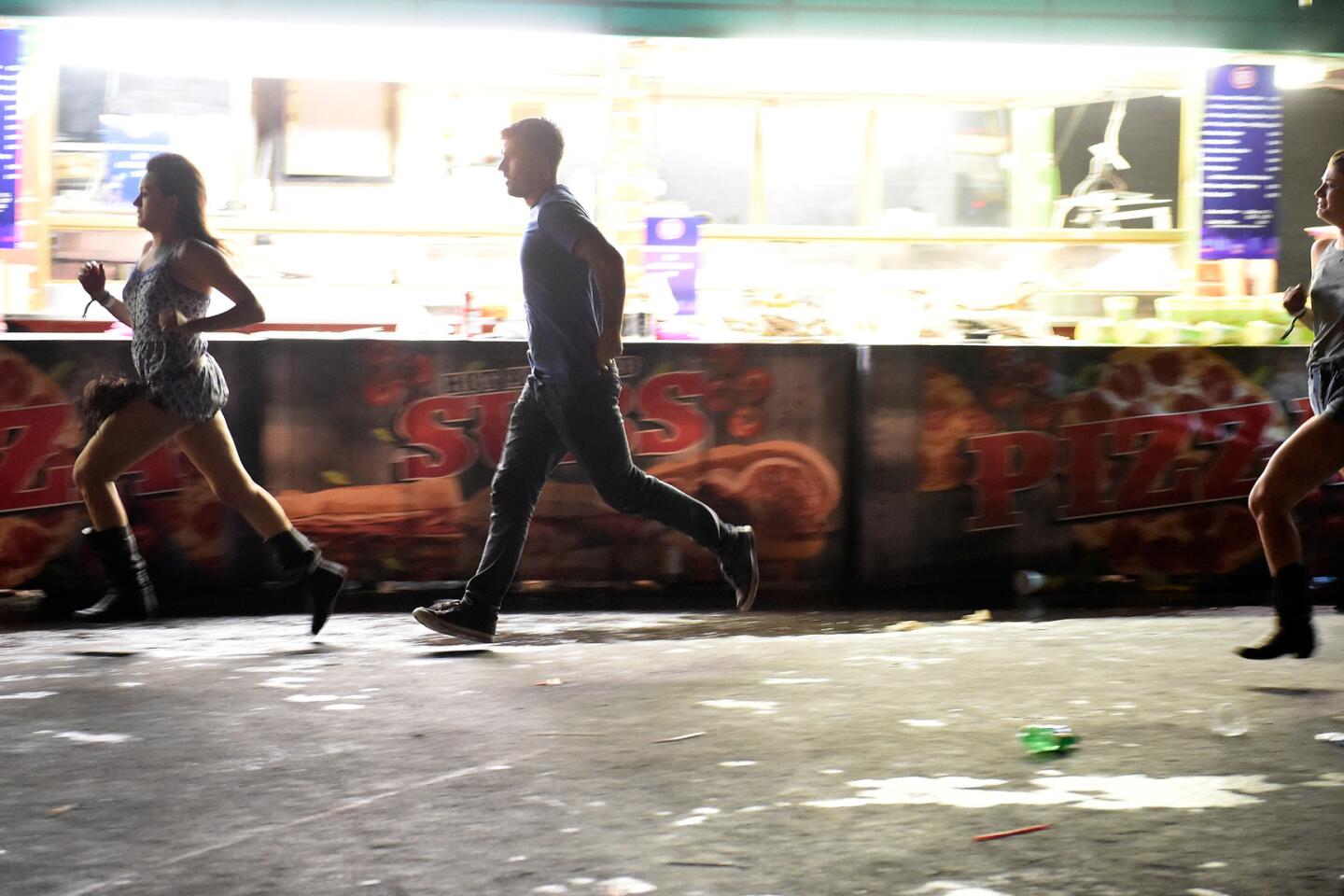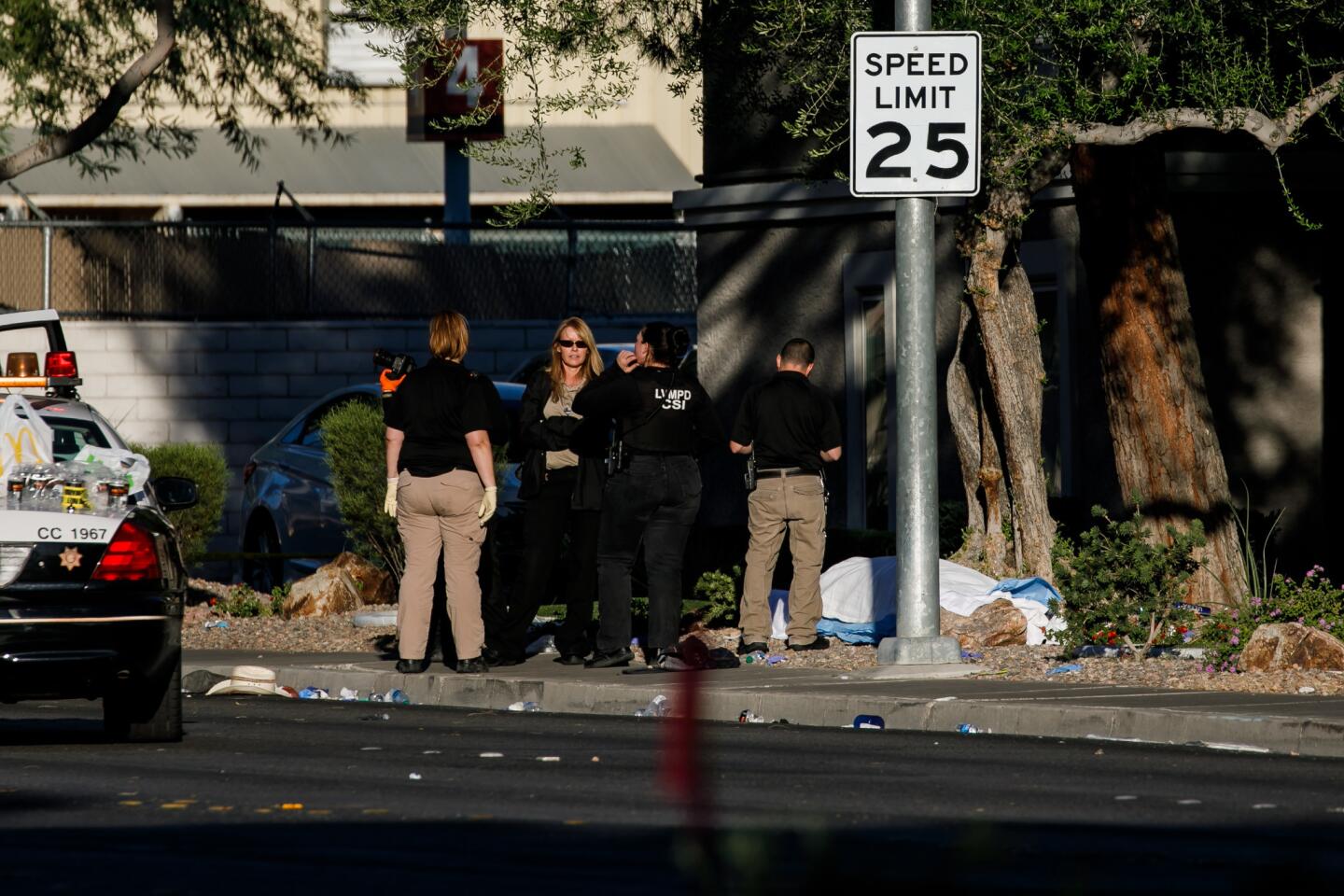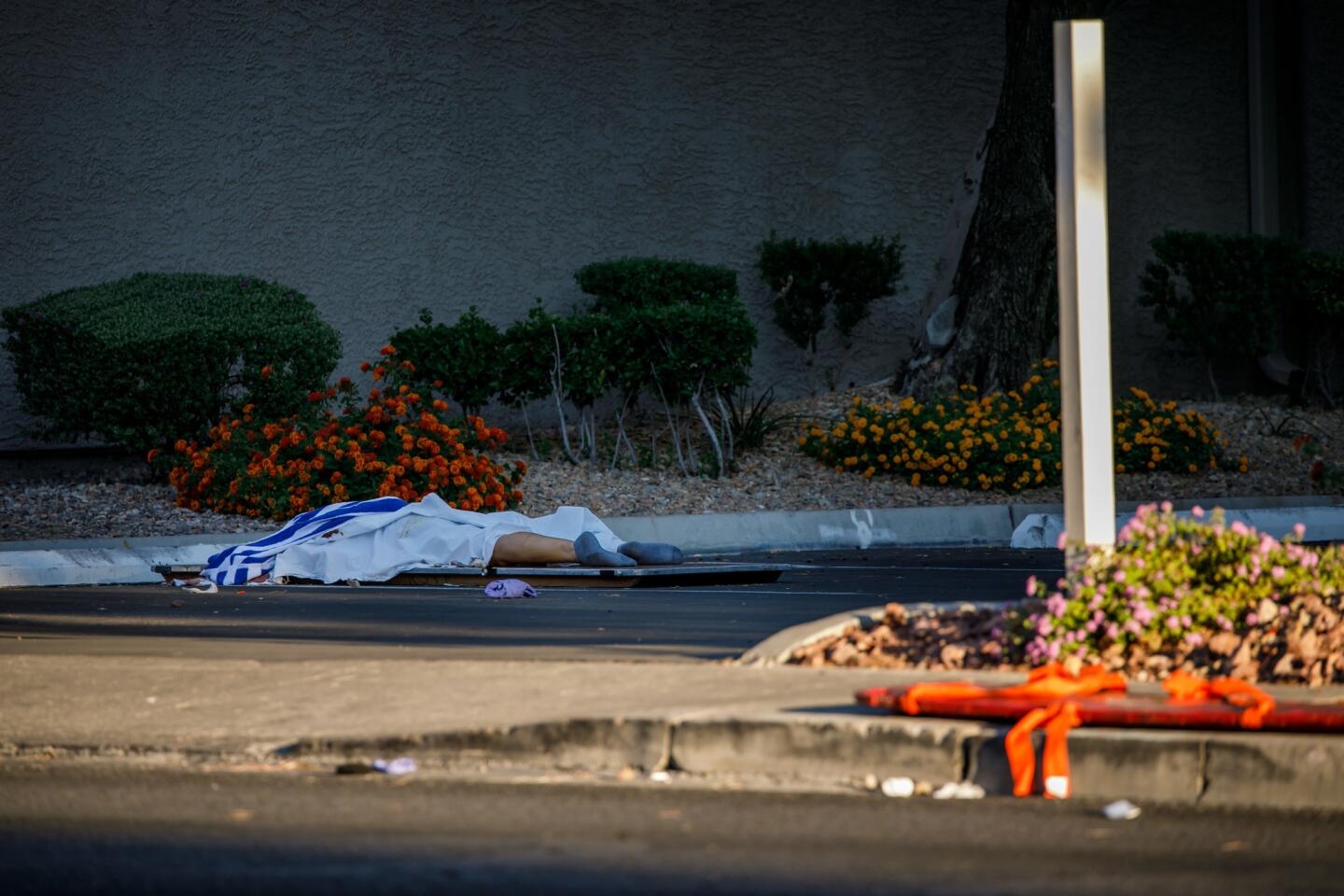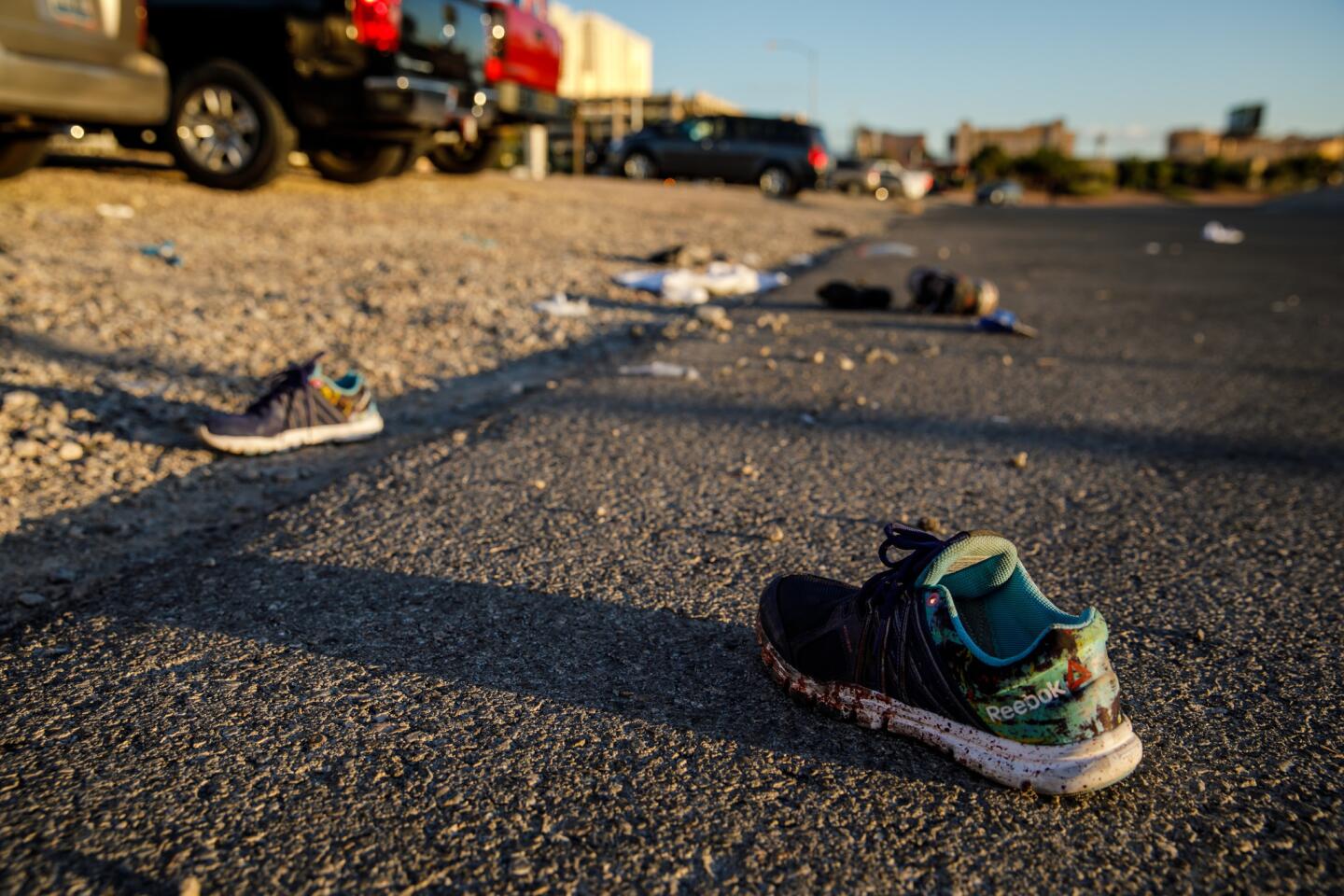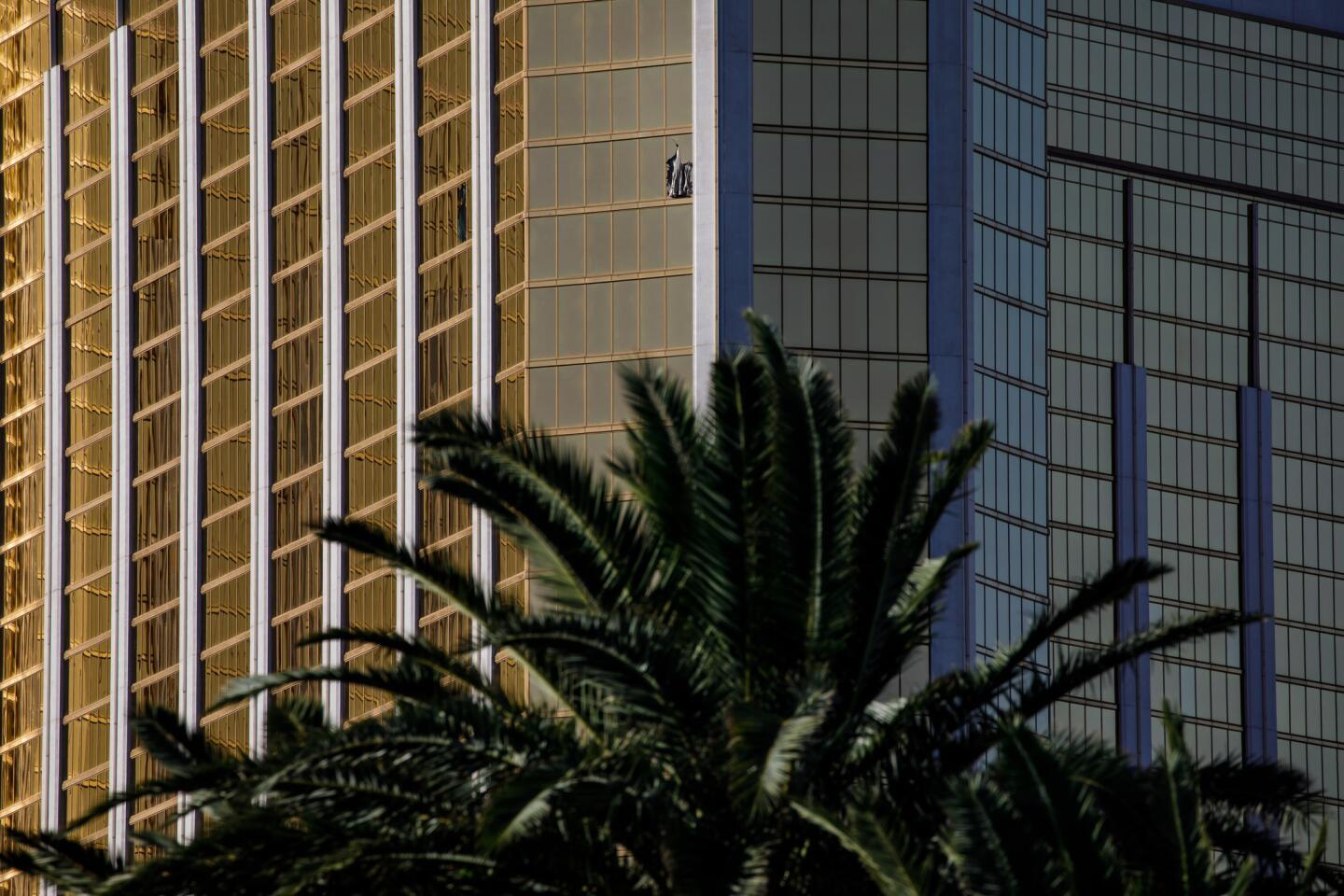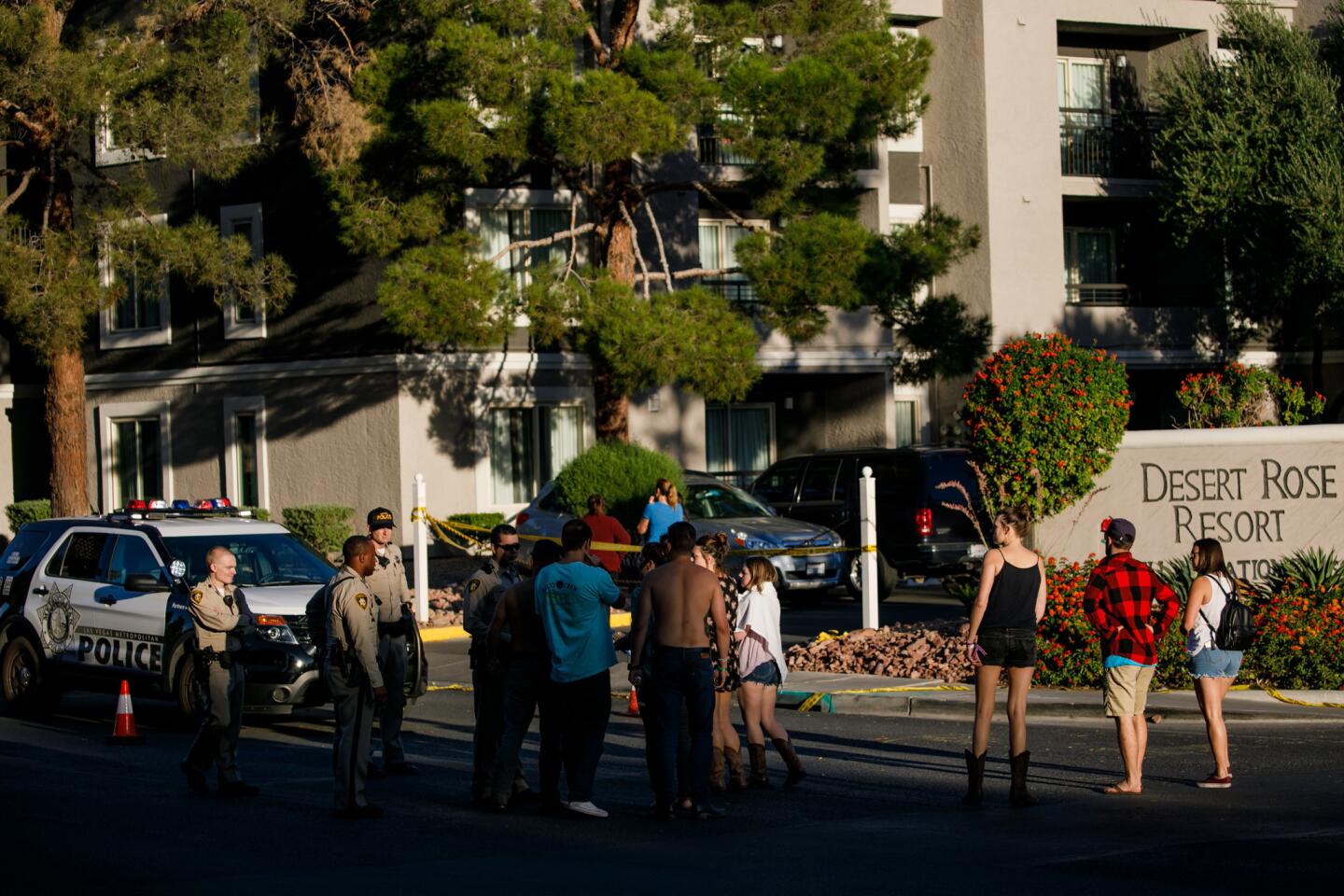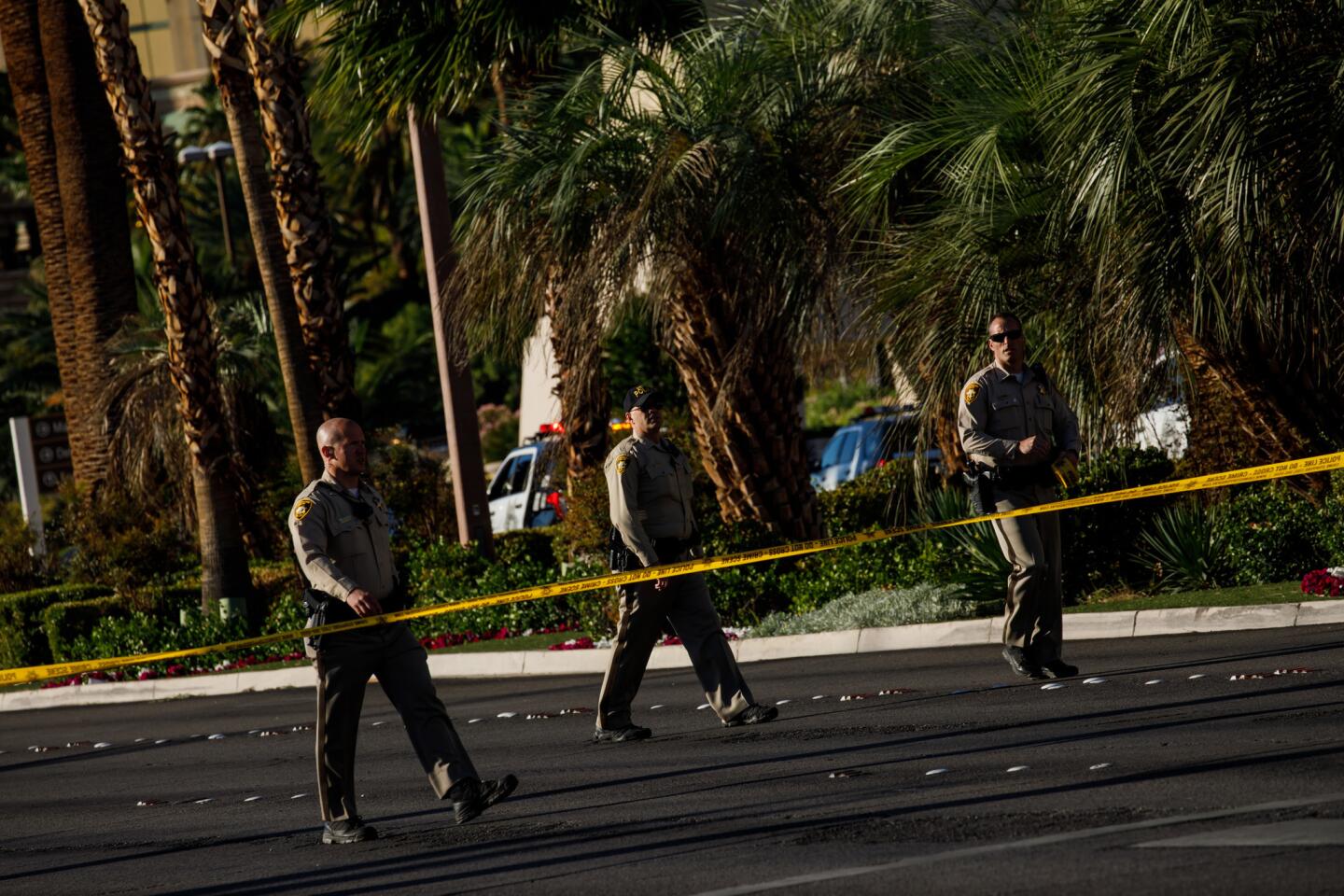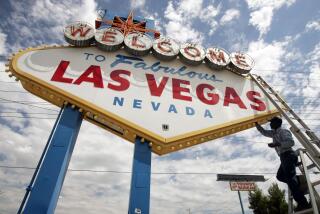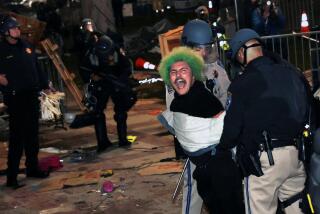He was a quarter of a mile away and a few hundred feet high — the smallest of specks in a boisterous landscape.
They were 22,000 targets in an open field, dodging gunfire on a night when music turned to madness.
Some staked their lives on the shelter of a beer cart, a food truck, a cooler. Those who ran had little sense of direction. Were they racing toward the shots? Would a car, a restaurant, a hotel closet, become refuge or a trap?
The mass shooting at the Route 91 Harvest Festival would leave 58 dead and hundreds more injured.
It would also highlight the vulnerability of those in the focus of a sniper as well as the chilling limitations of responding officers.
Authorities have long discussed the threat of terrorism by a sniper in a crowded area and the reality that there are relatively few tools to prevent or quickly stop such an attack.
Los Angeles police have tried different tactics, including placing sharpshooters on rooftops during the Academy Awards. Earlier this year and for the first time, the LAPD had a police officer in a helicopter shoot a suspect who was firing from the top of a hill.
But replicating those tactics more commonly at open-air events would be costly and in some cases impractical.
Stephen Paddock’s position — a window on the 32nd floor of the Mandalay Bay hotel — gave him “commanding terrain,” said Charles Heal, a retired Los Angeles County sheriff’s commander and special weapons leader.
“There were so many people in his line of fire, he didn’t need to target anyone,” Heal said. He noted that the complexity of a high-rise hotel created a maze for police attempting to track Paddock.
“If you don’t find cover, given his position, he is likely to hit you.”
The scene was sustained by what could be called the trigonometry of terror.
Retired Army Lt. Col. Arthur B. Alphin said Paddock was a patient, well-trained gunner who did not pick and choose his targets, but held to a steady kill zone centered in the middle of thousands of concertgoers.
“He had a huge area of three, four or five football fields with people standing shoulder to shoulder,” said Alphin, who has a mechanical engineering degree and specialized in ballistics.
“He was not aiming at any individual person. He was just throwing bullets in a huge ‘beaten zone.’ ”
Beaten zone is an infantry term dating to World War I. Shaped like the area a searchlight casts across a flat surface, it refers to where bullets can strike. It can move substantially with tiny changes in the tilt of the gun.
From his perch, Paddock was firing down the hypotenuse of a right triangle and would have to adjust his aim for the arc of the bullet — a skill that would require training.
At least one of the 23 weapons found in his hotel room had a bipod stand to hold it steady, authorities said.
Officers on the ground would be virtually ineffective when combating a sniper so far away, said San Marino Police Chief John Incontro, a former LAPD SWAT captain.
“Even if you see the muzzle flash, we are talking officers with pistols,” Incontro said. “Even with rifles, you have a prospect of missing and harming others.”
1/67
People attend a memorial for Las Vegas Police Officer Charleston Hartfield at Police Memorial Park. Hartfield, who was off duty at the music festival, was killed when Stephen Paddock opened fire.
(Robyn Beck / AFP/Getty Images) 2/67
Mourners embrace at a vigil for Las Vegas Police Officer Charleston Hartfield at Police Memorial Park. Hartfield, who was off duty at the music festival, was killed when Stephen Paddock opened fire.
(Ethan Miller / Getty Images) 3/67
Veronica Hartfield, widow of slain Las Vegas Police Officer Charleston Hartfield, and their son Ayzayah Hartfield, 15, attend the vigil at Police Memorial Park.
(Robyn Beck / AFP/Getty Images) 4/67
People attend a tribute to Las Vegas Police Officer Charleston Hartfield, who was killed in the mass shooting Sunday.
(Robyn Beck / AFP/Getty Images) 5/67
Contractor Robert Walker says a prayer after placing flowers and American flag at the scene of a memorial for the victims of the mass shooting on Las Vegas Boulevard near the crime scene.
(Gina Ferazzi / Los Angeles Times) 6/67
Shooting victim Paola Bautista, 39, right, of Fontana with her sister Daisy, 34, recounts her experience of running and hiding once they heard gunshots while attending the country music festival. Bautista was shot in the forearm and will require additional surgeries. She and her sister hid in a maintenance trailer for more than 3 hours.
(Gina Ferazzi / Los Angeles Times) 7/67
Kaili Berdge of Scottsdale, Ariz. makes sure every candle stays lit at a memorial for the victims of the mass shooting near the crime scene .
(Gina Ferazzi / Los Angeles Times ) 8/67
People stop to pay their respects at a memorial for the victims of the mass shooting on the median off Las Vegas Boulevard near the crime scene.
(Gina Ferazzi / Los Angeles Times) 9/67
Connie Lane of Las Vegas holds an American flag with daughter Celestial Olave during a prayer vigil at Mountain Crest Park in Las Vegas.
(Gina Ferazzi / Los Angeles Times) 10/67
People visit a makeshift memorial for shooting victims on Reno Ave and Las Vegas Blvd.
(Marcus Yam / Los Angeles Times) 11/67
Destiny Albers weeps at a makeshift memorial on Las Vegas Blvd. Albers attended the Route 91 Harvest Festival concert during the attack on Sunday night and one of her friends was struck down by gunfire.
(Marcus Yam / Los Angeles Times) 12/67
Workers clean up parts of Las Vegas Blvd outside the crime scene.
(Marcus Yam / Los Angeles Times) 13/67
A prayer vigil in Las Vegas for the victims of the mass shooting.
(Gina Ferazzi / Los Angeles Times) 14/67
Matthew Edwards lights candles at a makeshift memorial at Sahara Avenue and Las Vegas Boulevard in Las Vegas for the victims of the mass shooting.
(Marcus Yam / Los Angeles Times) 15/67
Firefighters and paramedics bow their heads in prayer during a vigil for the victims of the mass shooting at Mountain Crest Park in Las Vegas.
(Gina Ferazzi / Los Angeles Times) 16/67
Manhattan Beach Police Chief Eve Irvine, left, consoles police employee Sayeh Kahn after a news conference about the death of police records technician Rachael Parker in the Las Vegas shooting.
(Wally Skalij / Los Angeles Times) 17/67
In the presence of her family, Carmen Alegria recounts her harrowing experience escaping the mass shooting that killed 59 and injured more than 520 at the Route 91 Harvest festival in Las Vegas.
(Marcus Yam / Los Angeles Times) 18/67
Matthew Edwards gets a hug from a passerby as he lights candles at a makeshift memorial for the victims of the Las Vegas mass shooting.
(Marcus Yam / Los Angeles Times) 19/67
People gathered for a candlelight vigil at Town Square in Las Vegas to remember those killed and injured in the mass shooting.
(Gina Ferazzi / Los Angeles Times) 20/67
University of Nevada, Las Vegas, students observe a moment of silence for the victims of the mass shooting.
(Marcus Yam / Los Angeles Times) 21/67
University of Nevada, Las Vegas, students attend a candlelight vigil for the shooting victims.
(Marcus Yam / Los Angeles Times) 22/67
A candlelight vigil at Town Square in Las Vegas to remember the shooting victims.
(Gina Ferazzi / Los Angeles Times) 23/67
UNLV students pick up candles for a vigil for the victims of the mass shooting in Las Vegas.
(Marcus Yam / Los Angeles Times) 24/67
Rep. Ruben Kihuen (D-Nev.) hugs clergy members as they lead the Guardian Angel Cathedral congregation for a prayer event to honor the victims of the mass shooting.
(Marcus Yam / Los Angeles Times) 25/67
Members of the Guardian Angel Cathedral congregation embrace after a prayer event to honor the victims of the mass shooting in Las Vegas.
(Marcus Yam / Los Angeles Times) 26/67
People attend a candlelight vigil at Las Vegas City Hall for the victims of the mass shooting.
(Robyn Beck / AFP/Getty Images) 27/67
Clark County Sheriff Joe Lombardo updates the toll from the mass shooting to 59 killed and 527 injured during a news conference Las Vegas.
(Gina Ferazzi / Los Angeles Times) 28/67
Susan Stafford, left, of Media Fellowship International consoles a resident in prayer after the mass shooting in Las Vegas.
(Gina Ferazzi / Los Angeles Times) 29/67
Relatives of victims from the mass shooting embrace outside a family assistance center in Las Vegas.
(Marcus Yam / Los Angeles Times) 30/67
Flowers are left behind for victims of the mass shooting in Las Vegas.
(Marcus Yam / Los Angeles Times) 31/67
Tourists visit the crime scene, cordoned off by officials as the investigation of the mass shooting continues in Las Vegas.
(Marcus Yam / Los Angeles Times) 32/67
People run from the Route 91 Harvest country music festival after hearing gunfire Sunday night in Las Vegas. The shooter was firing from the Mandalay Bay Resort and Casino.
(David Becker / Getty Images) 33/67
Las Vegas police work on a street outside the grounds of the Route 91 Harvest country music festival in Las Vegas on Sunday night.
(David Becker / Getty Images) 34/67
Drapes billow from broken windows Monday at the Mandalay Bay Resort and Casino on the Las Vegas Strip. Police say gunman Stephen Paddock targeted festival-goers from the resort and was found dead inside a hotel room.
(John Locher / Associated Press) 35/67
President Donald Trump, First Lady Melania Trump, Vice President Mike Pence and his wife, Karen, participate in a moment of silence on the South Lawn of the White House for victims of the Las Vegas mass shooting.
(Saul Loeb / AFP / Getty Images) 36/67
President Donald Trump makes a statement about the mass shooting in Las Vegas.
(Evan Vucci / Associated Press) 37/67
Clark County Sheriff Joseph Lombardo gives a news update early Monday on the mass shooting at a country music festival. Authorities say at least 58 people are dead and more than 500 injured.
(Marcus Yam / Los Angeles Times) 38/67
A man lays on top of a woman as others flee the Route 91 Harvest country music festival grounds after a active shooter was reported on Sunday in Las Vegas.
(David Becker / Getty Images) 39/67
People lie on the ground at the Route 91 Harvest country music festival after a gunman targeted the event from a nearby upper-story hotel room.
(David Becker / Getty Images) 40/67
A wounded person is transported on a wheelbarrow as authorties respond during a mass shooting on the Las Vegas Strip on Sunday.
(Chase Stevens / Associated Press) 41/67
People take cover at the Route 91 Harvest country music festival after hearing gunfire Sunday night in Las Vegas. The shooter was firing from the nearby Mandalay Bay Resort and Casino.
(David Becker / Getty Images) 42/67
People run and take cover at the Route 91 Harvest country music festival after hearing gunfire.
(David Becker / Getty Images) 43/67
People tend to the wounded outside the festival grounds after the mass shooting late Sunday.
(David Becker / Getty Images) 44/67
A man in a wheelchair is taken away from the Route 91 Harvest country music festival after gunfire was heard.
(David Becker / Getty Images) 45/67
People run for cover at the Route 91 Harvest country music festival after a shooter targeted the event from Mandalay Bay Resort and Casino.
(David Becker / Getty Images) 46/67
People carry a person at the Route 91 Harvest country music festival after gunfire was heard in Las Vegas.
(David Becker / Getty Images) 47/67
People run from the Route 91 Harvest country music festival after the event was targeted by a gunman shooting from a nearby hotel.
(David Becker / Getty Images) 48/67
People tend to the wounded outside the festival grounds after a shooting near the Mandalay Bay Resort and Casino.
(David Becker / Getty Images) 49/67
People hug and seek cover at the Route 91 Harvest country music festival as the shooting scene unfolds in Las Vegas.
(David Becker / Getty Images) 50/67
A cowboy hat lays in the street late Sunday after gunfire hits a country music festival in Las Vegas.
(David Becker / Getty Images) 51/67
A woman sits on a curb at the scene of the shooting outside of the Route 91 Harvest country music festival along the Las Vegas Strip.
(John Locher / Associated Press) 52/67
A man takes cover at the Route 91 Harvest country music festival.
(David Becker / Getty Images) 53/67
Police officers advise people to take cover near the scene of the mass shooting near Mandalay Bay on the Las Vegas Strip.
(John Locher / Associated Press) 54/67
Medics treat people injured in a mass shooting on the Las Vegas Strip on Sunday.
(Chase Stevens / Associated Press) 55/67
People take cover from the Route 91 Harvest country music festival after hearing gunfire Sunday night in Las Vegas. The shooter was firing from the nearby Mandalay Bay Resort and Casino.
(David Becker / Getty Images) 56/67
Police run to cover at the scene of a shooting near the Mandalay Bay resort and casino on the Las Vegas Strip.
(John Locher / AP) 57/67
A police officer takes cover behind a police vehicle during a shooting near the Mandalay Bay Resort and Casino on the Las Vegas Strip.
(John Locher / AP) 58/67
A gropu carries a person at the Route 91 Harvest country music festival after a mass shooting by a gunman from a nearby hotel.
(David Becker / Getty Images) 59/67
A police officer runs along a sidewalk on the Las Vegas Strip late Sunday.
(John Locher / Associated Press) 60/67
Las Vegas police sweep through a convention center area at the Tropicana Las Vegas, during a lockdown following an active shooter situation on the Las Vegas Strip.
(Chase Stevens / Associated Press) 61/67
People run from the country music festival, which was targeted by a gunman.
(David Becker / Getty Images) 62/67
Crime scene investigators stand by a body along Las Vegas’ Reno Avenue on Monday morning, in the aftermath of the mass shooting that left at least 58 dead and more than 500 injured.
(Marcus Yam / Los Angeles Times) 63/67
A body lays covered in the driveway of the Desert Rose Resort on Reno Avenue on Monday morning after the mass shooting the night before.
(Marcus Yam / Los Angeles Times) 64/67
Personal items covered in blood sit are discarded on Koval Lane.
(Marcus Yam / Los Angeles Times) 65/67
A curtain blows out of a broken window at the Mandalay Bay Resort and Casino, from where a gunman targeted a a country music festival across the street on the Las Vegas Strip on Sunday night.
(Marcus Yam / Los Angeles Times) 66/67
Law enforcement officers cordon off a crime scene on Reno Avenue on Monday after a gunman opened fire from an upper story of the Mandalay Bay hotel on a nearby country music festival the night before.
(Marcus Yam / Los Angeles Times) 67/67
Law enforcement officers in Las Vegas on Monday cordon off a crime scene after a gunman opened fire from an upper story hotel room on a country music festival the night before.
(Marcus Yam / Los Angeles Times) Experts believe the Las Vegas massacre will force a shift in the paradigm for policing outdoor events. Locations will be vetted for quick escape routes for large crowds. Event organizers might be asked to have materials on hand that could become a makeshift fence. Tactical plans could be drawn up for areas such as L.A. Live where skyscrapers loom.
Los Angeles police currently station counter-snipers at open-air events, but the tactic is used sparingly and only for major affairs, such as award shows. A counter-sniper would have to be positioned higher than the shooter.
After a five-hour standoff with a gunman in Sunland, Los Angeles police were ordered to fire from a helicopter. The man was at the top of the hill in a house and had been difficult for responding officers to reach. Chief Charlie Beck said the decision to employ the tactics was made at the highest levels of the department.
It’s not clear if that approach would have been effective in a situation like Las Vegas.
“You have to get pretty close for that shot,” said Incontro, adding that a sniper could also be compelled to shoot at the helicopter, possibly forcing it into the ground.
Paddock’s plan of attack was similar to that of Charles Whitman, a former Marine sharpshooter who opened fire from a tower at the University of Texas at Austin in 1966.
Whitman, who lost his scholarship to the school a few years earlier, had taken an elevator to the 27th floor, where he hauled rifles up two flights of stairs to the observation deck. Sixteen people were killed.
Paddock was at an even higher distance and armed with weapons modified to rapidly fire when he began his relentless attack on the crowd below.
He was able to create a setting similar to that of a battlefield, said James Allen Fox, a Northeastern University criminologist who researches mass killings.
Those watching country singer Jason Aldean perform Sunday night dismissed the initial gunshots as firecrackers.
Then bodies began to drop.
“We’ve got to go!” Jared Birnbaum heard his girlfriend say before she disappeared in the chaos.
He scrambled to an exit only to be stopped by a police officer redirecting the mob. Birnbaum then dove under nearby bleachers, joining hundreds of others.
By then, the 30-year-old was covered in blood — most of it from other people — and hearing talk of multiple shooters. He feared being taken hostage in what felt like a fishbowl of raining bullets.
“All you could do is duck and put your hands behind your head,” he said, “and hope you’re not one of the ones to go.”
[email protected]
[email protected]
[email protected]
[email protected]
Times staff writer Kate Mather contributed to this report from Las Vegas.
ALSO
Las Vegas shooting victims: Portraits of the fallen
Police say they are trying to determine whether Las Vegas gunman acted alone
The frantic, bloody hours in a Las Vegas hospital as doctors rushed to save lives

